The Environment
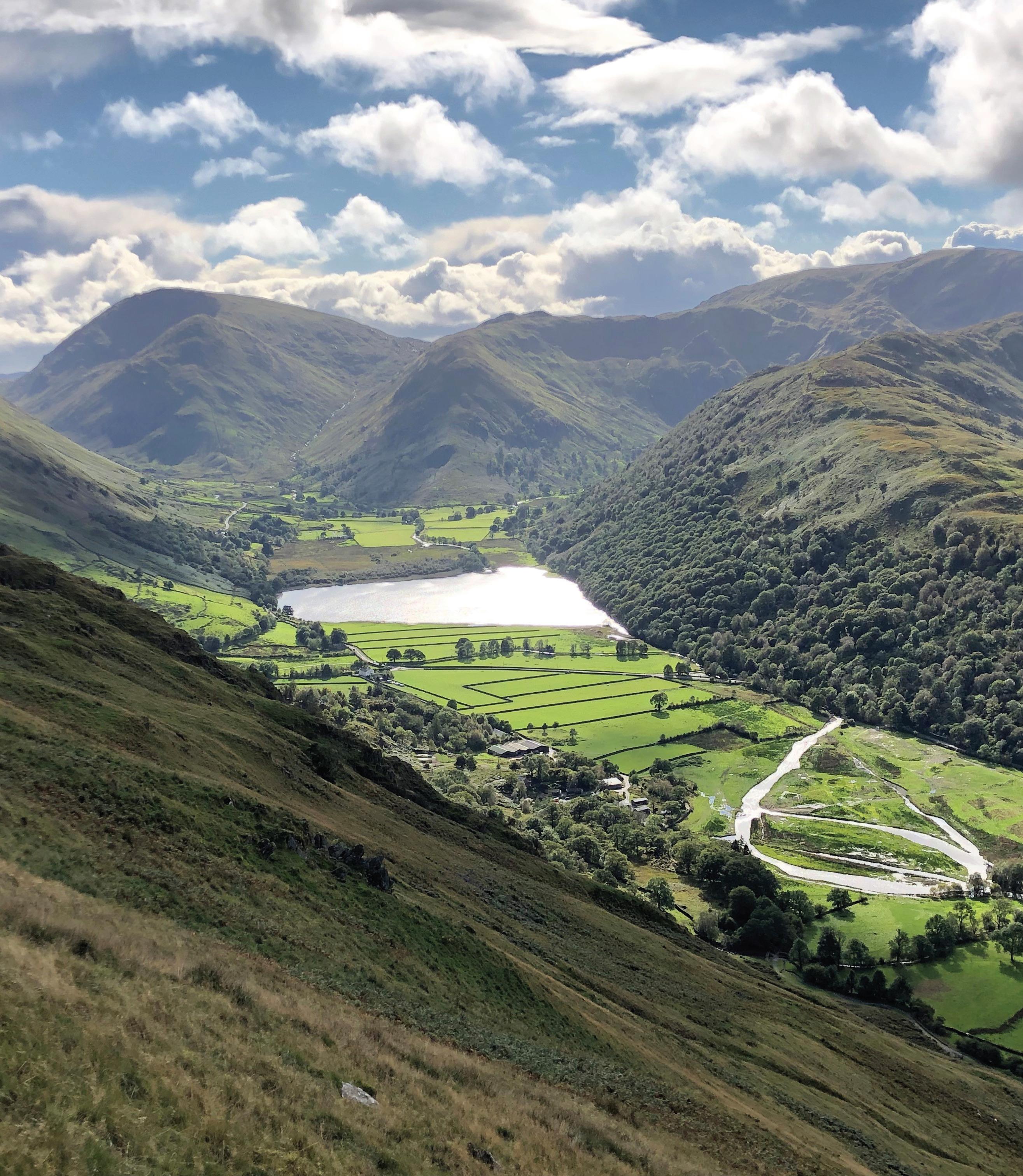
THE MAGAZINE FOR THE CHARTERED INSTITUTION OF WATER AND ENVIRONMENTAL MANAGEMENT June 2023 REWIGGLE IT RESTORING GOLDRILL BECK 08 COVER STORY Rewilding our rivers 36 SuDS Lessons from Wales 12 INTERVIEW EA chair Alan Lovell 16 QUIZ Which SuDS superhero are you? 32 FLOOD RISK Let it RAIN





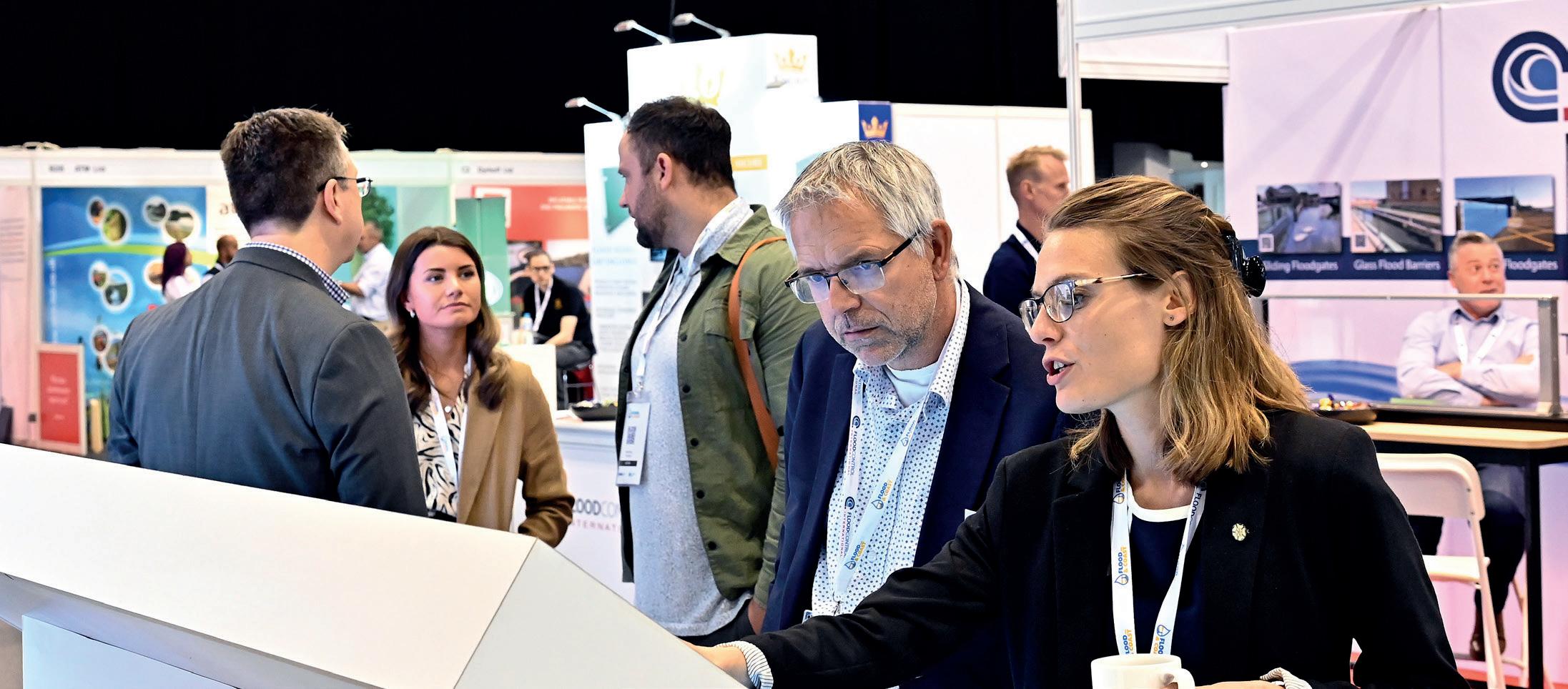



What to expect from Flood & Coast 2023: For additional information please contact: 6th - 8th June | Telford International Centre Produced by Strategic Partners info@floodandcoast.com www.floodandcoast.com Thank you to our Sponsors • World-class three-day conference agenda • Innovation Hub • Early Careers & Education Zone • Networking Lounge • 100 exhibitors providing the latest innovations/ industry solutions • Free workshops and networking events • Property Flood Resilience training • Women in FCERM • Flood & Coast Excellence Awards Dinner • And many more! Secure your pass: www.floodandcoast.com
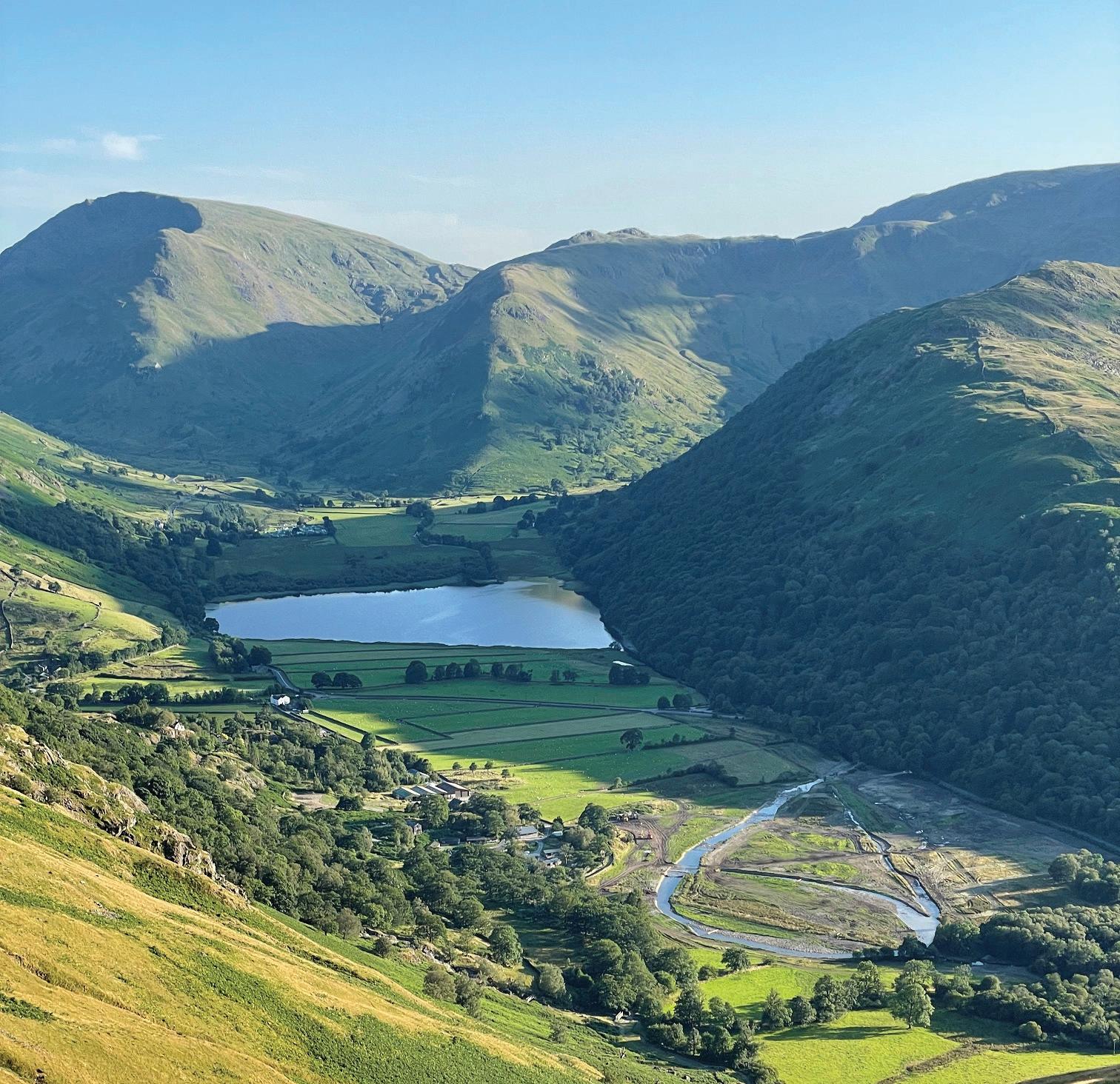

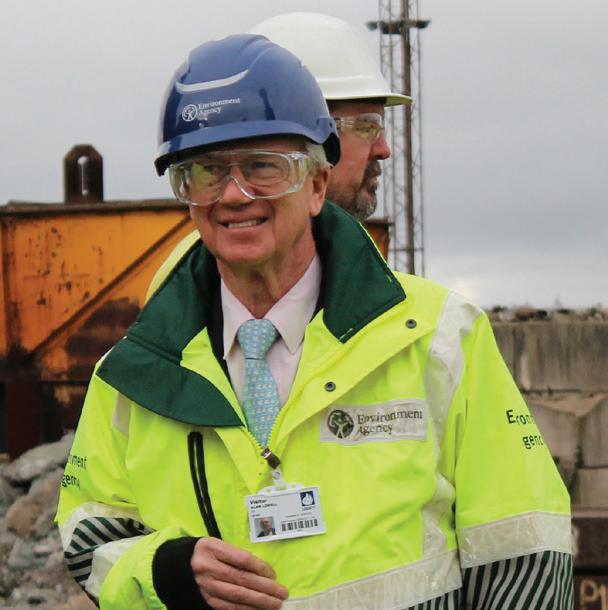
Youth climate and Māori activist Te Aomihia Walker explains how New Zealand’s worst cyclone on record
“We’re
What kind of SuDS superhero are you?
Last year’s devastating floods in Pakistan and Nigeria drew news crews from around the world. But what happened after the cameras moved on to disasters new? Owen Duffy reports
The Red Cross Red Crescent Climate Centre is harnessing climate data to make communities around the world more resilient. Climate-risk advisor Roop Singh explains how
What do water-smart communities look like? CIWEM is working on a pilot project that aims to find out. Ky Trickett reports
Painting change – art, environment, mental health and me. Glasgow-based Ally Zlatar explores climate change, pollution and anxiety through her art
A Northampton pilot project is introducing natural flood management upstream and helping owners of homes and businesses to adapt to climate risk downstream. Karen Thomas reports
Many properties along the River Severn now flood every year, which makes property flood protection a must-have, argues Mary Long-Dhonau
Wales made sustainable drainage schemes mandatory in 2019. As England follows suit, what can it learn from its neighbours? Ian Titherington reports
Expect to hear a lot about SuDS at Flood & Coast. Why? Kirsty Tolson fills in the blanks
Stories about polluted rivers are coming thick and fast. How do we unpack the problem, asks CIWEM policy director Alastair Chisholm
Meet the Flood & Coast speakers
Meet our seven movers and shakers from CIWEM’s Rivers and Coastal Group
CIWEM boosts its membership team
03 Contents 12 06 08 COMMENT LAST WORD MY ENVIRONMENT NFM FLOOD & COAST ARTS OPINION RESILIENCE SUDS INTERNATIONAL CIWEM NEWS 05 Letter from the editor 54 06 08 12 14 16 28 23 32 42 44 47 52
chief executive Terry Fuller is counting down to this year’s flood family reunion
CIWEM
her
coast community
Thomas visits an award-winning river-rewiggling project in the Lake District that also protects communities downstream from flood risk
has affected
east
Karen
facing some really difficult decisions” – Environment Agency chair Alan Lovell sets the agenda for this year’s conference
waterbodies
integrated approach,
Rivers
chief executive Mark
Healthier
demand an
says
Trust
Lloyd
Association
Take our fun quiz by the
of SuDS Authorities to find out
IMAGE: NATIONAL TRUST/JONATHAN HOLDSWORTH
COVER
36 40 35 18 21
Engineering a sustainable future
Mackley refurbished seven weirs on the River Wey for the Environment Agency which included installing fish passes designed to improve fish stocks while reducing the risk of flooding.
Mackley is a civil engineering contractor with 90 years’ experience of innovative engineering for our core business sectors.
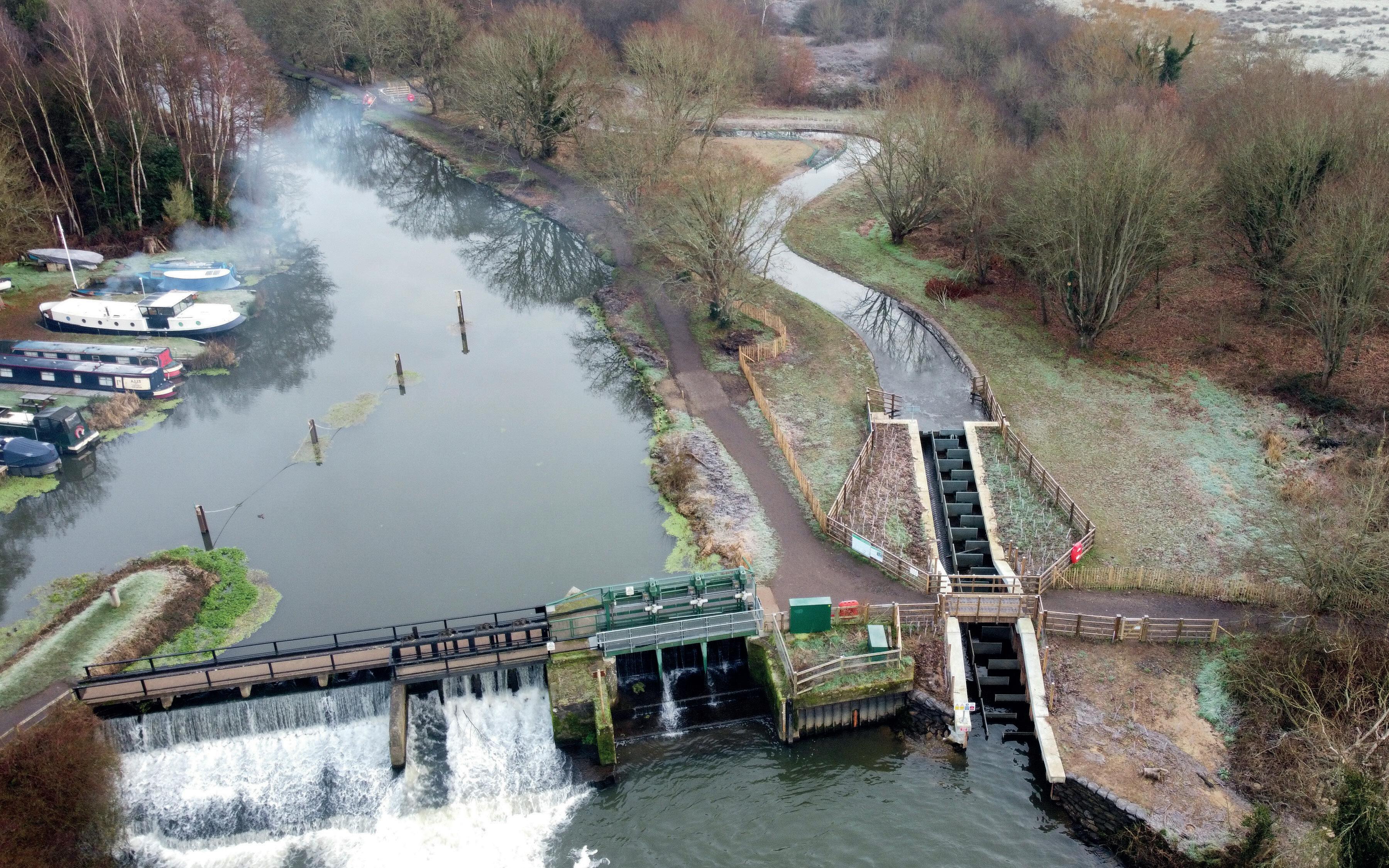
We work within the most environmentally sensitive locations in the UK. Our teams bring the engineering skills to tailor designs and construction methods so we protect the environment and provide expertise in low carbon approaches, natural flood management and biodiversity enhancements.
We offer: Construction, ECI, design management, value engineering, emergency flood response, environmental mitigation and stakeholder management - delivering projects either as a Tier 1 lead contractor or as Tier 2 supply chain partner.
www.mackley.co.uk
construct@mackley.co.uk 01273 492 212
V I AL
FL U
CIWEM
106-109 Saffron Hill, London
EC1N 8QS
Tel: +44(0)20 7831 3110
Fax: +44(0)20 7405 4967 admin@ciwem.org www.ciwem.org
Registered Charity No: 1043409
EDITOR
Karen Thomas +44(0)20 7269 5809 karen.thomas@ciwem.org
ADVERTISING
Lee Morris +44 (0)203 900 0102 ciwem@syonmedia.com
PARTNERSHIPS MANAGER
Jane Boland +44(0)20 7269 5820 pr@ciwem.org
PUBLICATIONS MANAGER
Victoria Harris +44(0)20 7831 3110 publications@ciwem.org
PRESIDENT Steve Thompsett president@ciwem.org
CHIEF EXECUTIVE
Terry Fuller terry.fuller@ciwem.org
SYON MEDIA LTD
Unit 3, Boleyn Business Suite Hever Castle Golf Club Hever Road Hever, Kent TN8 7NP +44(0)20 3900 0145 www.syonmedia.com
ART EDITOR
Becca Macdonald becca@syonmedia.com
Copyright of editorial content is held by the Chartered Institution of Water and Environmental Management (CIWEM).
Reproduction in whole or part is forbidden except with the express permission of the publisher.
Data, discussion and conclusions developed by authors in this publication are not intended for use without independent substantiating investigation on the part of potential users. Opinions expressed are those of the authors and are not necessarily those of Syon Publishing, the Chartered Institution of Water and Environmental Management (CIWEM) or any servants of those organisations. No responsibility for loss suffered by any person acting or refraining from acting as a result of the material contained in this publication will be accepted by Syon Publishing, CIWEM or its associated organisations.
The Environment magazine, printed by Stephens & George on Woodforce Silk, is accredited with FSC stock certification, which certifies the timber source originates from legal and sustainable forests. The Environment magazine uses vegetable inks formulated from renewable sources and has an Aqueous seal on the cover. ISO 14001: 2004 Environmental Management.
Chartered Institution of Water and Environmental Management
Flooding – we need to talk

THIS MONTH, DELEGATES gather in Telford for the annual Flood & Coast conference and exhibition, owned by CIWEM and co-hosted this year with partners the Environment Agency, the Rivers Trust and the Association of SuDS Authorities.
Flood & Coast reunites flood planners, protectors and practitioners. The ClimateChange Committee says flooding is the UK’s most pressing climate challenge. But every year, at some point, discussion turns to how we talk to people about risk.
Most people know that our coasts are shrinking, that our riverbanks burst more often with climate change. But how many outside the flood family understand their personal climate risk?
A sobering report from British Red Cross found that four out of five of us have no idea where to find flood-risk information or what to do when flooding strikes. Three-quarters of us don’t understand our community’s own flood risk. One in seven has no home or contents flood insurance. Half of those households blame the cost-of-living crisis.
That’s disturbing. We already live with flood risk. British Red Cross says that in the UK, 1.9 million people live in areas prone to flooding – and climate change will double that number in the next 30 years.
It’s something CIWEM’s flood family must address at this month’s conference. We need to talk more clearly about risk, to support people, to empower everyone, whatever their resources, to protect the people and places they love.
How? By making flood-risk data and mapping easier to understand. By offering extra support for the people and places most exposed to risk. By tailoring flood messages to target communities. And by helping people to access the cover and the practical advice they need.
That includes property flood resilience – ways to adapt buildings to repel floods and recover faster afterwards.
Campaigner Mary Long-Dhonau is driving her flood mobile to Telford to show how we can adapt our homes. The Scottish Flood Forum expects to get its own flood mobile soon. Rumour has it England is to roll out more flood mobiles, “if the business case allows”. Flood mobiles show communities how to manage and adapt to climate risk.
But none of us can do it alone. Agencies and businesses, charities and community groups, flood-protection experts and climate modellers must work together to spread the word.
See you in Telford.
 Karen Thomas Editor, The Environment @KT_environment
Karen Thomas Editor, The Environment @KT_environment

05
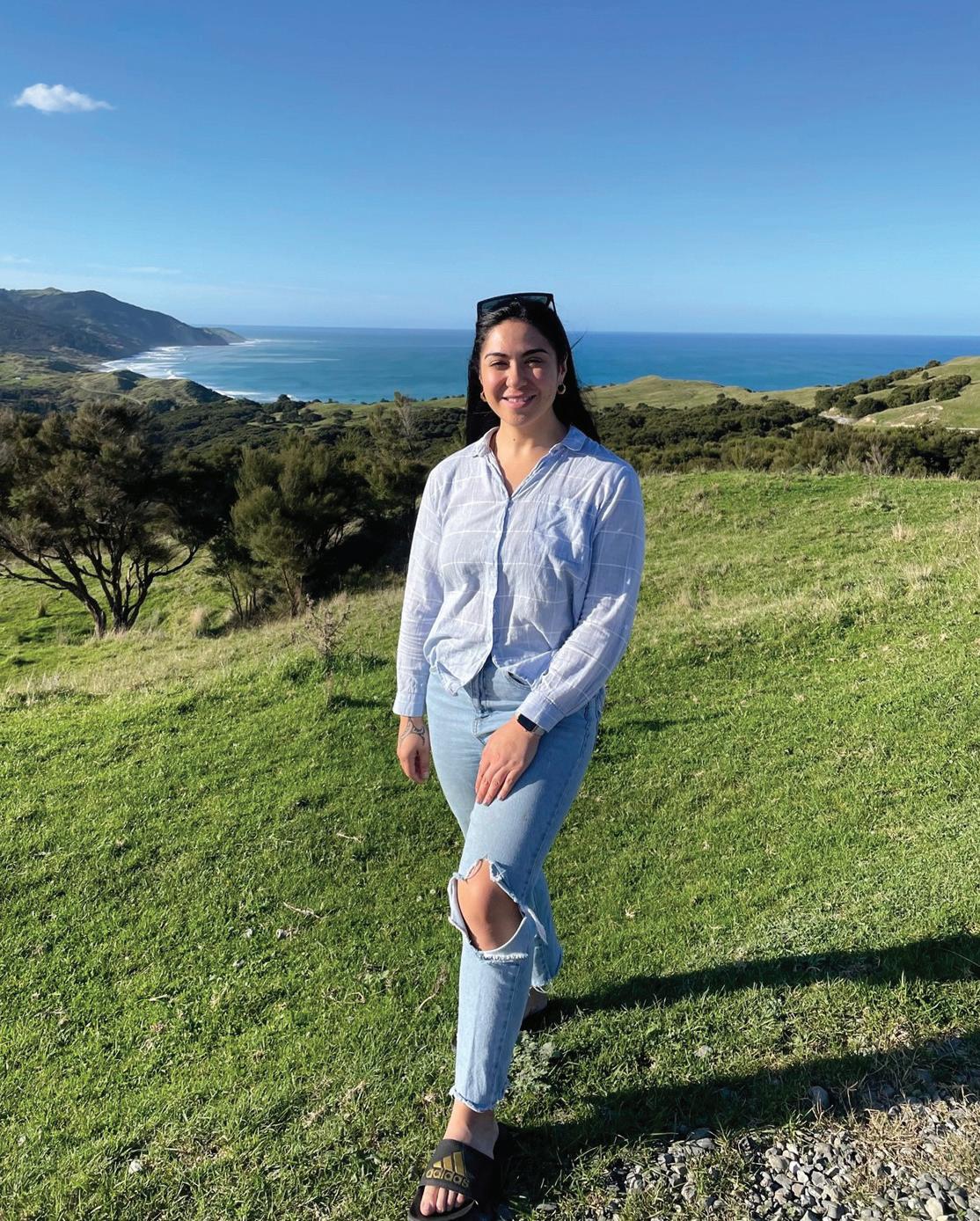
My environment:TE AOMIHIA WALKER
Te Aomihia Walker is a Māori youth activist, marine biologist, fisheries advisor, Sue Taei Ocean Fellow and Arctic Angel. Her community in Aotearoa (New Zealand) was one of the hardest hit during the severe tropical Cyclone Gabrielle in February
Te Aomihia Walker comes from the Māori Indigenous tribe of Ngāti Porou on the North Island’s east coast. She lives in the coastal city of Tūranga-nui-a-Kiwa (Gisborne). New Zealand has some 90,000 Ngāti Porou people, 17 per cent of whom live within the tribal region that Cyclone Gabrielle ripped through in February. Ngāti Porou communities had already endured more than a year of storms and floods before Cyclone Gabrielle hit.
Cyclone Gabrielle was the costliest tropical cyclone recorded in the Southern Hemisphere and the deadliest to hit Aotearoa since 1968. A quarter of a million homes lost power. The storm cut supplies of water and power to families and businesses across the North Island for several days. Some 10,000 people were displaced. Total damage is estimated at US$8.4 billion, with just US$730 million insured.
Walker spoke to The Environment two weeks after the storm.
TE AOMIHIA, HOW ARE YOU?
We’re slowly moving into the recovery phase. Tens of thousands of people were displaced. Flooding trapped people on their roofs. We had landslides that destroyed homes, highways and infrastructure, that left communities unreachable. The floodwater carried mud, trees, debris and waste. Communications were cut off in my town for about a week.
New Zealand declared a national emergency for just the third time in its history because of the scale of the damage from Gabrielle. Some areas had more than 65 tonnes of rain in six hours.
My people in the rural areas have been hit by eight events this last year, with power outages across the region – eight supposed once-in-a-century events. Our built infrastructure can’t cope with these kinds of extremeweather events. It’s been disastrous. My community and the wider region expect the intergenerational, cultural, social, environmental and economic impacts from this to last for decades.
HOW IS THIS AFFECTING MĀORI PEOPLE?
New Zealand’s media and the general population focus on impacts on infrastructure and industry. But for Māori communities, this also impacts our physical and spiritual wellbeing. These are our ancestral lands and waters – our sacred sites, cemeteries and community areas that support our cultural practices.
Along the east coast, many culturally significant sites are in exposed, erosionprone, low-lying coastal areas or river valleys. Many Māori settlements on vulnerable, deforested land are facing one-in-100-year storms every six months. That’s forcing us to have serious conversations about relocating from land and water we have occupied and looked after for centuries.
This will impact us physically and ecologically; we have whakapapa, ancestral ties, to these places. Māori face further economic, social and health disparities in Aotearoa as a result of colonialism, treaty breaches and dispossession of land. Climate impacts are widening the gap, putting pressure on iwi and hapu – Māori tribes and sub-tribes – to identify and address the greatest threats we face.
06
TE AOMIHIA WALKER
TELL US ABOUT YOURSELF
My tribe is descended from the Polynesian demi-god Māui – who you’ll know from the film Moana – renowned for voyaging down to the South Pacific and fishing up the North Island. Our ancestral bond to these lands and oceans is inherent to our identity – climate change is putting that relationship at risk.
My parents instilled in me strong Māori cultural values. Their generation fought hard to teach the Māori language in schools; to recognise our rights as Indigenous peoples and tribes in New Zealand’s legal system.
Although I was born in the city, we kept strong ties to the coast and moved back here when I was eight. Knowing we are ocean people inspired me to major in marine biology and statistics.
This spring, I launched my own environmental consultancy. Before, I was a fisheries-policy analyst at Te Ohu Kaimoana, established from a 1992 settlement, which protects and enhances Māori customary fishing rights across the country.
I’ve attended fisheries meetings across the western and central Pacific. In 2021, I landed a fellowship with Conservation International, created to support young, Indigenous women of the Pacific. I was the first fellow from Aotearoa and the first Indigenous person to join the UNESCO GRÓ Fisheries Training Programme in Iceland for six months. Conservation International helped me to join a panel at the October 2021 Arctic Circle conference, looking at how Indigenous knowledge can tackle climate change. That’s how I became an Arctic Angel. I highlight the interconnectedness between what’s happening here in my home and melting ice sheets in the Arctic and Antarctic.
ARE YOU AN ENVIRONMENTALIST?
relationship. We are kaitiaki, guardians, who must care for and protect the mauri, life force, of our environment and use resources sustainably for current and future generations, within a strict, culturally principled framework.
Only a third of people of the tribe of Ngāti Porou still live in the region we’re from. But we are coastal people; the ocean formed a huge part of our livelihoods. Even today, we maintain that interrelationship: fishing, diving, voyaging, swimming, surfing and paddling. We practice customary management measures such as rāhui, to temporarily close areas to let fish stocks recover.

to make constant, conscious choices about how I live. I follow the Māori lunar calendar to understand the best times to sow, harvest or conserve energy. We take only what we need to feed ourselves. I do my best to buy more sustainable products and avoid plastics.
But I’m also very conscious that choice is a privilege that so many people do not have. Since the cyclone, so many people are struggling to survive, to navigate what sustainability looks like in a world of climate impacts.
SCALING UP, WHAT CHANGES DO YOU WANT TO SEE FROM GOVERNMENT AND BUSINESS?
We need a systematic transformation to value reciprocity between the environment and people. We need to shift from colonial paradigms that see land and water as resources to capitalise on, to take collective responsibility and sustainably manage and regulate our interactions with the environment. We must put the health of the taiao, environment, and people first. Making that shift demands action and long-term commitments that conflict with political systems and bureaucracy reluctant to put a healthy environment before economic development.

We are kaitiaki, guardians, who must care for and protect the mauri, or life force, of our environment and use resources sustainably for current and future generations
WHAT HAPPENS NEXT?
Our connectedness is part of our world view – like many other Indigenous peoples, we see the environment as our ancestor. Our responsibilities to look after the environment position us as being lesser than nature. All our cultural beliefs, values and practices are tied up in that.
Our identity as Māori rests on that
WHAT SMALL CHOICES DO YOU MAKE TO LIVE MORE SUSTAINABLY?
That question changes the discourse from holding to account the biggest polluters. It reduces climate change to individual responsibility. It risks shaming people who may not have the resources, access or privileges to live greener and more sustainability.
But I do my best. I live every day, trying
We’re packing food parcels for people left with nothing. I’ve pulled on my gumboots to help families to dig out the silt that’s infiltrated homes and marae, our Māori meeting houses. The silt has been a nightmare. It hardens so that you can’t remove it. But as soon as more water comes, it dissolves and moves into new crevices. The immediate response is just to help families and Indigenous communities who’ve lost everything. Once we start to recover, we must consider how to address the longer-term impacts of climate change. We have to hope that this cyclone has been the shock the government needs. New Zealand is reforming its Resource Management Act, splitting it into three new acts. One will be a climate-adaptation act. So there’s a huge opportunity now, with the storm hitting during the consultation stage, to push decision making to act faster. o
07 MY ENVIRONMENT
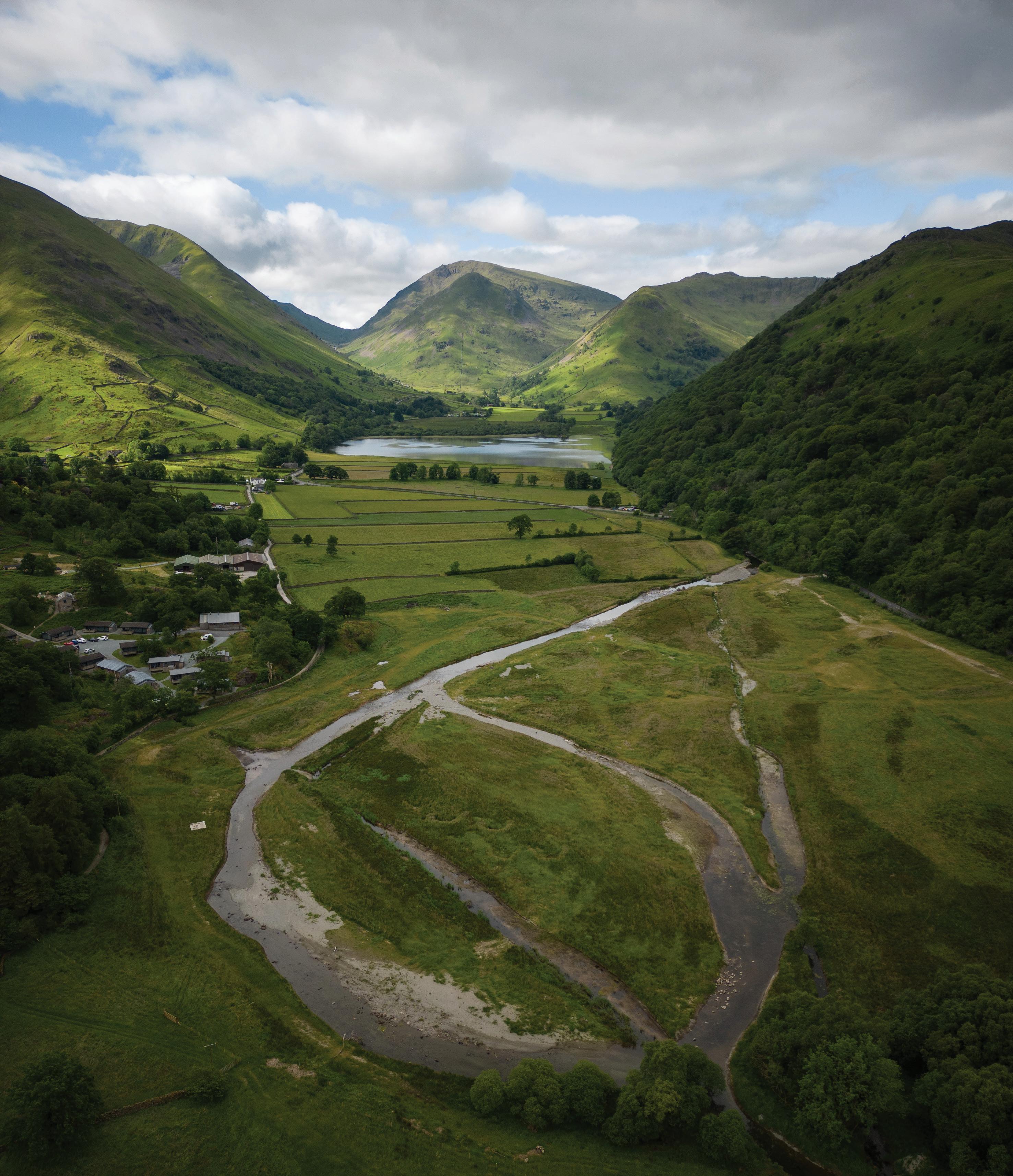
WHAT THE RIVER WANTS
08
NATIONAL TRUST
A Cumbria river-restoration scheme beat stiff competition to land the European Riverprize. Karen Thomas travelled to the Lake District to see how rewiggling a stretch of river can tackle pollution, restore wildlife and, as our climate changes, cut flood risk downstream
“W
e started out by asking what does the river want,” says George Heritage. “We needed to understand the river. As managed as it was – as much as the river had changed – the clues lie all around us in the landscape.”
We – Heritage, National Trust Riverlands project manager Rebecca Powell and I – are standing on a muddy hillock, gazing out across Goldrill Beck. Two years ago, it was a concrete-cased canal, forced parallel to the A592, bearing run-off from farms and roads into Cumbria’s lakes.
Now, it’s picturesque. Behind us, Helvellyn rises out of the clouds. Ahead, the stream forks across the floodplain, strewing shingle and silt. It vanishes into a woodland, then the gradient drops, creating tributaries that flow north to join Ullswater.
Ullswater is a typical Cumbria ribbon lake, formed as Ice Age glaciers retreated. It’s the second largest in the UK Lake District, the UNESCO World Heritage site and beauty spot that draws 16 million tourists a year to rugged northwest England.
But Cumbria is struggling with water pollution, flood risk and wildlife losses. Mismanaged watercourses have damaged protected Lake District sites, the National Trust says, contributing to “a severe decline in biodiversity”.
Heritage is a geomorphologist who helps consultancies, private landowners and local government to restore rivers and floodplains. When Cumbria River Restoration Project decided to tackle Goldrill Beck, it called in Heritage – then at Aecom – to advise.
CLIMATE IMPACTS
Most Lake District rivers became canals 300 years ago, encased to free land for grazing. But climate change is bringing volatile weather; heavier rainbursts and longer droughts. In 2015, Goldrill Beck and other streams that feed the River
Eden burst their banks during Storm Desmond, flooding Patterdale homes and farms, and closing roads.
Climate change is bringing heavier rain and longer droughts. Cumbria River Restoration Project is working across the Lake District to build resilience to climate change, to restore habitats and improve water quality.
“Not all rivers conform to this style. But we’ve all started to talk about rewiggling. Unfortunately, the wriggle room for rewiggling is about ten years beyond where we are”
Partners the National Trust, Natural England, the Environment Agency, RSPB, Ullswater CIC, United Utilities and the Eden, West Cumbria and South Cumbria rivers trusts spotted a chance to hold water on Goldrill Beck’s floodplain, slowing flows downstream and creating new wildlife habitats.
“This very modified stretch of beck was efficient at moving water very quickly downstream,” Powell recalls. “Communities downstream are vulnerable to flooding. It had been managed the same way for years, until hearts and minds began to change after Storm Desmond.”
Heritage used LIDAR data to model the catchment. The valley floor is farmland, grazing for sheep and cattle. That allows space for water. But not everyone agreed. Storm Desmond affected many local people. Talk of freeing a river can sound the opposite of cutting flood risk.
The partners talked to farmers, local authorities and residents. The farmers worried about grazing and safety access. The partners built that in. Natural England worked with tenant farmers to tap new stewardship funding.
That cleared the way to unshackle the river. Work began in spring 2021, to remove culverts, drainage channels
and embankments. The Environment Agency removed fish from the channel, then work started on diverting the river. Bags of soil created a dam as teams removed the channels. Once the river and sediment had settled, they opened the site downstream.
Goldrill Beck now flows lower on the floodplain, absorbing water that pours down from the hills and holding heavy rain.
COUNTING COSTS
Two years on, 1.6km of river has been restored. Goldrill Beck moves unfettered across its floodplain, supporting a 28,900 sq m wetland. Despite last summer’s drought and a dry winter, the 889m river has grown to 2.5km; its area has quadrupled to 28,740 sq m. Restoration has created 24,600 sq m of wet woodland, fed by seasonal water channels.
Hydrographic data suggests it takes two to three hours longer for peak flood flows to travel downstream. That buys more time to warn people and to react. In winter 2021/2022, the site held 1,800 cu m of sediment that would have rushed downstream in heavy rain.
There are horseshoe gravel bars, rarely seen in the Lake District. Plants and wildlife are bedding in. There are otters, dippers and wading birds. Riffles, rapids and pools create feeding and breeding grounds for insects and fish. Varied flow speeds and depths create diverse habitats.
“We started out by asking what does the river want. We needed to understand what the river was. As managed as it was – as much as the river had changed – the clues lie all around us in the landscape”
Rangers have planted 16 black poplars, bringing the UK’s most endangered native tree back to Cumbria. Black poplars could stand up well to climate change. “They like to have wet feet,” says Heritage.
An osprey platform stands unclaimed among the saplings. Powell dreams that ospreys will return to Patterdale soon.
What can other catchments learn from this?
09 NFM



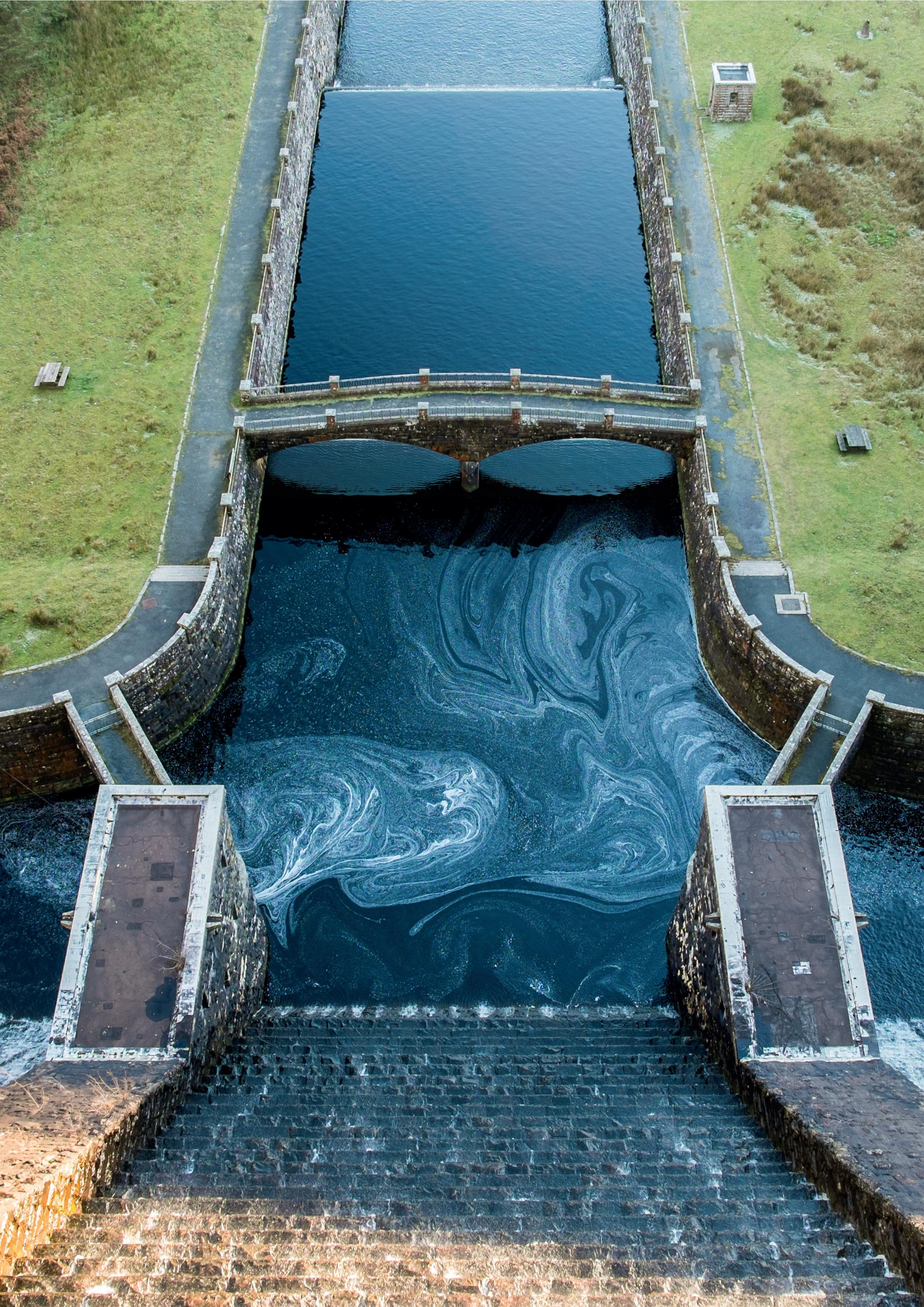




jobs CIWEMJOBS.COM ciwemjobs@syonmedia.com 0208 332 8416 Start recruiting the best by contacting us at: CAN HELP LATEST JOBS: FLOOD RISK ENGINEER £37,261 - £41,496 Tewkesbury Borough Council Tewkesbury, UK FLOOD AND WATER MANAGER £48,587 - £53,465 Milton Keynes City Council Hybrid (Milton Keynes, UK) FLOOD FORECASTING OFFICER £28,403 - £32,088 Natural Resources Wales Hybrid (Wales, UK) HYDROLOGY TECHNICAL SPECIALIST £37,462 EA Hybrid (Welwyn Garden City, UK) ASSOCIATE DIRECTOR/PRINCIPAL WATER QUALITY & CATCHMENT SPECIALIST Salary on application Binnies Hybrid (Flexible) SENIOR HYDROLOGIST £36,000 Canal & Rivers Trust Hybrid (Multiple Locations)

“Not all rivers conform to this style,” Heritage answers. “But the process? Definitely. We’ve all started to talk about rewiggling. Unfortunately the wriggle room for rewiggling is about ten years beyond where we are.
“This is about designing a watercourse in line with the processes operating there. Here, that means rewiggling and letting the river form an estimating, multi-thread channel, because that’s what it should be.
There’ll be more testing, more research and more gathering of evidence. What there won’t be is more river maintenance. “We’ll do nothing. The river will do as it pleases – for the rest of its life”
“The National Trust is starting to use methods now that are a lot less interventionist – working to understand how to trigger new processes and features with minimal intervention. That’s really where gains are starting to happen.”
The National Trust is a one of the UK’s largest landowners. Its Riverland scheme has invested £14 million in restoring rivers and catchments. Goldrill Beck cost
£680,000. Funding came from the trust and the European Union’s Agricultural Fund for Rural Development.
“Compare that to the hundreds of thousands, running into millions, it cost to maintain the river and that answers the cost-benefit question,” Powell says. “In terms of what we have here now for nature, I don’t like to put a cost to it. It’s just better.”
CUMBRIA RIVERRESTORATION PROJECT…
o Is a partnership led by Natural England and the Environment Agency
o Has delivered more than 100 projects across the Lake District
o Its 31 largest projects have restored 100km of river and 150 ha of floodplain habitats
o Goldrill Beck beat stiff competition from rivals the five-country Mura-Drava-Danube project and from Albania’s Vjosa project to win the 2022 European Riverprize
LESSONS
This summer, teams will gather soil samples to measure how much carbon the floodplain absorbs. They’ll send water samples for E-DNA testing, to find out what species live in the beck.
“We’ll build up a picture to show changes to carbon stored in the soil of this floodplain,” Powell says. “We’ll compare that to what’s stored in the soils around a modified river nearby. That should build up some figures about the carbon-storage potential of natural floodplains.”
Heritage sees the project as a sign of the times. “We modified our rivers 150 years ago,” he says. “We maintained them in that state thanks to grants. But in the last five to ten years, there is less desire – nationally and across Europe –to maintain artificial river systems.
“You only have to look at rivers to see what they really want to do – how they really should behave. What we’ve done here is take guidance from that.”
Meanwhile, there’ll be more testing, more research and more gathering of evidence. What there won’t be is more river maintenance.
“We’ll do nothing,” Powell concludes. “The river will do as it pleases – for the rest of its life.” o
11
NFM
NATIONAL TRUST
Before it was restored, Goldrill Beck was a canal that ran parallel to the A592
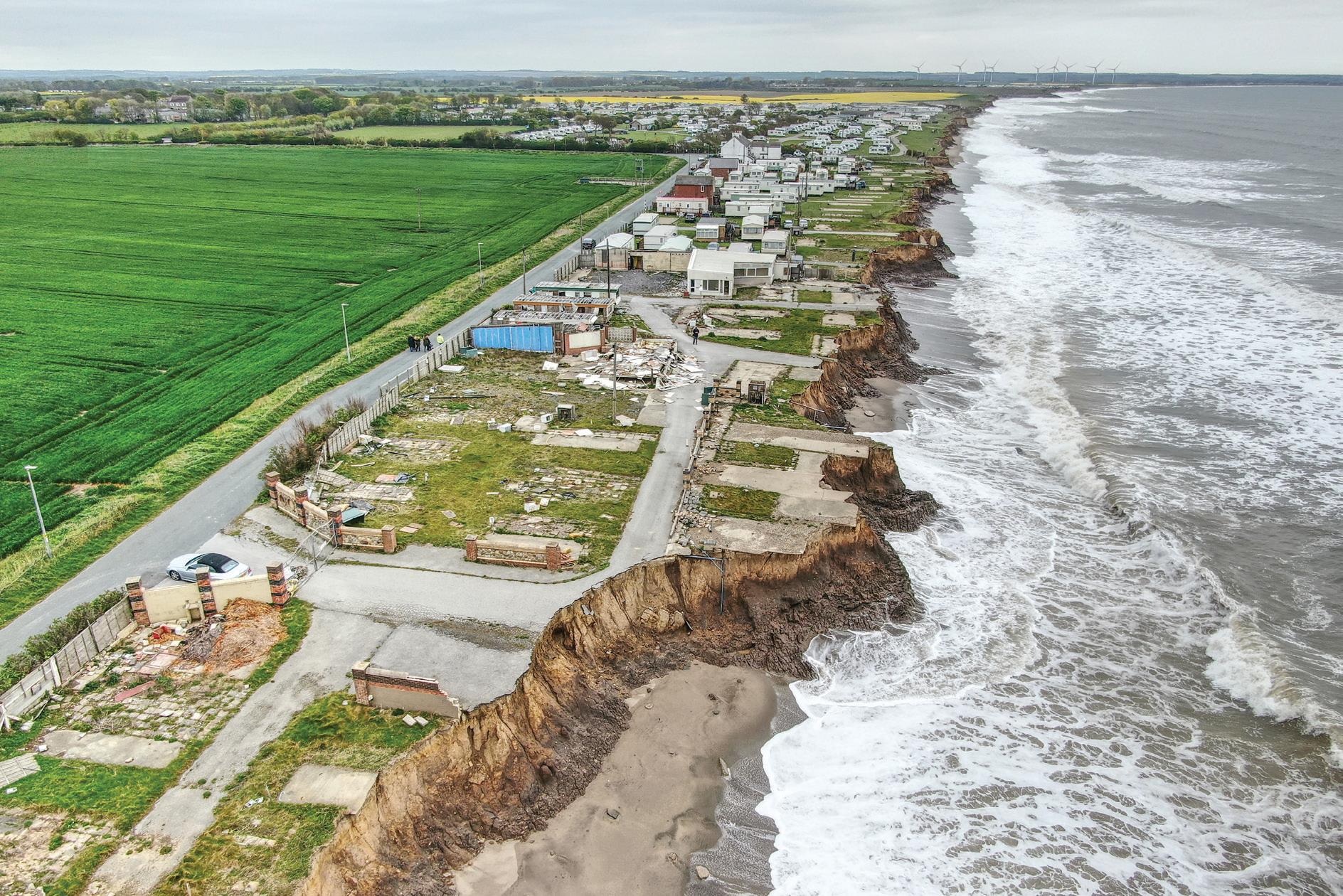
EYES DOWN TO DELIVER
Alan Lovell became chair of the Environment Agency last summer, amid growing alarm about both UK water quality and climate impacts. But tapping public concern about our rivers opens new ways to talk to people about climate risk, he tells
Karen Thomas
When Alan Lovell takes the stage on day one of Flood & Coast, expect practical messages about how we manage our climate-reshaped future; think local, deliver better, form partnerships to work for cleaner, greener and more resilient communities. For this opening address, think managed expectations not radical change.
Lovell replaced Emma Howard Boyd as chair of the Environment Agency (EA) last summer. Media buzz named him a troubleshoot hire. The chairman of civil and marine engineering contractor Interserve arrived with “a reputation as a turnaround specialist after… stints at Jarvis, Amey and Carillion”, as Construction News put it.
The Guardian describes him as an
accountant and businessman “who made a name stepping in to rescue failing companies, including a failed attempt to shore up the construction firm Carillion”.
“It’s recognising that some parts of the coast we cannot save. We must work, with huge regret, with the people that live there. Our responses must be proportionate”
Lovell takes on an agency beset by criticism – from its willingness and ability to monitor and hold to account polluters to the speed and scale with which it helps communities to adapt to climate change. It’s had a rough ride, he admits. But the answer, he tells The
Environment, is to focus on deliverables –to do the day job really well.
Recent water-pollution scandals have grabbed public attention, he says. We need to harness people’s outrage to address climate change – what’s coming, how we manage it. And that means working locally, with local partners, using the best available technology to build awareness and resilience.
Where possible, it’s about putting nature-based solutions first, he says. “If we put in a truly excellent performance, making a real difference to water quality, continue to deliver a first-class, modern flood approach and genuinely become a modern regulator of the highest quality, this will give us the standing to have significant impact on climate-change challenges.”
That messaging is ground-up, not topdown. Lovell brings an intriguing switch in emphasis.
CHALLENGES
Rebuilding public trust may be the biggest challenge for EA leaders, not least Lovell
12
SHUTTERSTOCK.COM
More than 100,000 people face ‘serious coastal flooding’, the Environment Agency says
and his chief executive Philip Duffy, who replaces James Bevan.
The EA can’t be seen to defend polluters – whether water companies or farmers – Lovell says. He welcomes the government’s Plan for Water, unveiled in April, which pledges to fine polluting water firms harder. Those heftier fines create a new Water Restoration Fund.
“Ofwat has announced that both [water company] dividends and bonuses will be subject to environmental conditions – which is great,” he says. “It should have been done before.”
We’re meeting to talk flood risk. A third of British people live within 5km of the coast – many in deprived coastal towns. The EA launched its State of the Environment report on coastal and marine ecosystems in January. It highlights the cost of England’s lost saltmarshes, seagrass meadows and native oysters to carbon sequestration and coastal protection.
More than 100,000 people face “significant coastal flooding”, the report notes. Global heating of just 2°C will increase that number by 300 per cent by 2100. How do we manage our coastal flood risk?
One way is to restore nature, Lovell says. Another is to invest and innovate, to scale up solutions. A third is partnerships. Tap local knowledge and engagement.
“There’s a possibility that sea levels will rise by 1m by 2100,” Lovell says. “One-in-100-year storms are likely to become annual. The other scary thing is how much of the UK is below sea level –something like 15 per cent.
“It’s important to manage this in a natural way – using natural flood management (NFM), not big concrete barriers. The EA has its own climate-change and net-zero targets to fulfil.”
COST-BENEFIT DECISIONS
Getting the message across isn’t easy. Flooding and coastal erosion risk management (FCERM) jargon can be opaque.
The UK manages coastal change in three ways: hold the line, managed
realignment and no active intervention. Hold the line can mean more hard engineering. Managed realignment alters flood defences and works with nature to reshape shorelines and estuaries. No active intervention lets the sea have its way.
“Our job is to sell [NFM] to government as the right way to address flood risk. It’s not as obvious – doesn’t show the same immediate benefits – as putting up a big, concrete wall, but it’s the right approach”
Cost-benefit decisions mean not all homes will be saved. When the ClimateChange Committee (CCC) reviewed the UK Shoreline-Management Plans, it found 3 per cent of coasts designated for managed realignment in England and Wales. The CCC wants to expand that to 16 per cent by 2105. How do we close that gap?
“It’s about steady progress,” Lovell says. “Making a difference in every fiveyear period. And it’s recognising that some parts of the coast we cannot save. We must work, with huge regret, with the people that live there. But we believe this is the right view to take. Our responses must be proportionate.”
The second six-year FCERM plan “has fewer big and many more smaller projects in it”, he says. “That doesn’t have the same headline value but is just as important. Many will have other natural benefits. And that’ll be the trend for the next few decades. We just need to keep going.”

show the same immediate benefits – as putting up a big, concrete wall. But it’s the right approach. We’ll focus on this wherever we can.”
MONEY TALKS
In March, Lovell travelled to Hemsby in northeast Norfolk as storms cast three homes into the sea. He feels “very proud” of the agency’s record on FCERM and its work with local authorities. But how do we talk to people about flood risk – about eroding coasts that threaten lives, homes and livelihoods?
Lovell urges government to strengthen shoreline-management plans to be able to block new building on vulnerable stretches of coast.
But the fact is that agencies won’t defend everyone’s home, and many local people don’t yet grasp this. “The Coastal Transition Accelerator Project (CTAP) will address just this,” Lovell says.
CTAP is part of the £200 million Defrabacked Flood and Coastal Resilience Innovation programme. The six-year project has £35 million to work out what practical steps will make undefended coastal communities more resilient.
Two pilots focus on fast-eroding North Norfolk and the East Riding of Yorkshire “that cannot sustainably be defended”. They will step up planning, strategic and for action, to move people, businesses and assets away from two of the UK’s fastest-eroding coastlines.
Of the UK homes most vulnerable to rising seas, 84 per cent are in these two catchments. The pilot ends in 2027. Agencies will apply the findings to other at-risk coastal towns.
He says the EA’s Natural Flood Management Initial Findings support that approach. Published in November 2021, it found 60 NFM pilot projects had delivered multiple benefits,
protection to cleaner rivers and
“Our job is to sell this concept to government as the right way to address flood risk. It’s not quite as obvious –it doesn’t
Should government compensate people for lost homes and businesses?
“That’s probably above my pay grade,” Lovell says. “Some people may have lived there a long time. Others may be taking advantage to buy cheap homes. Where would you draw the line?
“In a way, coastal erosion is more difficult than flood risk – we can’t do anything about it. It was by chance, but I’m glad I travelled to Norfolk in time to see how those three houses were lost. You feel devastated for the people concerned. But gosh – doesn’t that warn others that they need to do something…?
“We’re facing some really difficult decisions.”o
13
FLOOD & COAST
Alan Lovell: “We’re facing some really difficult decisions”
WE NEED AN INTEGRATED APPROACH TO MAKE OUR RIVERS HEALTHIER
The Rivers Trust is a partner in Flood & Coast this year. Mark Lloyd sets out his agenda for this year’s conference
Floods, droughts, sewage, agricultural runoff, hazardous chemicals, straightened concrete banks, barriers and invasive non-native species – our rivers face a perfect storm of pressures that undermine their health and resilience.
River health has been described as a wicked problem. At the Rivers Trust, we believe that such a wicked problem requires an integrated approach that ties together work to tackle floods, drought and pollution with the restoration of natural habitats.
This is why the Rivers Trust leaped at the opportunity to co-host the second day of the conference at CIWEM’s Flood & Coast 2023 – we see it as a key moment to bring together a coalition of organisations willing to build a sustainable, collaborative system for water management.
SICK RIVERS
Only 36 per cent of UK surface waters – rivers, lakes and coastal waters – are classified to be of high or good status. A pitiful 14 per cent of English rivers are in good ecological status. Not a single one has attained good chemical status.
Not surprisingly, the global decline in freshwater species is acutely reflected in UK rivers, with salmon stocks, for example, at their lowest levels on record.
The poor state of UK rivers also raises implications for human health. Freshwater recreation has never been more popular. However, swimmers, kayakers, sailors and other river users risk contact with sewage, chemicals and toxic algal blooms.
The risks of consuming contaminated fish and shellfish also raise concerns. The dire state of our rivers also has economic costs. It takes expensive treatment to remove pollutants from raw drinking water sources.
Meanwhile, the balance between water
demand and availability reached a critical level in many areas of the UK last summer, when our unsustainable over-abstraction exacerbated a prolonged drought. News reports showed markedly reduced river flows, depleted lakes, reservoirs and aquifers, and drying wetlands.
The drought interrupted UK drinkingwater supplies, hit crop production and took its toll on our freshwater ecosystems. It could take our fish and bird life years to recover from the severe impacts of last year’s drought.
During the worst of it, some parts of the country experienced flash floods as high-intensity rainfall fell onto hardbaked ground and impervious roads and pavements. In Totton, Hampshire, a deluge overwhelmed a pumping station, leading sewage to be discharged into the town.
Flooding continued through the autumn, impacting transport networks and power supplies – yet as some areas flooded, much of the country continued to struggle with water in low supply.
This seeming paradox is entirely in line with climate-change predictions that point, worryingly, to both droughts and floods being increasingly more frequent and severe in the future. Expect the 2022 drought to become the new normal.
POLLUTION SOUP
Our rivers are contaminated with thousands of pollutants: nutrients, microbes that include bacteria resistant to antibiotics, hazardous chemicals, metals, pharmaceuticals and plastics. These come from several sources, including agriculture, industry, transport and our homes.
Some pollutants run off fields; others enter watercourses directly, from roads and pavements; and still others are discharged to a wastewater treatment plant and are partially treated before being discharged to rivers or applied to agricultural land within sewage sludge.
The UK sewerage system is overloaded. It’s unable to cope with increasing pressures from housing development, heavier rainfall and a profusion of nonbiodegradable waste clogging up the system. And that leads to combined sewer overflows discharging high volumes of run-off water, emptying pollutants and raw sewage directly into our rivers.
The Rivers Trust believes that wicked problems require an integrated approach that ties together work to tackle floods, drought and pollution with the restoration of natural habitats. It’s why we leaped at the opportunity to host a day at Flood & Coast 2023
Figures for 2021 record more than 470,000 of these discharges in England and Wales, spilling for a total of 3.5 million hours.
The cocktail of chemicals recorded in our rivers causes a range of chronic and acute effects on aquatic life, damaging rates of growth and reproduction. Among the most alarming of these is that of intersex or feminisation of male fish caused by chemicals that disrupt hormone systems.
Water quality and water quantity are closely interlinked. The lack of water during last summer’s drought considerably worsened water quality because there was then less water to dilute the pollution that continued to discharge to our rivers.
Similarly, floods risk bringing sewage pollution into our homes and businesses as systems are overwhelmed.
TURNING TO NATURE
We’ll still need hard-engineered flood defences and stormwater tanks to address our riverine crisis. But we also need nature-based solutions to be much more widely implemented in rural and in urban environments.
14
Nature-based solutions include wetlands and ponds, woodlands, riparian buffer strips, smart soil management and sustainable urban drainage. These features act to hold water back, helping it to infiltrate slowly, building up stores on land and in the soil and groundwater, and preventing flows discharging rapidly into the river network.
Nature-based solutions reduce flood risk and slow the release of water back to the river, buffering it in times of drought and ensuring sufficient baseflow to support freshwater ecosystems. They also trap and attenuate pollutants, holding them back from the river network, which helps to improve water quality.
Creating nature-based solutions in our towns and cities also provides opportunities for local communities to access nature, which has proven benefits for health and wellbeing. In deprived areas, this can help to support the UK government’s Levelling Up agenda.
We need greater investment from water companies to fix our rivers, from tackling storm overflows and upgrading wastewater treatment works to addressing leakage in water-supply pipes. But agriculture remains the greatest source of river pollution and flooding through poorly managed land, eroded soil, degraded habitats, slurry and agrichemicals.
The UK government’s new Sustainable Farming Incentive can play an important role here, driving changes to soil, chemical and slurry management.
Private investment can also play an important role. The agricultural supply chain, which includes multinational corporations, is starting to provide funds to manage land more sustainably. This benefits both the farm business and the environment.
The Rivers Trust has led a pioneering approach to address flood risk on the River Wyre in Lancashire, securing green finance from investors to deliver natural flood-risk management, to be paid back over several years by organisations that benefit from reduced flood risk and other outcomes arising from the project.
We can replicate that approach elsewhere, creating a step-change towards more sustainable management of land and water.

WORKING TOGETHER
We still face challenges. One is our plethora of plans for freshwater and land management. These include the government’s 25-year Environment Plan, river-basin management plans, drainage and wastewater management plans, flood-risk management and landscaperecovery plans.
The Rivers Trust has led a pioneering approach to address flood risk on the River Wyre in Lancashire, securing green finance to deliver natural flood-risk management that firms will pay back over several years
So far, we have worked in silos to implement all these different plans, missing opportunities to create synergies. We need long-term, strategic planning at rivercatchment scale to adopt a holistic approach and draw on mapped opportunities to
deliver multiple benefits – to prevent pollution and support flood protection, nature recovery and carbon sequestration.
This demands a collaborative approach. Catchment-based partnerships provide a framework to convene a wide range of stakeholders, including water companies and local authorities, to catalyse action.
One example, in northwest England, is the European Union-funded LIFE project Natural Course. This ten-year project creates a unique partnership between the Rivers Trust, Environment Agency, United Utilities, Greater Manchester Combined Authority and Natural England. It provides a template for successful collaboration at a river basin or regional scale nationwide.
Everyone at the Rivers Trust looks forward very much to Flood & Coast 2023. We hope you’ll join us in an engaging discussion on the future health of our water. o
Mark Lloyd is chief executive of the Rivers Trust
15
& COAST
FLOOD
THE RIVERS TRUST
QUIZ WHICH SUDS SUPERHERO ARE YOU?

Sustainable drainage systems (SuDS) will soon become mandatory for new developments in England. So we’ll need more specialist skills to deliver these projects. Are you ready for the challenge? Take our fun quiz by Vikki Keeble and Laura Bigley to find out
With SuDS about to become more widely used in England, this feels like the perfect time for the Association of SuDS Authorities (ASA) to co-host a day of discussions at this year’s Flood & Coast conference about the opportunities and challenges ahead.
ASA was founded in 2018 to help local authorities with SuDS and surface-water drainage – to support growth, deliver constancy, enable development and manage water more sustainably. ASA promotes members’ interests at a national level and provides a forum to share ideas.
Most members work in local authorities from across the country, but ASA also
represents associate members and sponsors from industry suppliers and from flood-risk management authorities. That gives local authorities the access to industry experts and innovative products that they need to deliver.
ASA’s local-authority members come from a range of backgrounds, bringing diverse knowledge, skills and experience. ASA taps that network to gather evidence about and solutions to the challenges and opportunities that face the SuDS community and to influence national agendas.
We would love to work with you as we enter this exciting – challenging –time, as England prepares to implement Schedule Three of the Flood and Water-
Management Act in 2024. ASA is helping Defra to shape the proposals to make this a success, through various advisory groups and workshops.
We will also support our membership through these changes, offering information, advice, support and guidance, a mechanism for feedback and suggestions for ways to tackle the challenges we meet along the way. ASA’s executive board has agreed to focus on five workstreams this year:
o ASA young person’s network
o Legislation and policy to shape SAB/ Schedule Three
o SuDS and biodiversity net gain
o Technical and data management
o Groundwater resources and regulation. o
ASA’s role has never been more important. If you’d like to get involved, please email admin@suds-authority. org.uk. And if you’re wondering what aspect of SuDS most attracts you, why not take this fun quiz to get started?
16
SHUTTERSTOCK.COM
1YOU’D LIKE TO TAKE A COURSE TO LEARN MORE ABOUT SUSTAINABLE DRAINAGE. WHAT ELEMENT OF THE COURSE EXCITES YOU MOST?
A Understanding river hydraulics
B Sampling rivers and streams
C Delivering sustainable spaces
D Good land management
2 WHEN YOU LOOK AT A POND, WHAT DO YOU NOTICE?
A Its location in relation to land levels
B The colour of the water
C How it’s situated in its environment
D What’s in the water
3 LOOK AT THE PICTURE TOP RIGHT. WHAT WOULD IMPROVE THIS POND?
A Nothing – it does the job
B Plant a reedbed around the banks
C Add a walkway to connect people to their environment
D Mow the grass less often
4 WHAT MATTERS MOST TO YOU WHEN YOU LOOK AT A PLANNING APPLICATION?
A That it identifies sub-catchments within the site
B That it provides a treatment train from source to discharge
C That it enables the built and natural environments to interact
D That it maximises habitats
5 YOUR LOCAL FLOOD-ACTION GROUP WANTS TO HELP THE COMMUNITY TO MANAGE RISK MORE EFFECTIVELY. YOU ADVISE THEM TO...
A Install water butts and rain gardens
B Become local-river guardians with the nearest rivers trust
C Encourage homeowners to use permeable paving on their driveways
D Introduce a variety of water-loving plants
6 THE SUDS BENEFIT THAT MATTERS MOST TO YOU IS...
A To manage flood-risk effectively
B To reduce phosphorous and nitrates in the water
C To create high-quality communities
D To maximise habitats for wildlife



7 YOU ASK YOUR LOCAL COUNCILLOR TO INVESTIGATE A PROBLEM WITH YOUR COMMUNITY’S WATER ENVIRONMENT BECAUSE...
A There is standing water on the local football pitch
B The water has an odour
C The local park is very boggy underfoot
D The watercourse has unexpectedly run dry
8 IF YOU COULD START YOU CAREER AGAIN, YOU WOULD...
A Still become a flood-risk manager; I love my job
B Become a water scientist; I enjoy time in labs
C Be a planner, creating a vision for new communities
D Become an ecologist, to protect the birds and the bees
9YOUR FAVOURITE SUDS FEATURE IS...
A Swales
B Bioretention wetlands
C Street trees
D Blue-green roofs
10 THE FILLINGS THAT MAKE YOUR IDEAL SUDS SANDWICH ARE...
A A soakaway, oversized pipe and geocellular storage
B A rain garden, permeable paving and a pond
C A green wall, permeable paving and a rill
D A green roof, swale and bioretention wetland o
Find out more/get involved: www.suds-authority.org.uk
MOSTLY As
YOU’RE A FROG:
A WATER-QUANTITY EXPERT
You understand how much flood risk matters to communities and to regulators. You are passionate about designing sustainable drainage that holds back water effectively to slow flows and mitigate flood risk.
MOSTLY Bs
YOU’RE A FISH:
A WATER-QUALITY ADVOCATE
You are concerned about the quality of the environment and recognise how critical it is to reduce our impacts on watercourses and the plants and animals they support.
MOSTLY Cs
YOU’RE A BIRD:
AN AMENITY AMBASSADOR
You care about how our spaces look and how to design places to maximise environmental benefits and mitigate the impacts of climate change, including on our precious water environment.
MOSTLY Ds
YOU’RE A BEE:
A BIODIVERSITY CHAMPION
You want to enhance our natural environment, creating new habitats for flora and fauna that create a beautiful network of blue-green infrastructure to boost biodiversity and environmental net gain. o
17 FLOOD & COAST
VIKKI KEEBLE leads Buckinghamshire Council’s sustainable-drainage team. She is co-chair of the Association of SuDS Authorities with Laura Bigley, who manages Lancashire County Council’s flood-risk management team.

PAKISTAN AND NIGERIA After the flood

Last September, world attention fell on Pakistan after raging floods left swathes of the country underwater. Entire communities were cut off. Homes, farmland, infrastructure and medical facilities were damaged or destroyed. More than 1,700 people died.
The scale of the crisis shocked international onlookers. An appeal from the Disasters Emergency Committee – 15 UK charities that collaborate to respond to catastrophes – raised more than £40 million to support those affected.
People outside Pakistan might think the floods struck without warning. In fact, flooding had started in June, among many deadly extreme-weather events. Pakistan has faced ever more climate-related

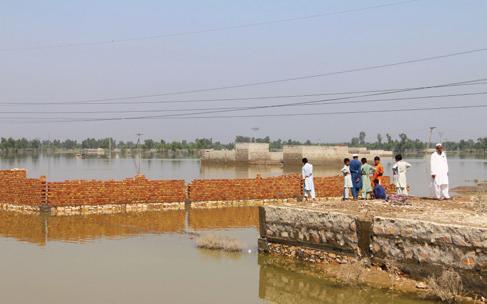
emergencies for decades, says Pakistan Red Crescent Society deputy director for climate-change adaptation Javeria Nazir.
Some areas of Pakistan were still submerged six months after the crisis peaked. The United Nations reports that more than 10 million people still lack clean drinking water
“Throughout the last 20 years, Pakistan has consistently been among the ten most vulnerable nations in the world to the impact of climate change,” she notes.
“Floods commonly occur in Pakistan, especially between July and September

during the monsoon season. We saw devastating floods that affected millions of people and seriously damaged infrastructure, crops and lives in 2010, 2011, 2014 and now in 2022.”
Several factors make Pakistan vulnerable to extreme weather. Most of its population lives along the Indus River, which swells during the annual monsoon rains. Millions are at risk should the river burst its banks.
The country grapples with two major weather systems, susceptible to heavy rain and to prolonged heat and drought. When a heatwave hit Pakistan and India last March 2022, temperatures in the central Pakistani city of Nawabshah hit 49.5°C.
Yet Pakistan has more than 7,000
18
RED CROSS RED CRESCENT
glaciers – only the polar regions have more. But these are shrinking more rapidly due to global warming, which creates torrents of meltwater. For a population already struggling with mounting climate risk, the effects of last year’s floods become starkly clear.
“At the height of the flooding, one third of the country was under water,” Nazir says. “More than 33 million people have been affected in some way by the disaster. Hundreds of thousands of homes have been destroyed, entire herds of livestock wiped out and two million acres of crops damaged.”
DISPLACEMENT
The floods’ effects have lingered, even as the waters recede. “Millions of people were forced to leave their homes due to the floodwaters and many still have not been able to return,” Nazir says.
“The displacement of so many people led to overcrowding in refugee camps and a strain on the resources of the government and humanitarian organisations. The contaminated floodwater resulted in outbreaks of waterborne diseases such as cholera, typhoid fever and hepatitis.
“People struggled to find food, clean water and sanitation facilities, which has led to food insecurity, nutrition deficiency and other health problems for many in the affected areas.”
The international response to both the immediate aftermath of the flooding and the ongoing threats was immense. The Pakistan Red Crescent Society co-ordinated one of the biggest-ever relief efforts.
It provided tents and temporary shelters to more than 300,000 people and food packs and hot meals to almost half a million households. More than 180,000 people received first-aid and mobile health services. Restoring Family Links teams worked to reunite lost families members.
Disaster left profound psychological impacts, Nazir says. “People have lost loved ones, homes and possessions. There has been a corresponding rise in mental health issues such as anxiety and depression. The traumatic experience continues to affect people.”
What role did climate change play in the disaster? Attributing specific causes to individual weather events is notoriously difficult, but scientists
at World Weather Attribution (WWA) report that parts of Pakistan experienced record-breaking monsoon rains.
Sindh and Balochistan provinces had their wettest August on record, with seven to eight times the expected levels of rainfall. WWA concluded that climate change probably did contribute to the floods.
NIGERIA DELUGED
Pakistan wasn’t alone in suffering extreme flooding in 2022. Between June and November, Nigeria suffered its worst floods in at least a decade, across 29 of its 36 states. Hundreds of people died, two million were displaced and millions more needed humanitarian support.
The British Red Cross maintains a humanitarian support programme in Nigeria. Rachel Kirvan, a worker providing cash assistance, witnessed the destruction. “I heard people say it’s the worst they’ve seen in many years,” she says.
“Floodwater was in people’s homes, in their businesses. We saw people floating their beds on jerrycans… We visited a group of people staying in a church. The church itself was filled with water. There really was no escaping it.”
Weather data and computer modelling suggest that although Nigeria floods every year, humancaused climate change makes damaging events about 80 times more likely
The Nigerian Red Cross mobilised more than 5,000 staff and volunteers to help people caught up in the floods, help with evacuations, manage camps for displaced people and provide humanitarian support. Volunteers provided psychosocial support, first aid and a hygiene-promotion service to displaced people.
Conditions on the ground were challenging. It was a struggle to deliver food and fuel by truck or train to people in particularly badly hit areas. Many schools or health centres that could have hosted the relief effort were unusable or were already sheltering homeless people.
The floods struck as African countries, including Nigeria, struggled with a grinding food crisis. Around 19.5m
Nigerians were struggling to find enough to eat. That meant the floods piled one emergency on top of another, Kirvan says.
They brought damage and displacement to communities already in crisis. The impacts of flooding on livelihoods and crops “destroyed what little people have”. It’s critical to prepare and build community resilience before disaster strikes, she says.
“The Red Cross has conducted earlywarning workshops, where communities conducted vulnerability and capacity assessments, looking at the hazards that impact their communities.
“The community then develops contingency plans and action plans, which are put into place when an emergency hits. This has involved developing monitoring systems that reflect people’s knowledge of their environment and local ways of working.”
With Nigeria, WWA made a more definitive statement about the impact of climate change. Using weather data and computer modelling techniques, it found that although floods occur every year there, human-caused climate change makes extremely damaging events such as this around 80 times more likely.
“We know these floods come every year and with the impact of climate change they are getting more severe,” Kirvan says. “So it is even more imperative that communities can support themselves ahead of that flooding.”
AFTERSHOCKS
In Pakistan, some areas of the country were still submerged six months after the crisis peaked. A recent United Nations report found that more than 10 million people still lack clean drinking water.
Nazir says extreme-weather and climaterelated disasters raise questions about inequality. “Pakistan contributes less than 1 per cent of the global greenhouse gases that warm our planet, but its geography makes it extremely vulnerable to climate change,” she concludes.
“According to a rough assessment, the direct damage to roads, homes, livestock and crops is more than US$30 billion, which is an astronomical amount for a lowerincome country like Pakistan. People in the country feel a keen sense of injustice.” o
Owen Duffy works for British Red Cross
19 INTERNATIONAL
‘PEOPLE WHO WALK ON TIGHTROPES UNDERSTAND RISK VERY WELL’

Traditionally, aid agencies reacted to disasters when they struck. But smarter science makes it easier to predict, plan for and adapt to climate-linked disasters, Roop Singh tells Karen Thomas
“We’re always looking to connect,” Roop Singh says. “We’ve worked with scientific institutions. We want to partner with cultural institutions. One colleague is working with a circus group. That might sound weird, but people trained to walk on tightropes understand risk exceptionally well.”
From climate risk to circus acts is quite a swerve. It’s what India-based Singh does; connecting experts and communities, linking scientists and modellers and people who face climate impacts. And if that means circus acts, flash mobs, even rickshaw tours, bring it on.
Singh is a climate-risk advisor with the Red Cross Red Crescent Climate Centre (RCRCCC). The agency created RCRCCC having seen climate change become a humanitarian challenge.
From storms and floods to droughts and crop failures, climate change is hitting the world’s poorest, most vulnerable people hardest. RCRCCC works with international scientists, using climate data to help communities to anticipate and manage climate shocks.
It applies global research at local level to create better early-warning systems and build climate-smarter health, medical, water, sanitation and food systems. It connects climate science, policy and practice with the international
RCRC movement and local people. Making hard science more accessible helps people to prepare and adapt, Singh explains. “In the last five years, it’s shifted towards anticipatory action – acting, based on forecasts, before disaster strikes.”
That includes early-action protocols for Bangladesh. Experts notify Bangladesh Red Crescent as soon as they forecast a tropical cyclone. Local teams prepare, warning communities when to move livestock or move into storm shelters. It’s then easier to fund aid before – not after – disaster strikes.
RCRCCC is developing similar protocols for heatwaves in Bangladesh. It connects international and local experts. “We might partner a local and an international university,” Singh explains. “But we’ll also bring in local stakeholders who understand what levels of impact matter –will 50mm of rain displace people?
learns from each other, creating solutions our local partners find useful.”
LOCAL PATTERNS
Conversations can also start with local questions. “Mongolia faces something called
off of livestock that happens every few years,” Singh says. “It’s often associated
with drought and cold winters. It happens periodically, with huge impacts on Mongolian herders, who are already vulnerable.”
In winter 2018, Mongolian herders lost 700,000 animals. Nearly ten million animals died, frozen in their tracks, in winter 2009-2010. The mass deaths drive nomads off the land and into cities. “If we can predict when dzud may strike – if we understand the indicators better – there may be things we can do in advance.”
This year’s flashpoints include a prolonged La Niña weather event, linked to drought in the Horn of Africa, which is facing a sixth consecutive dry season. RCRCCC is tracking cyclone season in the Indian Ocean and heatwave season in Pakistan and Bangladesh. The research includes attribution analysis; tracking extreme events in real time to understand how climate change is shaping them.
“We need to understand what makes people vulnerable to things like drought,” Singh says. “Is it a lack of coping mechanisms? Is it depending on certain livelihoods or social structures. Conflict is a challenge across the Horn of Africa – what role does that play? We need to understand the linkages – how they compound each other to create impacts we might not expect.”
But better messages also matter. Last summer, RCRC ran a global Twitter campaign and local #BeatTheHeat! flashmobs on 14 June – Heat-Action Day. Volunteers uploaded videos from Kenya to Turkey and from Nepal to Uganda.
Red Crescent Bangladesh hired a YouTuber to ride a rickshaw through

explaining how to stop heatstroke. This April, temperatures there
“Climate change is nuanced,” extreme weather event will become more frequent everywhere. Everyone needs to understand their own local climate and how it’s changing, to be able
20 INTERNATIONAL
Mogadishu, Somalia
MEHMET ALI POYRAZ / SHUTTERSTOCK.COM

STANTEC: ACCELERATING SUSTAINABLE SOLUTIONS FOR COMMUNITIES
Stantec, a global leader of sustainable design and engineering services, is exhibiting at this year’s Flood & Coast conference on stand E38.
At the event in Telford, the firm’s flood and coastal, and water design and engineering experts will be on hand to provide advice and global insight around nature-based solutions, guiding visitors on how to best create sustainable, resilient communities and accelerate their capital programmes.
Understanding fluvial, coastal and stormwater processes, and their interaction with the built environment, Stantec offers full services in coastal engineering, flood-risk management, marine science and integrated watermanagement services, including regeneration and design.
The company carries out feasibility studies and cost/benefit analyses as well as detailed design, permitting, construction monitoring and environmental-disaster planning, mitigation and response services.
With more than 26,000 employees worldwide and more than 20 offices across the UK and Ireland, Stantec is at the forefront of supporting the entire builtenvironment sector. The interdisciplinary firm works with likeminded clients to deliver innovative, cost-effective sustainable solutions that add true social value.
On Day 1 of Flood & Coast, Stantec will
KEY SERVICES
o Flood mitigation and riverbasin management
o Nature-based solutions
o Reservoirs, dams and levees
o Pump stations and control structures
o Navigation structures
o Water resources and supply
o Wastewater recycling and water management
o Bathing waters and water quality
o Coastal storm risk management
o Ecosystem restoration/living shores
o Blue carbon
o Offshore renewables
o Ports and harbours
o Stormwater and urban drainage
host a roundtable discussion on naturebased solutions for coastal challenges. The group will talk through opportunities and barriers with those who have most influence in their communities.
Together, they will talk through innovative blue-green ideas for local authorities, community groups and the Environment Agency, and share their global experiences with audience members.
On Day 3, Stantec’s Chris Digman and Elliot Gill participate in the conference programme addressing blue-green infrastructure asset management and the
‘future of surface-water management’.
Stantec brings its global technical expertise to every project and delivers environmental solutions that support resilient clients and communities. As a preferred supplier to Perfect Circle, Stantec can offer these services through the SCAPE Professional Services Framework to public sector clients, using this framework to accelerate schemes through flood-risk funding programmes.
For example, Stantec has extensive experience of accelerating large catchment studies and designing major land-drainage pumping stations and tidal outfalls in both lowland and defended coastal locations. The company has also worked with Living with Water in Hull to develop a blue-green transformative plan that addresses long-standing urban drainage flooding challenges.
Stantec offers integrated urban water management services, and an integrated approach to coastal risk management in both defending the line and managed realignment solutions for the Environment Agency and internal drainage boards. o
Visit Stantec on stand E38 at this year’s Flood & Coast 6-8 June.
www.stantec.com/uk

21 ADVERTORIAL
• Environmentally friendly meeting rooms for hire
• Professional video conferencing
• Catering to suit all dietary requirements
• Sustainable offices for let
• Minutes from Farringdon Station
• Building constructed to BREEAM Excellent standard
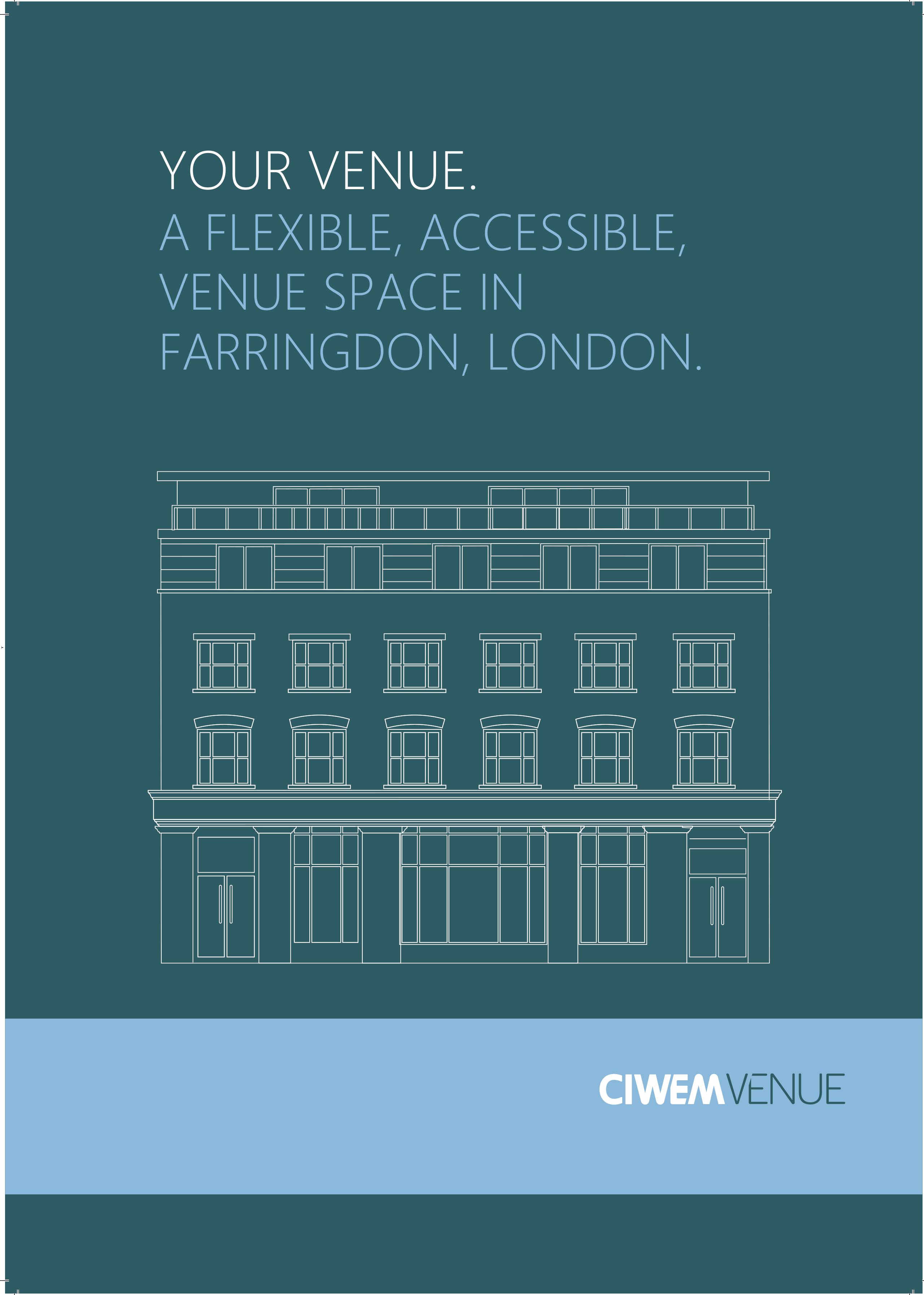
www.ciwem.org/venue/ ciwemvenue@ciwem.org
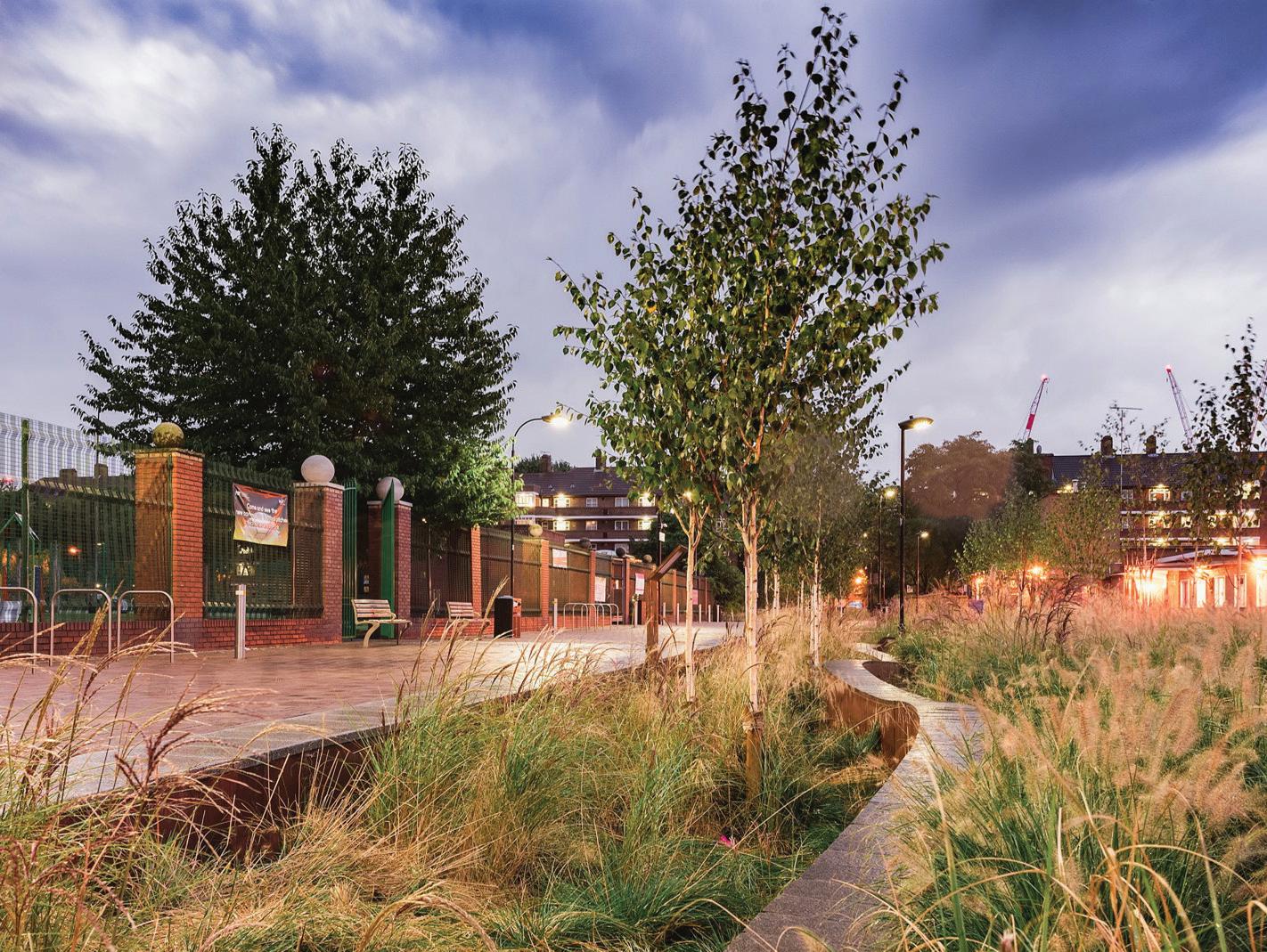
WHAT DO WATER-SMART COMMUNITIES LOOK LIKE?
From soil to spring to sea to soil again – our relationship with the water cycle has been fragmented for too long. It’s time to rethink how we manage water. How can sustainable practice, climate resilience and integrated approaches reshape our future water management? Ky Trickett reports
Across England and Wales, our water cycle is at risk with too much, too little and poor-quality water. We’re experiencing frequent severe flooding, sustained droughts and increased impacts on water quality.
Projected UK housing growth in its current form will increase demand on water services to an unsustainable position and impact the wider environment.
The existing water network is old and hard to retrofit. But where new housing
developments are planned, there’s an opportunity to rethink how water arrives at the taps, to work with the construction industry to do things differently.
One solution is to create water-smart communities whose infrastructure treats water where it falls. This approach reduces pollution and flood risk, and improves water quality, as an amenity and in the environment.
In practice, this could mean harnessing non-potable water using rainwaterharvesting or sustainable drainage
systems (SuDS) that integrate nature into the urban setting – think tree pits, permeable pavements and raingardens.
CIWEM is a partner in Enabling Water Smart Communities (EWSC), an innovation project to explore the relationship between integrated water management and new housing deveopments. EWSC is exploring which infrastructure solutions can
Historically, the water industry has treated people as passive consumers who want as little as possible to do with water other than paying the lowest price. This has excluded communities from decision making
23
OPINION
BRIDGET JOYCE
Borough of Hammersmith and Fulham –SuDS schemes capture surplus water during floods and retain water during droughts
work with nature so that people and the environment thrive.
The EWSC project is funded through the Ofwat Water Breakthrough Challenge, led by Anglian Water. The partners include Arup, water companies and leading academics, developers and housing associations.
The project has a three-year timeline and will run until December 2025, split into four phases: discovery, definition, development and delivery. EWSC is now in the discovery phase, which will inform how the project can deliver most impact.
But how do we tackle historic waterindustry goliaths to deliver the solutions we need? What does a water-smart community even look like and how do we get there? The Environment asked five members of the EWSC project team to share their vision.
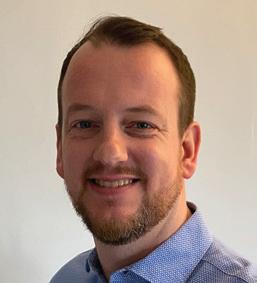
ANGLIAN WATER SERVICES INTEGRATED WATER-MANAGEMENT
LEAD GEORGE WARREN
I have no doubt that by 2040 we will look back at our current practices and scratch our heads. Why, in 2023, were we building houses that used world-classquality water to flush our toilets? My six-year-old has already asked me this question. My attempts to respond sound pretty pathetic.
We need to start building futureproofed developments, with a dual supply pipe to allow for lesser-quality water for this. This can reduce the energy it takes to treat water to this unnecessarily high standard, reducing pumping requirements by using local water. And it uses water currently considered a risk, such as flood waters.
Retrofitting is expensive and, sadly, I don’t see this changing any time soon. It is so much cheaper to install dual supply during construction. How much less, I hear you ask? We hope the EWSC project will answer this, offering a clear route for delivery and long-term stewardship of these assets.
We must remove the barriers to delivering this critical infrastructure in all new housing. The homes we build today will be here for the next century at least. The sooner we install this additional pipework into developments
and buildings the better. Otherwise, we face a huge, expensive task to retrofit our building stock to prevent the UK running out of water.

CIWEM DIRECTOR OF INNOVATION AND DELIVERY PAUL SHAFFER
People and water are inextricably linked. To deliver water-smart communities people need to be front and centre. The impact people have on water and the impact of water on people has been important for millennia – and we need to work with people to manage the challenges we face with too much, too little and the wrong quality of water.
The choices we make in land use and economic development all have implications for how we manage the water cycle. The benefits of integrated water management, where the water cycle becomes an integral and visible part of our places and spaces, is becoming realised.
Water-smart communities provide people with opportunities to become aware of their role in managing the water cycle, appreciating interactions that deliver opportunities that are ecologically rich, attractive and economical.
We can’t bury water, hiding it underground. We desperately need to seek opportunities to integrate water into our developments, where we can appreciate it and better understand mutual dependencies.
Improving legibility and understanding will enable us to deliver water-smart communities and multiple benefits that include improvements to the quality of our local environment and the quality of life for communities. People, whether it be practitioners who design developments or the communities that live there, are integral to water-smart communities.

UNIVERSITY OF EAST ANGLIA ASSOCIATE PROFESSOR TOM HARGREAVES
A water-smart community plays an active role in shaping sustainable water futures. Communities themselves must play a significant role in their development and management.

“By 2040 we will look back at our current practices and scratch our heads. Why, in 2023, were we building houses that used world-class quality water to flush our toilets?”
Our research at the University of East Anglia (UEA) is exploring the different types of water communities that already exist and understanding how communities themselves can be more productively engaged.
Water-smart communities are important because they offer a chance to develop new relationships between water companies and communities. There has been a historical tendency in the
24

water industry to treat people as passive consumers who want as little as possible to do with water other than paying the lowest price.
This has resulted in communities being kept at arms-length and excluded from decision-making, while water companies get on with implementing solutions.
Which has, in part, contributed to low levels of public trust in water companies.
Water-smart communities offer an opportunity to challenge this type of relationship and engage people as active citizens who care about, and are invested in, the development of their own communities and local areas.
A key challenge will be to inspire a culture change in the water industry to get beyond large-scale technofix solutions.
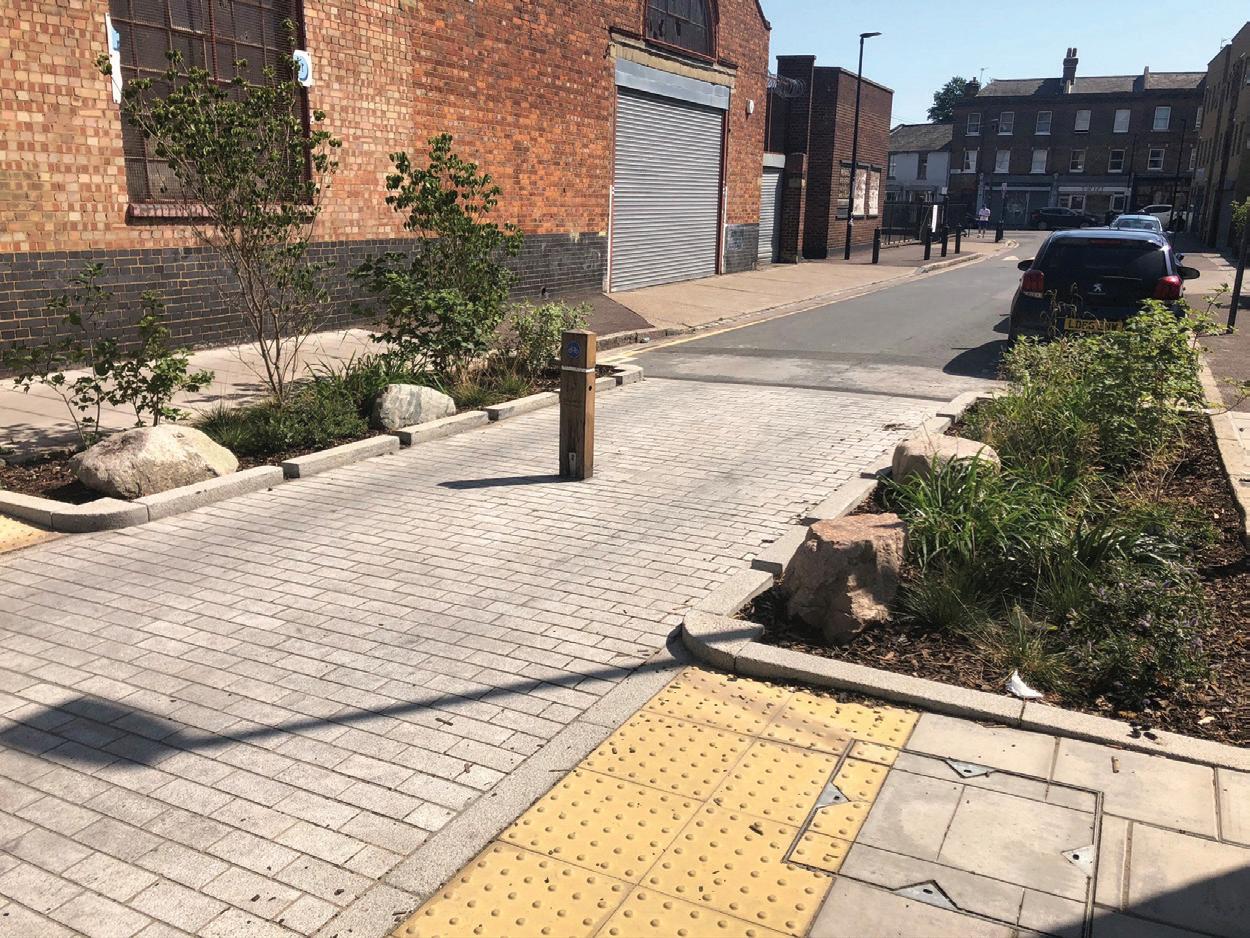
25
XXXXXXXXXXXXXW OPINION
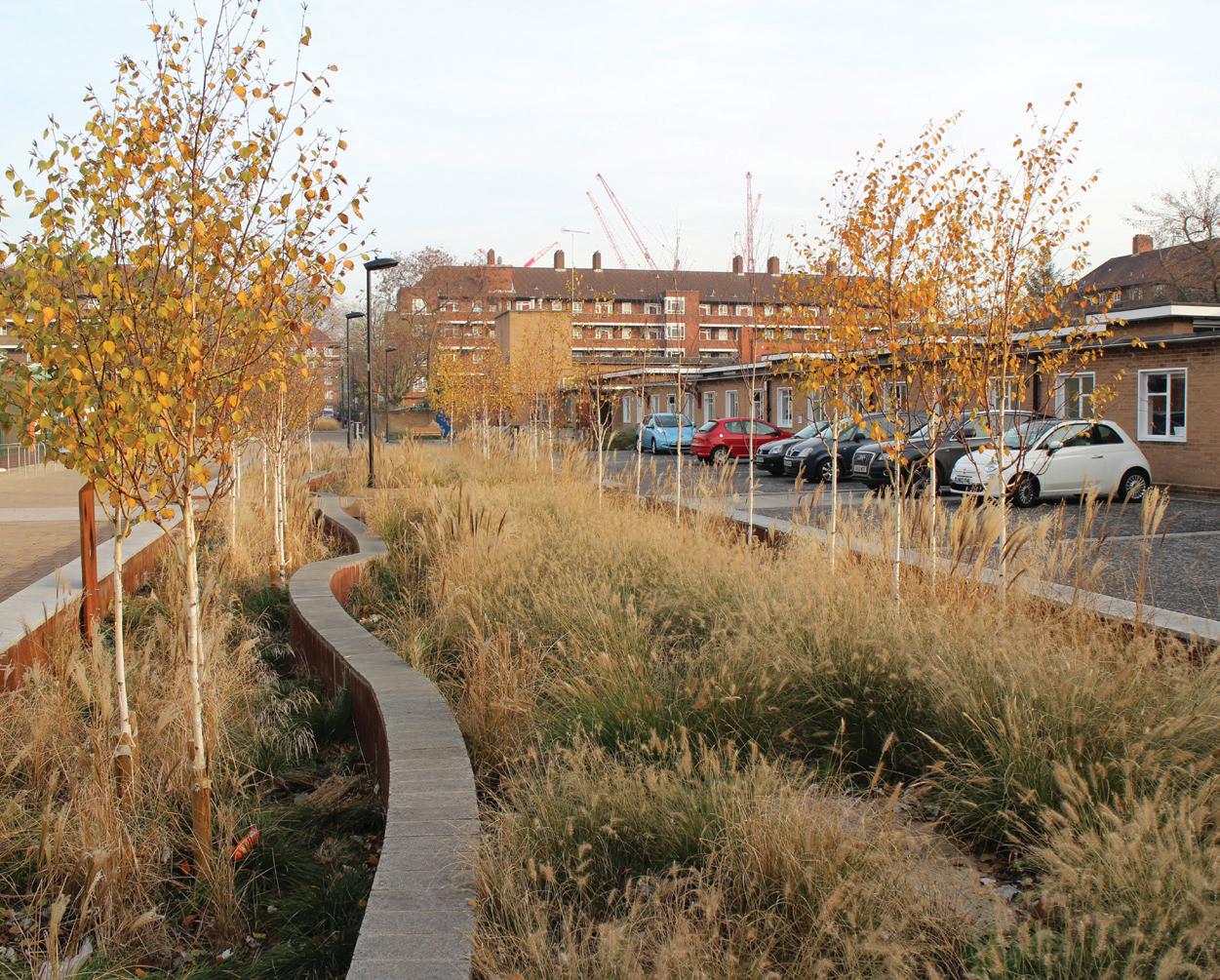
Current engineering-based approaches often shut out societal engagement so that even when people want to get involved or develop innovative solutions to water problems, these solutions are often discouraged or are hard to realise.
To try to change this, our research at UEA will explore the diverse forms of engagement with water resources that already exist in different communities and examine how different kinds of water infrastructure generate and encourage different forms of community engagement.
The challenge will be to identify the most important lessons to inspire new, more diverse and extensive forms of societal engagement and to work out how build them.


UNIVERSITY OF MANCHESTER PROJECT LEAD
CLAIRE HOOLOHAN AND RESEARCH
ASSOCIATE
ELLA
FOGGITT
To meet society’s economic and social goals without compromising on sustainability, effective management of limited water resources is vital. New homes need to be flood- and drought-resilient and enable residents to use water sustainably.
The urgency of achieving this is amplified by anticipated climatechange impacts. Expected changes
in temperature and rainfall will have implications for supply and demand, and extreme events such as drought and flood are likely to become more frequent.
Hardware interventions such as SuDS have an important role to play but we need to look beyond technical solutions to realise water-smart communities’ full potential. The software – by which we mean the social aspects of water systems – also provides potential avenues toward more sustainable water futures.
We must also consider how watersmart communities support a socially just transition to climate-change adaptation through, for example, investigating the affordability of these homes. How much and how often people use water in their everyday routines is shaped by the design of their home and the infrastructures to which they connect.
We need to design water-smart communities that support sustainable domestic practices, to help the people who live there to use less water. That’s also the answer to cutting domestic energy use and carbon emissions, and to reducing the quantities of unflushables that enter our sewer systems.
Each of these challenges requires us to consider who will live in these watersmart communities – and how – to be able to design them to support sustainable lifestyles. And for water-smart communities to deliver, they must recognise the diversity of people who will live there, and how different routines affect ordinary water use.
Bringing in new coalitions of actors to overcome siloes in design opens an opportunity to learn about joined-up approaches to resolving challenges. We learn about these by reflecting on lessons learned from existing mains-limited communities and demonstrations.
We therefore take a long-term approach that reflects on water-smart communities’ pasts, presents and futures to understand how these homes meet social and environmental objectives, now and into the future.

SOUTHERN WATER
FUTURE GROWTH
LEAD SANDRA NORVAL
Water is the essence of life. But for many of us, it’s out of sight, buried in infrastructure that magically delivers fresh water and takes our waste away. We assume it will always just be there.
Water companies have statutory duties to supply water cheaply and sustainably. As the climate changes and as population and economic growth put pressure on our supply, it is time for us to rethink how we do this.
Since the Victorian era, we’ve developed new technologies and approaches that enable us to be smart about how we find, deliver and make our water more sustainable. Delivering that shift requires a new way of working with infrastructure.
We need to change how we plan for water, design in more sustainable behaviour and operations, and change policy so that we all value water as the essential resource it is. The EWSC project positions us to shape how UK communities work with water. It brings together communities, academics, professionals and policy leaders who will make a difference.
This project will bring water back into focus. It will help people to understand why water matters. It will shift how we access it, move it, use it and return it into the water cycle, completing the loop to benefit human life and wildlife. Between us, we can shape the future we need to lead positive lifestyles in a changed world. o
Find out more about the Enabling Water Smart Communities project: ewsc.org.uk
26
SuDS schemes support greener, more wildlife-friendly towns and cities
OPINION
PICTURE CREDIT
GREENER INFRASTRUCTURE FOR RIVER AND FLOOD PROTECTION WORKS


GeoGrow are a specialist geotechnical construction company, offering greener solutions for retaining walls and erosion control. They work collaboratively with major contractors, the Environment Agency, Local Authorities and others looking for alternatives to ‘grey’ building materials that have a positive impact on the environment.
GeoGrow are the manufacturers and designers of the Rootlok Vegetated Wall System, a vegetated alternative to concrete, gabions and other hard engineered systems – retaining level changes up to 10 metres or more. This UK-manufactured nature-based solution is made up of a series of earth-filled bags, held together by interlocking plates made from 100% recycled plastic. The bags themselves are strong and long-lasting, with a 120-year lifespan, and can effectively sustain a wide range of vegetation in a variety of settings, including river banks. Furthermore, the modular system can easily integrate options for habitat creation – including aquatic and other wildlife.
Vegetated wall systems offer a permanent nature-based solution for river and flood-protection works. Structures can integrate a variety of plant species and wildlife habitats maximising its potential biodiversity gain when planned effectively.
EXAMPLES OF THEIR WORK
St Blazey Flood Alleviation Scheme
Working collaboratively with Kier Infrastructure, GeoGrow delivered a design and build solution to repair a failing embankment as part of the St Blazey flood scheme, a St Austell Bay Resilient Regeneration Project. GeoGrow provided early assistance to develop the solution to
retain a section across the bank of Treffry Canal at Par St. Blazey. The scope included water management and full installation of the retaining wall works. They designed a geogrid reinforced tie-back solution that would cope with rising water levels. Pre-seeded bags were utilised to remove the need for hydroseeding within the watercourse, ready for immediate vegetation establishment.
The StARR project aims to reduce the flood risk to more than 800 homes and business in Par and St. Blazey, a partnership project between the Environment Agency, Cornwall Council, University of Exeter, South West Water and Westcountry Rivers Trust. The Rootlok wall has restored the failing bank and will provide sustainable, vegetated erosion protection along the river, helping to prevent future flooding in the area while creating a functioning ecosystem along the riverbank.
Kenwater Watercourse, Leominster Working in partnership with the Environment Agency and Jackson Civil Engineering, GeoGrow were tasked with delivering a design and build solution for reinstating a failing stone retaining wall along the Kenwater Embankment in Leominster, a site of special scientific interest. The vegetated wall system will provide stability and erosion protection to the riverbank slope while offering a natural, discreet finish. The modular system allowed existing Dwr Cymru Welsh Water assets to be tied-in to the structure along the bank, meaning no other system was required. GeoGrow provided assistance to the Environment Agency to help with local community relations and strengthen perceptions of the work being carried out.
Leeds Flood Alleviation Scheme Phase 2, Kirstall
Mott MacDonald and Bam Nuttall approached GeoGrow to design a solution for a section of a collapsing riverbank, as part of the Leeds Flood Alleviation Scheme Phase 2. GeoGrow designed a tiered vegetated wall system at a height of 3.1m with geogrid reinforcement, a solution capable of withstanding the flow rates and flood levels along the River Aire. GeoGrow installed the vegetated wall system, butting up to an existing gabion wall that was in situ. The works team utilised a harness and lifeline safety system to ensure a safe method of building so close to the rivers edge.
The modular and flexible nature of the Rootlok system allows a variety of plant species to be used, as well as incorporating a tree planting scheme. Wildflower seeds were hydroseeded across the wall and a variety of shrubs were planted along the top of the bank, maximising the potential biodiversity gain provided by the system.
HOW CAN GEOGROW HELP
GeoGrow’s in-house teams work in partnership with clients to develop a solution that delivers maximum value while complementing and promoting the natural ecosystem in which they are being built, offering greener solutions for retaining walls, slope stabilisation and erosion control in both land and water applications.
Alongside green retaining wall construction, GeoGrow provide a specialist hydroseeding and environmental spray service nationwide, providing vegetation and erosion control solutions for slope conditions up to a gradient of 3:1. They offer a range of products that provide superior erosion control and slope stabilisation without the need for traditional erosion control systems. o
To discuss how GeoGrow can support you with river and flood protection works, please get in touch with the team, who would be happy to assist you. Contact Kirsty Allsopp at sales@ geogrow.co.uk or visit their website at www.geogrow.com

27 ADVERTORIAL

PAINTING CHANGE
Art, environment, mental health and me
Art has the power to communicate and inspire change –and to share very personal stories. Ally Zlatar reports
For ten years of my life, I relied heavily on the medical industry, taking many pills and medications to manage my health. I suffered from a severe eating disorder that caused osteoporosis and heart palpations, and lived with many other difficult effects.
Every month, I brought home two big bags of medication: pill trays, medicine bottles and those long instruction manuals no one ever reads. I needed all these medications, but I felt guilty, knowing that contributed to a negative impact on the environment. I felt powerless about the waste this created as I struggled to recover.
Production and disposal of pharmaceuticals has a significant environmental footprint – from the energy and resources it takes to make them to the chemicals they release into
waterways on disposal. Our growing demand for medications – legal and illegal – is making this problem worse.
Art gives me a unique platform to raise awareness and inspire change. I started to share my art and voice with pharmaceutical companies, exploring my own experiences to highlight how the industry affects our environment. As a painter, I tried to process these feelings.
SHOW/TELL
I spotted the chance to use the power of art to unite the medical and environmental sectors – to raise awareness and inspire others to act. I created a series of paintings and installations to highlight the environmental cost of pharmaceutical waste. The series Popping Pills, Popping Bills explored how I felt I was drowning in my medications.
Another series of paintings, Out of Air, explores rising sea levels. I have always been drawn to the ocean and its powerful, ever-changing beauty. But as the reality of climate change has become more apparent, I am increasingly concerned about our oceans’ future and the devastating impacts of rising sea levels.
Using my art for activism has created new ways to be resilient, to engage on a personal level. It has helped me to affirm and rebuild my sense of hope and purpose
Out of Air explores my struggles with those fears. The paintings show me drowning, struggling to stay afloat in a rising sea, gasping for breath. They seek to convey the fear and desperation I feel in the face of the climate crisis, to capture the raw and
28
Out of Air II: my rivers are filled with toxins and chemicals leak through my veins


emotional, and to depict my own struggles, feeling powerless and hopeless facing such a vast and complex issue. But I also wanted to explore resilience and determination. I am still breathing and there is hope.
Despite all the challenges and dangers of rising sea levels, I show myself determined to fight – to survive and make a difference. These paintings sparked important conversations about how climate change impacts our oceans and why we need urgent action.
I also started to share my story and the message behind my art. Hearing about how I’d relied for so long on the medical industry seemed to resonate with people. But at the same time, my art and activism gained traction.
I felt overwhelmed, all over again, by the enormity of the problem compared to my efforts and ability to change things. It felt like, no matter what I did, it would never be enough to make a real difference. Now, I know this was climate anxiety – a


As an artist who is also an activist, I see the power of art to drive systemic reform
paralysing fear, feeling hopeless to tackle this vast and complex issue.
Thinking about the damage already done and the continued destruction of our planet was overwhelming. Big issue or small, I struggled with feeling guilt and responsibility. Is it fair to have children in this world? Is it OK to buy fruit in plastic containers?
With news and social media reporting environmental disasters and devastating climate effects, I felt we were hurtling into an uncertain future. I sought refuge in the one thing I control: painting. I sought to process these feelings, to share my fear and worries in the space that’s safe for me.
Using my art for activism created new ways to be resilient, to engage on a personal level. It has helped me to affirm
and rebuild my sense of hope and purpose. I can’t solve these problems alone, but I can use my art and my voice to raise awareness and inspire change together.
Now, I use art as a tool for change, to inspire others to act too.
My art and activism have pushed the medical industry to consider its environmental sustainability. That shows the power of art to inspire and motivate people to act to make positive changes. As an artist who is also an activist, I see the power of art to drive systemic reform. Creative voices bridge divides, inspire dialogue and make positive change in the world.
I am grateful that I can use my art in this way and will continue to use it as a force for good in the fight against climate change. o
University of Glasgow lecturer and artist Ally Zlatar was shortlisted for CIWEM’s Young Environmentalist of the Year Award
29 ARTS
Ally Zlatar, her paintings, left, and meeting Prince William, below

ATTENUATION INSTALLATION JUST GOT FASTER WITH WAVIN
Wavin’s new AquaCell NG attenuation tanks were installed in record time at a 110-home development for Bellway Homes.
When M & J Evans won the contract with Bellway Homes they committed to supply chain excellence, building in a sustainable way, showing true commitment to the needs of the community both now and in the future. They needed a stormwater solution that also delivered on this promise.
THE STORMWATER MANAGEMENT CHALLENGE M & J Evans needed to find a stormwater solution that had superb sustainability credentials while still being of optimum functionality, easy to install and fit for the long term. With many houses being built on the site in Worksop they needed to work quickly and efficiently without impacting on other trades also working on the site. There was limited storage space on site and limited access times for deliveries due to the busy nature of a live site. The attenuation tank installation
also took place during a rather frosty December with temperatures dropping to as low as -7°C. It was therefore imperative for the safety and comfort of the installation team that they could work with a product that was quick and easy to install. The tank installation needed to be completed within five days, so M & J
Wavin’s new attenuation and infiltration solution, AquaCell NG

30
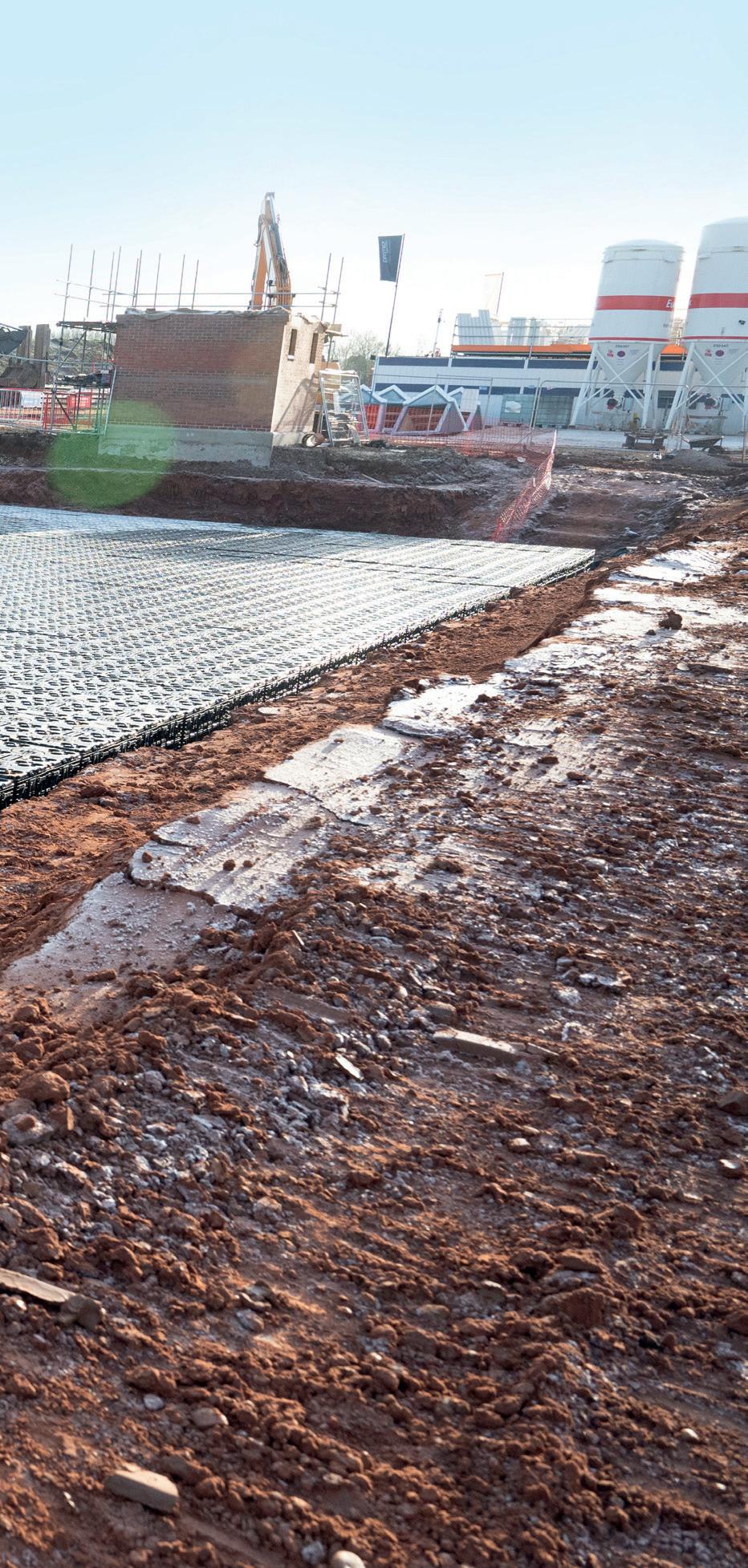
Evans were looking for a tried and tested solution that met their needs.
NEXT GENERATION ATTENUATION WITH AQUACELL NG
M & J Evans has worked closely with Wavin for a number of years and approached them to find the perfect solution to their needs. This is when they first discovered AquaCell NG.
Tried and tested in Europe, the product meets their needs for:
o Sustainability
o Ease of installation
o Ease of transportation
o Ease of storage
o Inspectability
o An end-to-end stormwater solution.
COMPACT DESIGN
The compact design of AquaCell NG further bolstered the commitment to sustainability

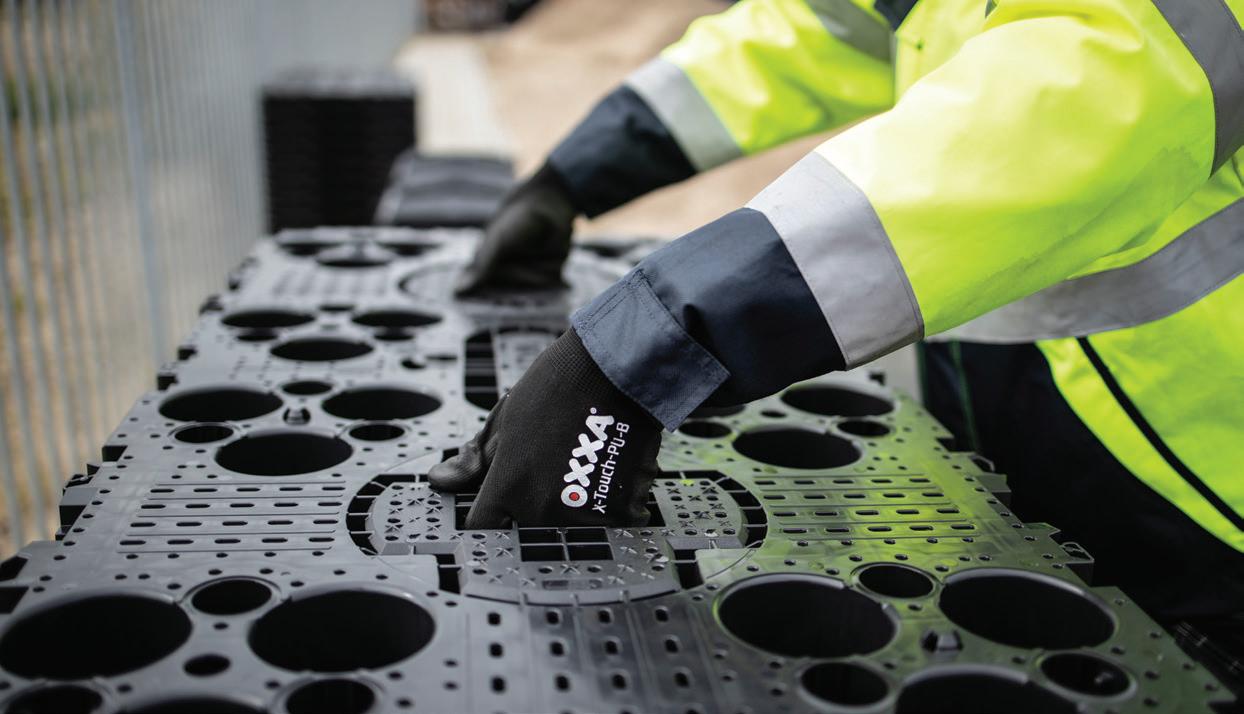
as the whole project was delivered in just three lorry loads, a marked reduction in CO2 emissions being a quarter the number used for similar projects in the past. This also eased congestion on site with less deliveries planned and a smaller storage footprint required.
EASE OF INSTALL ATION
The project was completed within good time considering the challenging weather; installation was complete in just three days. This was thanks to the lightweight, push-fit and click-together design. M & J Evans also utilised Wavin’s technical team for advice on the designs to ensure the smooth process between plant equipment transfer, excavation and install. Wavin recommended AquaCell NG as this has been tried and tested across different countries in the Wavin collective and we were sure it was the optimum solution for their needs.
SUSTAINABLE ATTENUATION
The AquaCell NG product is made from 100% recycled materials and is 100% recyclable at end of life, so it ticks all the right boxes for Bellway Homes when considering a sustainable supply chain.
They were sure it was the optimum solution for their needs.
“We had a design brief to achieve for a residential development in Worksop of 110 new-build plots for our client Bellway Homes, and due to our close working relationship with Wavin, we were offered a new product that looked fantastic,” explained Adam Newsome, contracts manager at M & J Evans.
“We feel very privileged to be the first contractor and project in the country to install the new Aquacell NG product on a live site and from start to finish, the installation went extremely smoothly. The product is very easy to be delivered to site and store due to the ingenious stacking system and installation was quick and nonproblematic. As always, the expertise and product support from Wavin representatives was second to none. Overall, we are very pleased with the whole product and installation and will definitely be our preferred product going forward.” o

31
ADVERTORIAL
Wavin’s AquaCell NG install for Bellway Homes
AquaCell NG is simple to handle
Preparations for AquaCell NG installation
AFTER THE RAIN
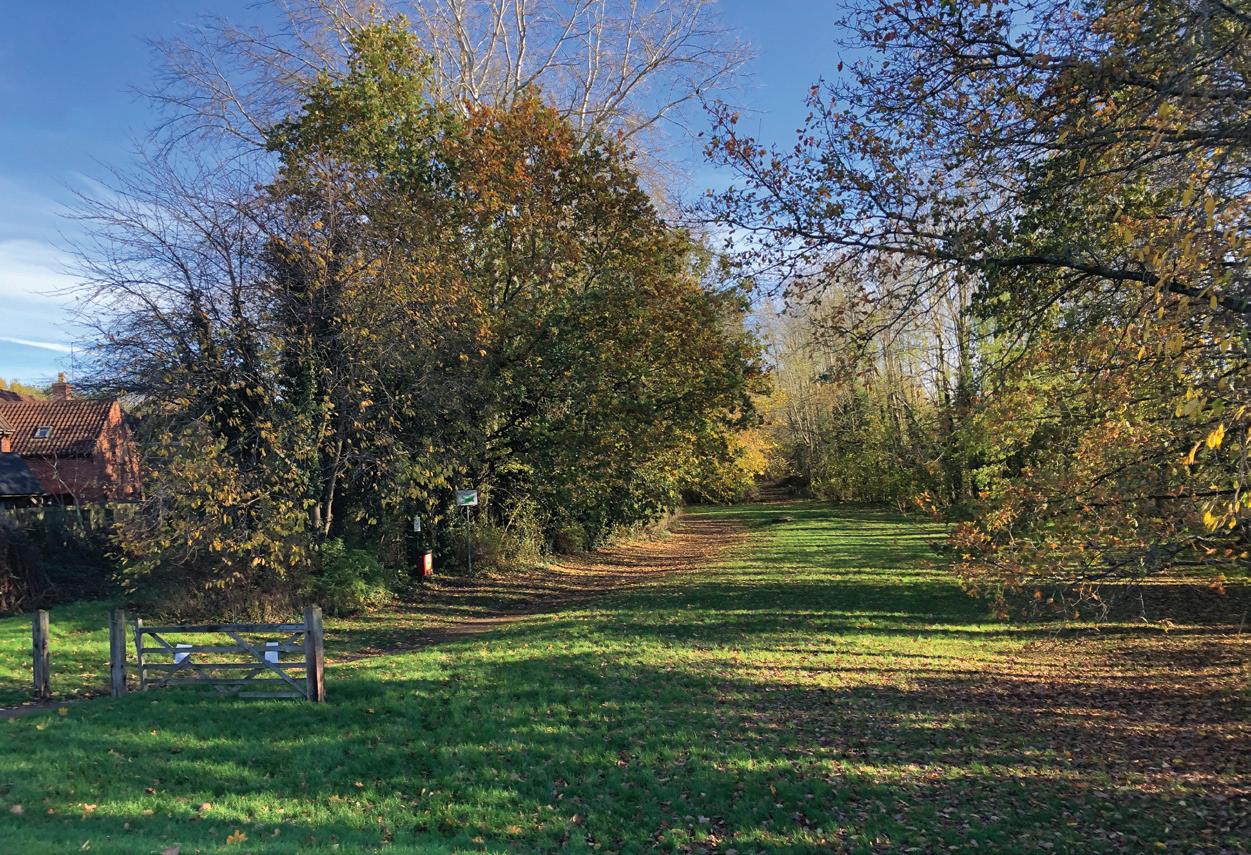
A Northampton pilot project is looking at non-engineered solutions to help catchments, communities and properties to cope with more frequent floods. Karen Thomas reports
“When it comes to engineered flood defences, this catchment already has pretty much everything it can have,” says Alastair Windler. “So when it comes to defending it against future floods, that leaves natural flood management (NFM), plus community- and property-level protection. It’s all we have left.”
Windler is the Environment Agency’s flood and coastal erosion risk management team leader in Northampton. He and his Kettering-based colleague Rhiannon Flowers have spent the day in a community centre in East Hunsbury, talking to local people about their flood risk.
Local-authority flood teams, the Rivers Trust and Flood Re are here too. Flood-resilience campaigner Mary LongDhonau – Flood Mary – is outside in the carpark. Leaflets, posters and local news reports have invited people to ask the experts how to adapt their homes, to visit Long-Dhonau’s Flood Mobile to see how property flood-resilience (PFR) measures might work for them.
The open day invites at-risk
communities to meet the Resilience and Innovation Northants (RAIN) Project team. RAIN is one of 25 governmentfunded pilot schemes under the five-year Flood and Coastal Resilience Innovation fund. The pilot schemes will share their findings – what doesn’t work, what does – to scale up the latter nationwide.
West and North Northamptonshire councils lead the RAIN Project. It aims to make local people and communities more resilient as climate change makes Northampton even more vulnerable to flood risk. RAIN partners are working with farmers and landowners to use nature to hold water upstream in two catchments: Harpers and Wootton brooks.
Downstream, teams work with communities and owners of homes and businesses to explain flood risk and
People can understand climate risk in an abstract way. It’s a leap to consider what it means for you. Those most at risk are often least informed, least likely to have flood insurance
solutions at local, street and building level to encourage people to fit PFR measures. And being a pilot scheme, the RAIN Project is covering those costs.
FLOOD HISTORY
Northampton knows about flood risk. Although named in the Domesday Book, much of the town is new, with 16,000 new homes added in 1970-1985. Residents remember devastating floods over Easter 1998, when the River Nene burst its banks after a month’s worth of rain fell in a day. Two people died and 2,500 properties flooded.
The two councils expect more surfacewater flooding from more frequent, heavier rainstorms. Windler shows a photo of the 2m wall that protects a local retail park from Wootton Brook. In these cash-strapped, climate-vulnerable times, the Environment Agency says these traditional, engineered flood defences are no longer cost-effective.
Instead, the RAIN Project will tackle flood risk upstream, using natural processes to hold and slow water across the Harpers Brook and Wootton Brook catchments. Since 2012, the two councils have logged 350 floods linked to these two waterbodies. The project seeks to calculate and manage flood risk to 20,000 households.
RAIN will trial landscape enterprise networks (LENs), a new system to buy and sell nature-based solutions that project partner 3Keel launched last year with Nestlé. The Rivers Trust’s Tristan Baxter-Smith is talking to local businesses – mostly farmers and landowners – about how the LENs trading community can fund flood-risk solutions.
HR Wallingford carried out a hydraulic survey of the catchments, to work out which properties will flood and where NFM schemes might help. Some places suit NFM schemes; in others, protecting individual properties is the last defence. Modelling suggests 100 homes need PFR to get through future floods.
East Hunsbury will have both. Leaky
32
RAIN Project, East Hunsbury
RAIN PROJECT
dams and bunds will slow and contain Wootton Brook. “Flood-risk management is a jigsaw of many pieces,” Long-Dhonau says. “And we really have the whole jigsaw puzzle lined up in Northampton.”
Smarter modelling will help the two councils’ emergency-planning teams to work at community level, to identify and train flood champions.
“This supports a wider picture of resilience,” explains West Northamptonshire Council flood-risk programme manager Alan Ryan. “When we find and engage individuals as flood wardens, they are also more likely to report other issues – fires, high winds and snow. We plan to design that wider resilience work into this project.”
Northampton knows about flood risk. Residents remember devastating floods over Easter 1998 after a month’s worth of rain fell in a day. Two people died and 2,500 properties flooded
PEOPLE AND PLACES
RAIN’s partners credit the councils –Ryan and his North Northamptonshire counterparts – for instigating the project. At property level, project teams will identify which are most at risk, who is most worried about flooding. That means modelling, knocking on doors and inviting people to new open days.
Surface-water flooding is particularly hard to tackle, Ryan says. When heavy rain overwhelms drainage systems, it may flood one home but leave the neighbours untouched. And when Northampton updated its flood mapping, several properties previously considered low-risk moved from zone one into zone two.
“In both catchments, a small brook gets overwhelmed during severe rainfall,” Ryan explains. “When we updated our mapping, people were concerned to find [their designation had] changed. We need to help people to understand their risk so that they can own and control that situation.”
It’s hard to get people to think about risk, he says. Most people who visited today’s roadshow have lived through at least one flood before.
“And we want to help them, but the worst flood is always the first one; you


won’t be prepared for it. Being pro-active – not reactive – is key. That’s why it’s so important to work with communities. Someone who’s already been flooded can share their story with other local people. It’s hearing those stories – not talking to councillors or the Environment Agency –that builds trust.”
Funded with £6.2 million through March 2027, the RAIN Project will fit homes within the pilot catchments with PFR. The priority is properties that have flooded several times, then those who’ve flooded once, then those most at risk, Ryan says.
Project partner JBA will survey the properties identified as high-risk. “That determines whether the property would benefit from PFR, what kind of PFR and how much it will cost,” Ryan says. “We’ll survey a lot more homes than we’ll install – around 250 altogether – to be sure we don’t miss anyone. But it’s hard to convince people to take these measures, even when we’re paying for them.”
It’s understandable. People can understand climate risk in an abstract way. It’s a leap to consider what it means for you. Those most at risk are often least informed, least likely to have flood insurance. Add to that the cost-of-living crisis, people’s suspicions about officials and door-knockers – not to mention how few people know what PFR is.
Which is why RAIN Project partners say the roadshows and door knocking matter every bit as much as risk modelling and flood surveys. That, and sharing stories with survivors of floods working to manage their risk.
“It’s the knowledge piece that’s missing,” Ryan concludes. “Success will be to leave more properties and people more resilient to flooding. And that’s everything from educating people about flood risk to installing NFM measures 20 miles away that protect them to showing them how to fit and maintain PFR in their own homes.” o
33 RESILIENCE
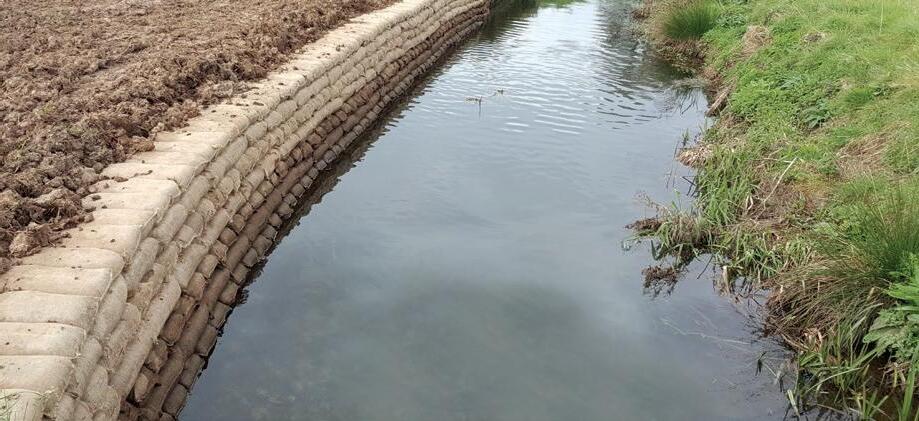
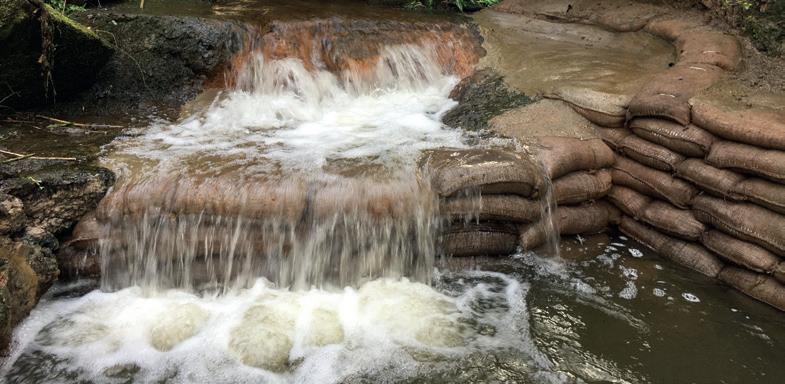













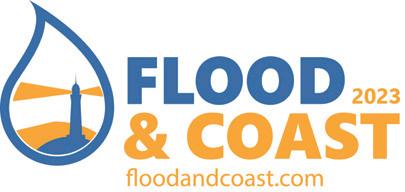


Get flood ready and WIN an iPad Winner will be contacted by email, for terms and conditions visit: resilico.com /privacy-policy To enter The flood compliance platform Scan the QR Code Download the Resilico Connect app Start your free trial Get custom flood alerts, including surface water Create a flood plan for your property • • • • • See us at: Stand C15 and at the Flood Mobile 6th-8th June Hand Placed Concrete Bagwork MSE Soil Filled Bagwork Biodegradable bags and liners enabling the hand placement of concrete in and around watercourses. SoluForm MSE Bagwork is supplied pre-filled with a high quality sand rich topsoil, supplied in a form that is ready to use and assemble on site once it arrives. The real savings are not in material costs, but in the time saved in having a ready-toinstall product, and not having to dewater the watercourse to place the bagwork. It aims to establish and promote vegetation growth on, and inside the bagwork, giving the bagwork structure an improved appearance. carb o n lartuenbrac o n neutral Cost Effective Simple to Use Strong & Versatile Watercourse Protection For more information... T 01629 818450 E info@soluform.co.uk www.soluform.co.uk Simple to Use Strong & Versatile Promotes Vegetation See us at: Stand E9
LIVING ON THE FLOODY SEVERN

Flood campaigner Mary Long-Dhonau helps home and business owners to adapt to risk. Known nationally as Flood Mary, she tours the country with her flood mobile, a trailer kitted out to repel floodwaters. The approach is catching on

Climate change is bringing ever worse flooding to communities across the UK. Riverside communities that have flooded for centuries are being hit harder, more often.
A flood-risk map published this year expects the annual bill for flood damage to rise by more than a fifth within the century – even if the UK meets its climate targets. It already stands at £700 million a year, according to the Association of British Insurers.
The River Severn is tidal. It has always flooded. Roman settlers built embankments around their towns. New modelling suggests its flood peak will rise by 50cm by 2050. Some local people now flood every year, Mary Long-Dhonau says.
“I spoke to one woman from Diglis, right on the Severn. She’d been told to expect the river to flood every nine or ten years. In the last five or six years, she’s had a flood every year. She’s not young and feels it’s getting a bit much.”
People living on the Severn face a stark choice: move or adapt. Long-Dhonau shows people how to adapt their homes to lose less and recover faster. Which is what property flood-resilience (PFR) does.
Planning is everything with PFR, Long-Dhonau says. Engage an accredited PFR consultant, sign up to Environment Agency flood warnings and make a
household flood plan. “When the flood warning comes, your mind turns to spaghetti. Write everything down in advance. Do everything in order. And don’t forget to move your car.”
Long-Dhonau interviews floodies – people who’ve flooded – who’ve adapted their homes. She shares their stories in an eBook.
The results are impressive. One couple in rural Worcestershire knew their home – a former pub built around 1650 – had always flooded. The previous owner had adapted the building: stone flooring throughout, raised electric sockets and installing flood barriers, pumps, a backup generator and damp-proofing.
The couple added secondary flood barriers, puddle and sump pumps, absorbent cushions and a pond vacuum. They raised their air-source heat pump and mounted their beehives on breezeblocks. The house flooded four times during the winter storms of 2019/2020. PFR means they recover quickly each time – without claiming insurance. They’ve survived eight floods.
“They were marooned on Christmas day,” Long-Dhonau says. “But they put their waders on, grabbed a bottle of champagne and drank it in their summer house, mounted on stilts above the floodwater. They even raised a glass to the flood.”
Some interviewees rave about PFR
equipment, others about designing to recover fast. Adapting well takes both. Pumps help a quick recovery – and are part of the PFR package. “All the people I’ve talked to are using them. Some have quite complex systems, including backup if the main pump fails.”
Long-Dhonau reviews PFR products on her website. Maintaining kit is crucial. But kitemarked flood products and insurance to build back better aren’t cheap. “We cannot forget people who can’t afford all that.”
She knows a woman with disabilities who lives on benefits in Todmorden, Yorkshire. With no money to spend on PFR, the homeowner had help from a DIY-savvy son. Her flood plan uses everyday household items.
Small measures – standing furniture in plastic containers or wellies, gaffertaping doors, using a child’s football to seal your toilet, weighing down your sink plugs – can prevent thousands of pounds worth of damage. “You can reduce flood impacts using stuff around the house,” Long-Dhonau says.
Of the Severn floodies who’ve adapted their homes, only one wants to move. “What I take from them is their determination not to let flooding beat them,” LongDhonau concludes. “They don’t want to be forced from home for months.
“Most people who’ve fitted PFR no longer make insurance claims – they don’t need to, thanks to the adaptations they’ve made.” o
Meet Mary Long-Dhonau HonFCIWEM, speaking at this year’s Flood & Coast
FIGHT BACK AGAINST FLOODS
Mary Long-Dhonau’s website: https://floodmary.com
Resilico: an app launching this spring to connect insurers, PFR manufacturers, communities and homeowners https://resilico.com
CIWEM’s PFR course for industry: www.ciwem.org/training/ pfr-industry-training
35 RESILIENCE
Home from home –Long-Dhonau in her flood mobile
MAKING SUDS MANDATORY –SOME DOS AND DON’TS
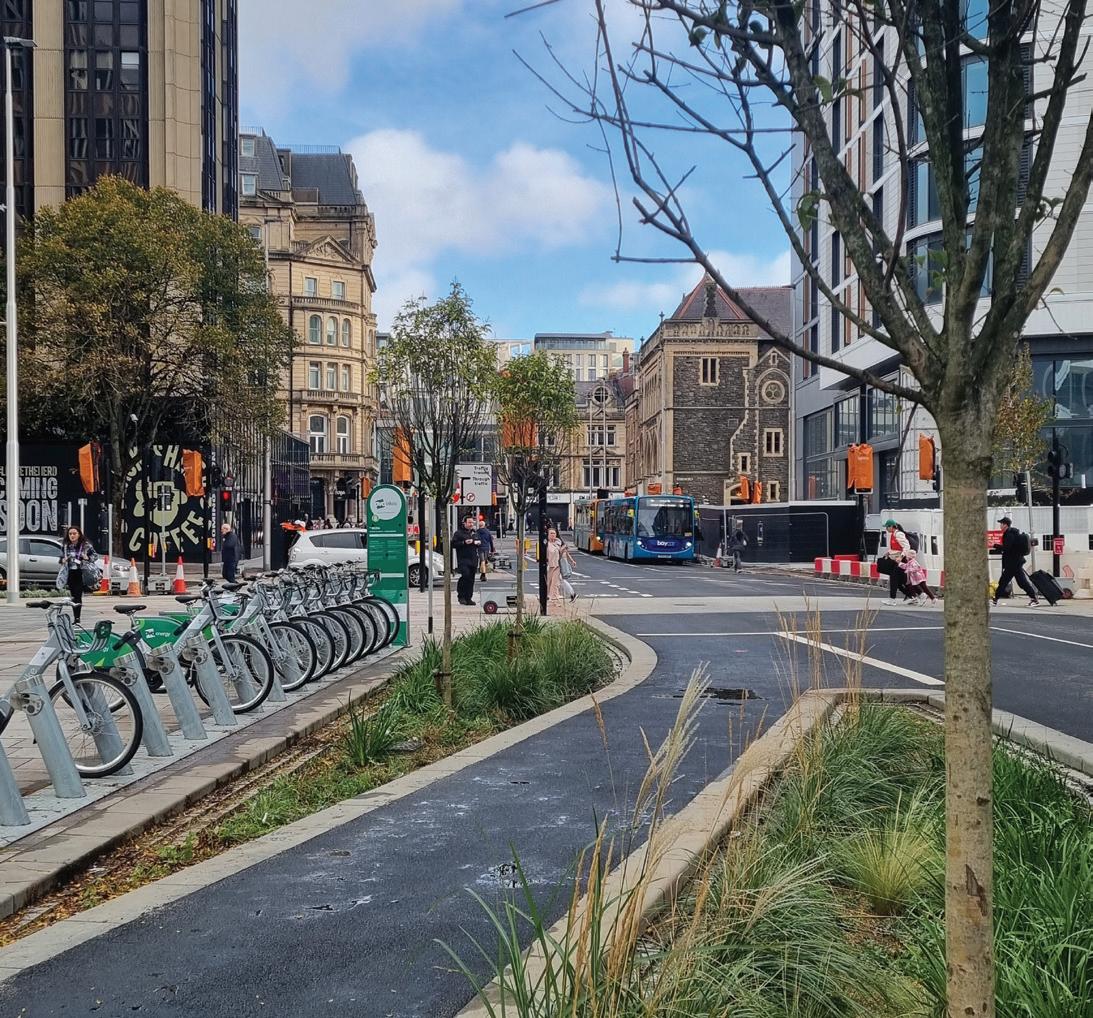




SWales made it compulsory to build sustainable drainage systems into new developments four years ago. As England prepares to follow suit next year, what can it learn from the neighbours?
Ian Titherington shares some tips
chedule Three of the 2010 Flood and Water Management Act will hopefully arrive in England next year, requiring new developments to build in sustainable drainage
systems (SuDS). Using our devolved powers, we did this in Wales back in January 2019. It’s fair to say that in my last role as a council drainage engineer, that decision kept me busy.
A proposed new development triggers the legislation. The drainage systems need approval. The developer must apply to the nearest SuDS Approval Body (SAB) within the 22 local unitary authorities of Wales. The application must demonstrate that the project meets six statutory standards:
o Destination
o Hydraulic control
o Quality
o Amenity
o Biodiversity
o Who owns and maintains the scheme.
36
CARDIFF CITY COUNCIL
ARUP DAN TRAM
ARUP DAN TRAM
CARDIFF CITY COUNCIL
Sustainable drainage in Wales: building in SuDS has made for better designs
Cardiff’s inner-city SuDS schemes offer flood protection and greener spaces
Wales’ strong, focused legislation is grounded in technical standards.
Although seeking SAB approval is quite similar to making a planning application, the decision rests on an engineering assessment. In my four years as a senior SAB officer, the best advice I could give developers was to make all their applications reasonable and consistent.
Wales recently completed a four-year review of national SuDS laws, having proved, beyond doubt, that statutory SuDS leads to better design
Every application is unique. Although there are general principles to follow, SABs must treat each design on its own merits, based on these six parameters.
However, The Environment has asked me to suggest three dos and three don’ts – and I’m always up for a challenge.
DO
o Complete a pre-application check
A SAB pre-app is similar to, but not the same as, an outline planning application. The pre-app checks the design is viable before you submit the plan or finalise the site layout. A good SAB pre-app will minimise loss of development density and offers you your best chance of SAB approval success. It simply leads to better design.
o Design for human nature, not just hydraulics
When you design the site’s layout for SuDS, think about how residents, employees, visitors and passers-by interact with their surroundings. Position features so that people won’t walk, build or drive over them, to reduce the risk SuDS features get messed up.
Always think about the desire paths that people and vehicles follow – don’t stick to the letter of the highway-design manual. Put up signs to explain how local SuDS features work. If the project is a retrofit, consult until you drop. The more conversations you have, the more chance you have to win over residents.
And the more widely the design is accepted, the more people will look after it once it’s built. Always cost adequately for consultation.
o Support and supervise installation
A rain garden is civil engineering that is landscaped, not the other way around. But many contractors, who’ve never installed SuDS features, dismiss them as end-of-contract “green stuff”. I don’t mean to criticise, but until we build up wider understanding and acceptance of SuDS, this is how construction contracts work.
Contractors need advice and support on how to install and price for SuDS. They should not be picking up the tab for a poor design. Soil specifications and levels, even plant locations, are critical to SuDS installations; do more to support the contractor.
DON’T
o Apply for planning first
Any competent SAB officer will reject any project that submits its full planning application ahead of the SAB pre-app meeting. Being rejected forces you to withdraw your planning application. That delays development.
This mistake is the most common reason why SAB applications are rejected. The SAB process exists so that you design for surface water at the start – not the end – of a design. Don’t expect sympathy if you get it the wrong way round.
o Take shortcuts with designs
I recently stumbled on the worst SuDS installation I have seen in the UK – and that’s quite a boast. I’ve seen some shockers. The designer had clearly never visited the site and simply assumed its levels, slopes and soil levels. Perhaps they used Google Earth or Google Maps? They kept very quiet about the consequences – my tip-off came from a contractor. The scheme was an embarrassment that defied every SuDS principle – and the basic laws of gravity. Always visit the site – your design and installation success depend on it. Yes, you can use video to check the site when you’ve finished, but you can’t design SuDS remotely and expect success.
o Be high maintenance
In my experience, high maintenance leads to no maintenance. I have never signed off a SAB approval that demanded significant or frequent maintenance. I’ve worked long enough in this industry to know that maintenance won’t take place.
In SuDS designs, conveyance, quality and storage happen between the finished-floor level and the outlet-invert level. That’s where the magic happens with SuDS. Schemes’ designs stand or fall on where you install hydraulic head. The deeper you go, the higher your costs and the fewer your maintenance options.
The more visual you can make the maintenance – keeping it at surface level – the easier it becomes to spot problems and to solve them. Once you bury a maintenance feature, out of sight is out of mind. Yes, there are exceptions to that rule – but not many.
WHAT CAN WE LEARN?
As a SAB engineer, I could offer any number of top tips to design and implement great SuDS schemes. But these six main points should help budding English SAB officers to embrace their new roles.
If the project is a retrofit, consult until you drop. The more conversations you have, the more chance you have to win over residents
Wales recently completed a fouryear review of national SuDS laws. Government plans numerous small changes in coming years to improve Welsh drainage legislation, having proved, beyond doubt, that statutory SuDS leads to better design.
We need to see surface water as just one of many supply services a new site will need – along with telecoms, gas, clean water and electricity. Out of all of these, surface water is the hardest to design in. Schedule Three ensures developers design for surface water first, not last, and that in doing so, they deliver multiple benefits. o
Ian Titherington is the Welsh government’s senior advisor on sustainable drainage. A former drainage expert with Cardiff Council, he led the capital’s SuDS Approval Board when Wales made sustainable drainage systems mandatory
37 SUDS
Providing safe, sustainable, drinking water, globally.
Water
is one of the fundamental assets of humanitarian aid. With the growing number of displaced populations and clean water access issues exacerbated by climate change, water aid is more critical than ever before.
Access to clean water is crucial for everyone. Poor quality water can lead to gastrointestinal diseases which can quickly spread to pandemic levels. The consequences of not having access to clean water are dire, as the average person can only survive for three days without water before incurring significant organ damage.
Water supply systems in remote communities often only provide basic filtration for immediate use, without concern for water storage - leading to poor water quality and potential legionella issues.

“The PaquaVida Water Purification System –brainchild of British engineering, design and manufacturing company, Paqua – has been developed to provide a solution to this problem.
This sustainable self-sufficient water purification system delivers clean drinking water continuously and affordably where it’s most needed in areas of the world that are completely off-grid or have an unreliable power supply. The system can draw from almost any freshwater source, however heavily contaminated, to reliably provide safe drinking water that can be used immediately or stored for future use safely, alleviating the need for importing bottled water.
Our mission from the start was to design a better and easier way to help more people access clean water. An estimated 2 billion people worldwide lack access to drinking water and it is predicted to become more scarce. Increasing pressure on water resources means that it is up to innovators within the industry to challenge existing technologies that address the water needs of communities around the world. PaquaVida systems are engineered and designed to focus on sustainability, with intelligent use of power and earth-friendly technologies providing a watersmart, efficient and cost-effective solution.
– Paqua Founder, Simon Escott

”
Follow us on:
Innovative process
As well as being highly effective against source water contaminants, PaquaVida’s ground-breaking technology offers great advantages over standard water purification systems. The system is proven to EU Drinking Water Directive 98/83 and has the smallest carbon footprint of any water purification system on the market.
Energy-efficient
A key problem in accessing clean safe drinking water is that water treatment can be energy-intensive. The PaquaVida system operates with very low running costs and requires minimal power as it can run from solar and/or wind power, so it is well-suited to being run off-grid or in remote locations.
Practical
Typically, many water purification systems fail due to a lack of maintenance. PaquaVida systems are fully autonomous and selfcleaning, so require very little maintenance or operator intervention as they collect and transmit key performance data to our user and support team. The systems continuously monitor water quality to ensure that quality needs are met consistently.

please visit www.paqua.co.uk

For more information about PaquaVida,
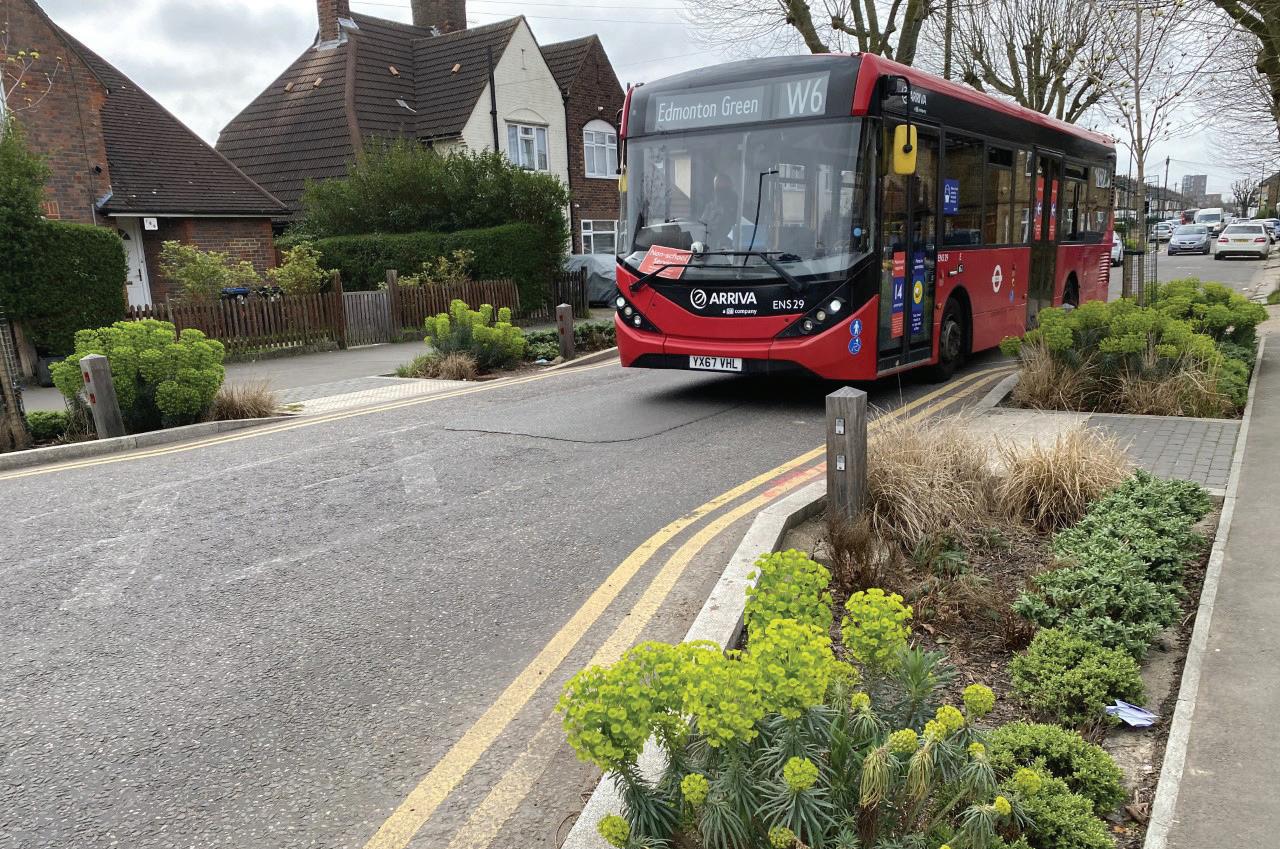
BREAKING DOWN THE BARRIERS TO DELIVER GOOD SUDS

IExpect to hear a lot about Schedule Three and
sustainable drainage systems (SuDS) at Flood & Coast this year. What is it and why does it matter? Kirsty Tolson fills in the blanks
f you work in flood-risk management, chances are that you’ll have heard rather a lot lately about the UK’s 2010 Flood and Water Management Act (FWMA). You may even be spending time pondering FWMA’s Schedule Three, in which the act addresses sustainable drainage.
Schedule Three:
o Sets out standards to design, build, maintain and operate sustainable drainage systems (SuDS)
o Requires construction work whose drainage implications affect the ability of land to absorb rainwater to secure approval bodies’ consent
o Requires developers to seek and secure approval to connect to public sewers before construction starts
o Sets out how to adopt drainage
systems for ongoing operation and maintenance.
To understand why Schedule Three of the FWMA matters so much, let’s go back to summer 2007. Widespread flooding affected 55,000 properties, leaving half a million people without power. Thirteen people died.
The summer storms brought unprecedented rainfall – breaking all records since 1766. It was the UK’s largest emergency since the Second World War. Afterwards, the government commissioned Sir Michael Pitt to lead an independent review. His report recommended 92 ways to reduce the risk of another catastrophe on this scale.
But the UK wasn’t alone. There were more than 200 major floods worldwide in 2007. The European Union implemented
its own Floods Directive, setting out legislation for member states to assess and manage flood risk that underpinned the UK’s 2009 Flood Regulations.
All those policy changes came to a head in the FWMA. It clarified roles and responsibilities for managing flood risk. It sought to improve the UK’s flood-risk management and created Lead Local Flood Authorities (LLFAs).
FUTURE RISK
But why, 13 years on, are we still discussing Schedule Three?
Today, at least 3.2 million UK properties are at risk of flooding from surface water. Our changing climate increases our flood risk. The government’s climate-change risk assessment names flooding the UK’s most pressing climate threat. Among our biggest flood-risk challenges is how to manage surfacewater runoff from new developments.
In 2014, the UK housing ministry announced that the planning system would encourage SuDS in place of Schedule Three. Government worried
40
GEORGE WARREN
that Schedule Three set standards and required approaches that would slow delivery of new homes.
A year later, government announced that “all major developments” – those building ten or more houses or whose sites spanned more than a hectare – must include SuDS that met Defra’s nonstatutory technical standards.
But the industry found those standards too weak; they are voluntary and lack mechanisms to maintain systems after construction. The outcome has been badly designed SuDS – schemes that fail to improve biodiversity, water quality, amenity, nutrient neutrality, water resources, urban cooling, air quality or placemaking.
Meanwhile, the UK has built at least 1.5 million new homes without SuDS since 2010. This puts our ageing sewerage systems – many of them already at or over capacity – under even more pressure. And that only adds to sewerage pollution, as water companies discharge excess flows from combined sewer outfalls and wastewater treatment works into streams and rivers.
It wasn’t all bad. The UK has had worthy SuDS champions – people and companies that recognised these schemes’ importance and sought to implement Schedule Three’s intentions. Susdrain and CIRIA issued excellent guidance. Across the country, many showcase SuDS projects proved the many benefits these schemes can create.
These and others lobbied long and hard, through 2016-2021, to implement Schedule Three. The turning point came in 2021, after catastrophic flooding hit more than 1,000 properties in London and elsewhere. Government asked the National Infrastructure Commission to review how to reduce the risk of surface water flooding.
The NIC published its findings last November, calling on government to implement Schedule Three before the end of this year. Defra responded with its own review in January, agreeing that Schedule Three should be implemented.
COSTING THE DETAILS
That might sound simple. It isn’t. Enacting the schedule provides only a regulatory framework for sustainable drainage. Government must refine the final details of the process, its scope and thresholds. LLFAs are already statutory

consultees in the planning process. Some were already preparing to become SuDS Approval Bodies (SABs). LLFAs look set to implement the approval process.
But we must think carefully about these changes and the burdens they place – on regulators and on developers. We need transitional arrangements to avoid delaying developments that have reached an advanced stage of planning. That means agreeing the threshold for what we consider to be construction work with draining implications that trigger Schedule Three.
To avoid overburdening SABs, we must define which projects are exempt – for example, drainage systems come under other legislation, such as permitted development rights to pave over front gardens. We need to work out the finances – what it costs to set up and run the SABs and to operate and maintain the SuDS schemes they authorise.
The good news is, we have a precedent. The Welsh government implemented SABs in 2019 and has reviewed its progress. In May 2021, the Welsh Local Government Association published a report, Measuring the effects of the sustainable-drainage legislation on SABs, that found that SABs were running at a loss.
The review found that Wales had underestimated the skills and capability it would need to deliver the new legislation. Experience will build SABs’ competency with time. That chimes with a recent skills survey, which found that LLFAs needed more support to deliver good SuDS to benefit water quality, biodiversity and amenity.
LLFAs already need more skills. Climate change is putting them under growing pressure. LLFAs need more training and more staff to take on the role of SABs. Organisations including CIWEM and CIRIA will be critical to deliver the
training and professional development that SABs will need.
TOO MANY COOKS
The Pitt Review worried that involving too many parties would fragment how we manage flood risk. Defra’s Schedule Three review argued for expanding the responsibilities of water and/or wastewater-treatment firms to include adoption of SuDS. This has already happened in Scotland.
We need to consider the fees to approve and inspect SuDS, as well as the operational and maintenance. Wales’ experiences show that commuted sums could work, but we must consider their value and how they apply, to avoid SABs creating additional costs.
We could develop a standard schedule of commuted sums to begin to address this. An alternative approach would be to have the water company manage payments from customers. This is more straightforward if the water company is adopting SuDS.
Our industry has come a long way to promote and deliver sustainable drainage since the 2007 floods. But of course we must do more. Schedule Three’s legislative framework addresses some barriers that prevent good-quality SuDS – it will still take work to implement. But we must all work to get there quicker.
We need to learn lessons from Wales and from other countries, so that we aren’t still talking about Schedule Three at Flood & Coast 13 years from now… o
Kirsty Tolson C.WEM CSci MCIWEM
is a principal flood-risk consultant at Aegaea, chairperson of CIWEM’s South Eastern Branch and a member of the CIWEM Rivers and Coastal Group
41 SUDS
PETER MELVILLE-SHREEVE
OUR TROUBLED RIVERS –IS THERE REALLY A PLAN?


Stories about river pollution just won’t go away – pressure to improve matters has snowballed. But how do we unpick this complex, manyfaceted problem, asks Alastair Chisholm
THE TITLE, OUR Troubled Rivers, said it all. Paul Whitehouse’s full-frontal documentary on the BBC in March gave yet more oxygen to stories about polluted rivers making mainstream news.
As a summary of the issues, Whitehouse’s was more rounded than many previous broadcasts. But with the
public now so aware – and horrified – by the issue, where should we go next?
Depending on who you talk to, government’s plans on sewage are so unambitious they’re being taken to the High Court or they’re unrealistic and driving the wrong approaches. There’s a similar, if more muted, take on the recent
Defra Plan for Water. Right now, the debate is utterly polarised.
What we do have is a level of public awareness and concern over our rivers and seas that’s rarely – if ever – existed before. That it’s a bona fide election issue, particularly for Labour and the Lib Dems, is quite staggering. And good. But it’s driving all kinds of distortions of reality that won’t help in the longer term.
Campaigners, and politicians say it’s wrong, it’s scandalous. Fix it. Now. Water companies, on the other hand, say it’s unacceptable and they want to improve it, but look at what agriculture does – it’s
42 CIWEM News
POLICY
SHUTTERSTOCK.COM
Pollution in the River Conwy, North Wales
worse, but with less yuk factor, so gets less attention. Everyone has a point. No one wants to recognise each other’s. Here are some facts:
o Water company shareholders have benefited from £70-odd billion in dividends since privatisation
o Water companies have racked up £50-60 billion in debt in that time
o They have been and are discharging sewage illegally, in breach of permit conditions
o They have delivered £200 billion-ish in infrastructure investment as Water UK argues: plenty more than was invested in a comparable pre-privatisation period
o Water-main leakage is lower and there are more bathing waters and excellent ratings than there were at privatisation.
Water companies may feel attacked from all sides but refusing to share data on performance with Our Troubled Rivers, hiding behind lawyers and trotting out the same robotic lines about levels of investment does them no favours
BIGGER PICTURE
Everyone’s right about the messages they want to push. No one wants to talk about the whole picture and where we can realistically get to from here. Water-company debt may have been a cost-efficient way of investing – like a mortgage as Water UK says – but debtridden companies can’t really borrow any more than they have already.
Given what needs to be spent now, it isn’t a sustainable solution. One way or another – whether through taxation and central-government spending or through water bills or a combination of both – we, the citizens, will pay for the vast majority of clean-up and recovery.
What’s happening now is the culmination, stretching back decades, of giving too little priority to water management, climate action, chemicals management and the sustainability and quality of urban development. All these things have a bearing – at source – on the condition of rivers we see now.
So where do we go now? At some point, all concerned will need to work out what a realistic way forward looks like. Otherwise, campaigning politicians will be writing expectation cheques they won’t be able to cash should they get into power and actually have to deliver a national programme of recovery.
There needs to be more honesty in all this. It may suit shadow environment secretary Jim McMahon to cosy up to Feargal Sharkey and pronounce that Labour has a plan to end what it calls “the Tory sewage scandal” by 2030. But the rottweiler will turn on him quickly once the reality becomes apparent of this being more than a half-dozen bullet-point list on a campaign ad.
You can’t fix at least half a century of malaise in one water-company investment round or one political term, given the scale of investment needed.
Campaigners are in a fortunate position. They don’t need to trade in nuance and the practicalities of delivery. Not their job. Not their problem. They don’t need to discuss the fact that water companies’ duties, first and foremost, are providing safe and clean water, and sanitation services to the public.
They’ve proven highly effective in holding to account those with responsibility for taking care of our environment. But theirs is a black-andwhite narrative that doesn’t need to define the endgame or consider trade-offs. That’s a shame because that energy could also help drive public understanding of where the solutions lie and what those trade-offs – which ultimately will have to be faced – might be.
Right now, water companies aren’t helping themselves. They may feel attacked from all sides, but refusing to share data on performance with Our Troubled Rivers, hiding behind lawyers and trotting out the same robotic lines about levels of investment does them no favours. It risks hastening more seismic change than they will want to see.
OPEN BOOKS
A theme that repeatedly emerges from customer groups and the more sympathetic NGOs is transparency. That might be difficult in the face of legal challenges, but
companies need to visibly reflect the fact that they’re providing an essential public good through monopolies and not an openmarket commodity. Why do they think public trust in them is so low right now?
Campaigners and politicians say it’s wrong, it’s scandalous. Fix it. Water companies say it’s unacceptable and they want to improve it, but look at what agriculture does –it’s worse, but with less yuk factor. Everyone has a point
Labour says it has a plan to “fix the Tory sewage scandal”. The details are vague, high-level or already being proposed by government and water companies. The government has last year’s Storm Overflows Discharge Reduction Plan. In April, it launched its Plan for Water, which focuses on water quality and challenges of supply and resource.
The Plan for Water is heftiest on sewage discharges and water efficiency. It comes with a smorgasbord of smaller, or still-to-be-financed policy pledges such as the welcome promise to beef up catchment planning and delivery.
To many, the Plan for Water came out of the ether, with no widespread stakeholder engagement in its development. It’s crucial that government now works with stakeholders to refine the proposals and, particularly, how to deliver them. That needs to include everyone with any influence over the water system.
That means involving everyone – from the most ardent campaigners to water companies and the general public – to agree what we mean by healthy rivers and seas, how we want to get there and how much we’re willing to pay. Whatever the endgame looks like, the public will need to be on side. It’ll be impossible to get anywhere near to healthy, climateresilient waters without that.
Sometime soon, this debate needs to move from war-war to jaw-jaw. o
Alastair Chisholm is CIWEM director of policy
43
MEET THE FLOOD & COAST SPEAKERS AND THEIR WICKED SOLUTIONS
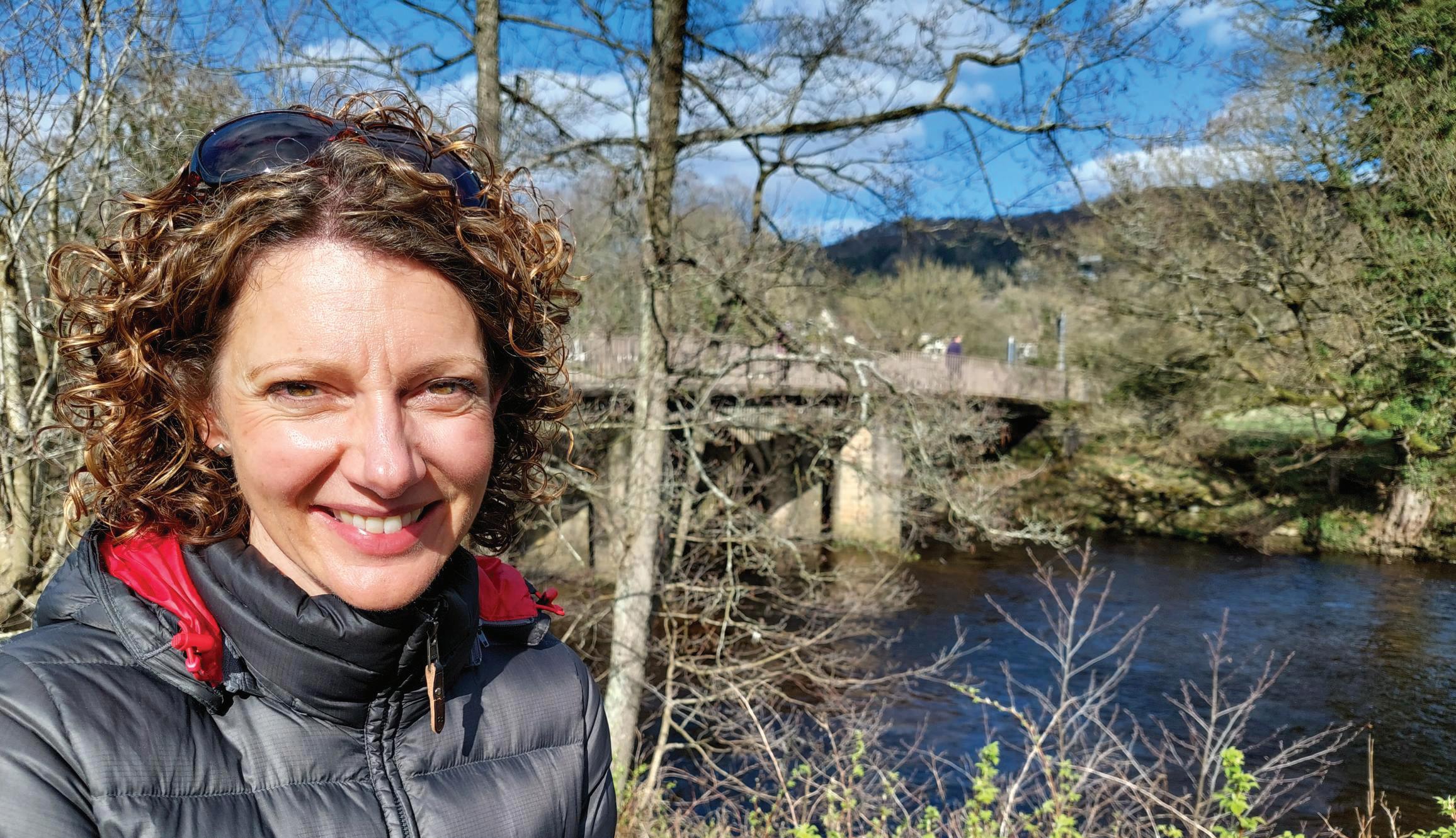
Ahead of Flood & Coast 2023, we catch up with two speakers who’ll be chairing panel discussions across the three-day conference. As CIWEM members, they have shared with us their experience working in the flood and coastal risk management sector. Find out what wicked problems are local to them and the solutions they would love to implement
JACOBS DIRECTOR, HEAD OF WATER CATCHMENT MANAGEMENT AMY BENTLEY MCIWEM C.WEM
FIND BENTLEY ON day one of the conference, chairing session three: understanding future risk and investment needs. Speakers will unpack how updating flood and coastal risk models enables us to adapt to a changing climate and invest in resilient infrastructure and communities. Bentley has 20 years of experience in flood-risk management, specialising in people, by supporting clients and teams to deliver successful outcomes. She has a BSc in geography, an MSc in catchment dynamics and management and is a chartered water and environmental manager.
WHAT DRIVES MY PASSION FOR THE SECTOR IS…
A real desire to protect and preserve our natural landscape for our current and future communities. I grew up near the Peak District and have always enjoyed being outdoors in the natural environment. I studied geography at university and spent a summer surveying the River Bollin in Cheshire to understand meander bend migration. I love understanding how our rivers and coasts shape our landscape and change over time.
WHAT INSPIRED ME TOWARDS A CAREER IN THE SECTOR WAS…
I was at university in autumn 2000 when much of the country experienced some of the worst flooding since 1974. I watched with interest how the Environment Agency
responded and what was put in place following this event. It sparked my interest in how floods are managed, planned for and forecasted. My dissertation for my MSc was focused on studying floodplain inundation on the River Aire in Yorkshire and looking at how 2D models could be used as a commercial modelling tool. This work involved engagement with the Environment Agency and my interest in the sector continued to grow. A careers talk at university then inspired me to apply for a graduate position with Halcrow and, as they say, the rest is history.
THE MOST EXCITING PART OF MY CAREER IS…
That’s really hard to answer, as there have been many, and hopefully many more to come. I would have to say the nine years I worked in Australia stands out. I was lucky to work on a great mix of projects that took me on many travels around the country, and far too many trips on small, bumpy planes.
The most exciting parts were meeting local stakeholders who lived and worked in the riverine environments we were
44 CIWEM News
Jacobs water-catchment expert Amy Bentley

working on. In the rural areas, the rivers were often described by the local people as the lifeblood of the community. I learnt a lot about the need to adapt to the changing environments, both extremes of flooding and droughts, and the importance of really listening to what people want and need. Being able to engage with the communities and then build this into work was hugely satisfying.
MY ADVICE TO SOMEONE STARTING OUT IN THE SECTOR WOULD BE…
Be curious, ask lots of questions, approach everything with an open mind. Establish a network of professionals who will support you and be a positive advocate for you.
A WICKED PROBLEM IN MY FIELD OF WORK IS…
Being able to move at pace to respond to climate emergencies. I worry that our governance, policies and procedures do not allow us to be agile enough to accelerate solutions such as nature-based solutions and blue-carbon initiatives.
A WICKED SOLUTION I WOULD LOVE TO IMPLEMENT IS…
I am convinced that we would save so much time if we could lock a working group in a room for three days – like a solutions boot camp. The right people with the right responsibility making informed decisions quickly.
THE RIVERS TRUST DIRECTOR OF COMMUNICATIONS AND ADVOCACY TESSA WARDLEY MCIWEM
Find Wardley on day two of the conference, chairing session three: delivering naturebased solutions. Speakers will share examples of innovative and partnership delivery leading the way in mainstreaming nature-based solutions.
Wardley has more than 25 years of experience in policy, communications and advocacy, specialising in marine and freshwater ecology. She has a BSc in marine biology, an MSc in water resources management and is a chartered water and environmental Manager.

WHAT DRIVES MY PASSION FOR THE SECTOR IS…
I love being around, in and on water and am fascinated by the science and art it inspires. No matter where you are in the world, water is at the centre of all life. All our civilisations developed around water. The natural wonders of the world exist because of water. For me, the water environment is endlessly inspiring and beautiful.
WHAT INSPIRED ME TOWARDS A CAREER IN THE SECTOR WAS…
I was inspired by the variety of careers possible, and the wonderful people engaged in the water sector.
THE MOST EXCITING PART OF MY CAREER IS… The water environment is at the core of potential solutions to the climate and biodiversity crises. It feels important to be able to do what I can to communicate and translate complexity into clear stories that illustrate the opportunities we have, to be part of the solution.
MY ADVICE TO SOMEONE STARTING OUT IN THE SECTOR WOULD BE…
Talk to as many people as you can, listen and learn, and take opportunities when they arise. You never know where life will take you. It’s an adventure, enjoy the ride.
A WICKED PROBLEM IN MY FIELD OF WORK IS… Wicked problems exist at a lot of scales and across many aspects in the water sector. In my current role, in communications and advocacy, most of the challenges exist around translating complexities into clear messaging. We must paint pictures, tell stories and present solutions to non-specialists so they get that “aha” moment.
A WICKED SOLUTION I WOULD LOVE TO IMPLEMENT IS…
I think that the solutions to our current problems lie in strong systems where funding can be crowded in to support collaborative working. This would implement catchment solutions appropriate to the local conditions. o
45 CIWEM News is edited by Chloe Goode
C.WEM
The Rivers Trusts’ Tessa Wardley

Businesses and organisations of all kinds must evolve to contribute to the global transition to a sustainable economy. CIWEM works in partnership to develop the skills your organisation needs to position your business as a responsible and sustainable operation. Our business partners are committed to environmental best practice, safeguarding the health of people and nature for current and future generations. A partnership with CIWEM is a powerful demonstration of this commitment.
to find out how partnership with CIWEM can benefit your business PROFESSIONAL | RESPONSIBLE | SUSTAINABLE
Email jane.boland@ciwem.org
BUSINESS PARTNERS jane.boland@ciwem.org www.ciwem.org/business-partners
MEET THE TEAM: CIWEM’S RIVERS AND COASTAL GROUP
The CIWEM Rivers and Coastal Group (RCG) supports CIWEM’s aim to be the leading professional body for sustainable management of the rivers and coastal environment. Here, some members of the RCG committee introduce themselves and explain what drives their passion for rivers and coasts
THE RCG PROVIDES a space for professionals to influence policies, share knowledge and improve management of the physical, environmental and social elements of rivers and the coast. The RCG has more than 1,500 members globally. Its committee has 17 members who come from diverse backgrounds.
IMMEDIATE PAST CHAIR ENVIRONMENT AGENCY PROGRAMME MANAGER TOBY WILLIS CENG CENV MCIWEM C.WEM

MY SPECIALIST AREA IS… Delivering flood-risk management and environmental programmes and projects. I knew I wanted to be a civil engineer from the age of 15 and found rivers and coastal after my hydrology masters.
After graduating, I gained experience with engineering consultancies in sewerage and rivers and coasts, then joined the Environment Agency. I lead a team developing the delivery programme for the Thames Estuary for 2025-2040.
I’m also an area duty manager, providing strategic leadership during a flood or environmental incident response. It’s a great opportunity to step outside of my role and make a huge and immediate difference to people’s lives. It can be quite pressured but that’s part of the fun.
I’ve been a member of the RCG committee for many years and chaired the group last year – I’m in my final year.
WHAT DRIVES MY PASSION FOR RIVERS AND COASTS IS…
I’ve found a role where I can genuinely make a positive difference for people and the environment. I get to meet communities that have been transformed by my work. That makes me really proud.
CHAIR

MOTT MACDONALD ASSOCIATE GEOMORPHOLOGIST
JOANNE BARLOW
MCIWEM C.WEM
CENV CSCI
MY SPECIALIST AREA IS…
Flood risk, river restoration and infrastructure. Over 20 years, my career has evolved from the river-habitat survey team at the Environment Agency to working as a fluvial geomorphologist in environmental and engineering consultancy.
Early in my career, I worked with Dr Andrew Brookes, one of the first applied river geomorphologists working in the UK. The arrival of the European Union Water Framework Directive in the mid-2000s really led to the growth of applied river geomorphology and sustainable management of river catchments.
I joined CIWEM’s North West and North Wales Branch and now the RCG, which I chair. I’m particularly keen to inspire and support young people to see the value in a career in the sector and to show the vital relevance of rivers and the coast to the ecological and climate emergencies.
WHAT DRIVES MY PASSION FOR RIVERS AND COASTS IS…
I always enjoyed studying geography. I followed pathways in river and coastal forms, dynamics and management. I was inspired by lectures by Professor Colin Thorne, who worked on major rivers in the US and Bangladesh that undergo huge geomorphological change.
Our UK rivers are less dynamic than the Mississippi or Brahmaputra, but there are still many occasions where understanding the behaviour of rivers and coasts can help us to better manage the risks and consequences of interventions. There’s a risk, when they play a huge role in our lives, that we take these environments for granted.
I always feel better after time spent by a river or at the coast and enjoy an occasional wild swimming adventure.
VICE-CHAIR
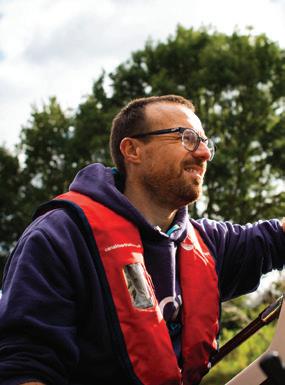
MILESTONE ENVIRONMENTAL DIRECTOR DAVID MOULD MCIWEM C.WEM CENV
MY SPECIALIST AREA IS… Wetlands and their interaction with hydro ecology, as a hydrologist. Since starting my company, Milestone, I’ve developed many other business skills, such as marketing, financial management, project management and, something I enjoy most, bringing together the different disciplines we offer.
I studied BSc geography, and after working as a hydrometrist at UKCEH for a year, completed a PhD in wetland hydrology. I love working with and observing water, understanding how the landscape functions. I’ve also been inspired by time spent outside and from reading Aldo Leopold.
I worked in consultancy, in flood
47 CIWEM News
modelling and hydropower, and then for the Canal & River Trust for ten years. I now enjoy the flexibility of running a small company. I’ve been an RCG committee member for several years and will chair next year. It’s great fun. We enjoy not just the pub visits after meetings but organising CPD events, supporting new members and promoting hydrology.
WHAT DRIVES MY PASSION FOR RIVERS AND COASTS IS…
The challenge of working out how water is functioning in the landscape, and how to make it work for habitats in wetland environments. Even better where there is an industrial legacy, heritage value or other varied complications that make the puzzle interesting.
I love being part of a multi-disciplinary team and finding creative solutions. When I’m not working, you’ll find me out on my bike in the hills, on a boat on the Thames, or watching my boys rowing. I’m involved in scouting and love to provide inclusive opportunities for kids to learn about being practical outdoors.
JUNIOR VICE-CHAIR

ATKINS FLOOD-RISK ASSOCIATE
PETER O’FLAHERTY MY SPECIALIST AREA IS…
Flood-risk assessment, primarily through hydraulic modelling of watercourses. I’ve been in the UK flood risk industry for ten years. It’s changed so much since I started. When I studied my masters in geological and environmental hazards, I was exposed to volcanology and seismology too. But it was flood risk that really captured my attention and imagination.
Flood risk is a very prominent part of life in the UK and a particularly devastating flood in Tewkesbury captured my attention in the lead-up to my studies. That inspired me to dedicate my career to understanding flood risk, particularly on rivers. I found my home in CIWEM shortly after starting in the industry and particularly the RCG.
This is my fourth year on the committee. As junior vice-chair I have a
particular focus on communications and am leading our strategy to seek better two-way engagement with our members, to share knowledge across our network.
WHAT DRIVES MY PASSION FOR RIVERS AND COASTS IS…
Wanting to better protect people from flooding and to safeguard these wonderful assets for generations to come. The UK is an island nation – many of our major settlements stand on rivers and the coast, which is fundamental to our heritage.
I enjoy playing a part in enhancing the UK’s rivers and coasts. When I’m not working, you’ll find me kayaking down the rivers of London and Kent.
HONORARY SECRETARY LLOYDS BANKING GROUP (LBG) SENIOR FLOOD RISK ANALYST HANNAH

LEWIS, NEE COOPER
MY SPECIALIST
AREA IS… Floodrisk assessment and interpretation of flood catastrophe models for insurance purposes. I’ve been working in flood risk for six years, mostly as a hydraulic modeller supporting the Environment Agency and Lead Local Flood Authorities to map their flood risk.
I’ve recently moved into flood-risk insurance and work for the largest UK home insurer. My focus still relies on understanding flooding mechanisms and risk, but on a regional scale. I help LBG to understand the wider view of flood risk and how this risk should be seeded to FloodRe.
I support our flood-claims teams during flood events to ensure staff are available to assist customers when flooding occurs, explaining where and when a flood event will affect a community.
I joined CIWEM early in my career by attending an RCG study weekend in Cumbria. After networking with the team, I found myself organising the following study weekend. My highlight was organising a study weekend to the Netherlands. We visited Maeslantkering, the largest movable storm-surge barrier. As committee secretary, I support event planning and study days.
WHAT DRIVES MY PASSION FOR RIVERS AND COASTS IS…
Wanting to protect rivers and coasts for future generations. Having recently obtained my Advanced Open Water PADI scuba diving certification, I’m keen to explore more coastal environments, observing the wildlife that lives there. I’m also passionate about ensuring everyone has a right to flood protection, whether flood defences or affordable home insurance.
TREASURER
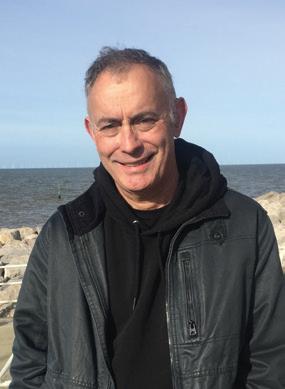
WATERCO FLOODRISK AND DRAINAGE DIRECTOR MIKE
WELLINGTON
MY SPECIALIST
AREA IS…
Flood-risk management, working as a civil engineer promoting schemes from inception to commissioning. I take projects through the funding and business-case procedure to design and construction on site in both fluvial and coastal environments.
I address risk management in project delivery, including construction, design and maintenance compliance, and commercially through project governance and contract management. I’ve worked in the industry for 35 years, starting my career in local government working on flooding, private drainage, public sewerage systems, land drainage and flood and coastal erosion risk management (FCERM).
In 2000, I witnessed flooding in North Wales and the devastation it caused to communities. I now work in the private sector delivering FCERM projects for local authorities and floodrisk assessments, and mitigation for developer clients. I’ve been a member of the Welsh government Flood and Coastal Erosion Committee since 2019.
WHAT DRIVES MY PASSION FOR RIVERS AND COASTS IS…
Living on the North Wales coast and witnessing tidal storms from the Irish Sea in the winter months, compared with the tranquillity of the coastal environment in the summer months. I’m passionate about promoting the sector
48
to the next generation. I deliver STEM activities in schools and am a visiting lecturer in local universities.
I enjoy coastal walks witnessing the terns, cormorants, oystercatchers and sand lizards that inhabit the dunes and estuarine and coastal waters where the river Clwyd meets the Irish Sea.
ORDINARY COMMITTEE MEMBER

BINNIES REGIONAL DELIVERY MANAGER
ALEX HUMPHREYS
MY SPECIALIST AREA IS… River engineering. I’ve been working in the sector for more than 20 years and have developed a specialism in fish passes, weir removals, river restoration, Water Framework Directive (WFD)-related projects and scour risk management.
WHAT DRIVES MY PASSION FOR RIVERS AND COASTS IS…
My interest in hydraulic engineering, a key part of my civil engineering studies. My first projects as a graduate engineer were designing fish passes for the Environment Agency. This was an excellent opportunity to get stuck into hydraulic analysis.
I learned so much about the application of hydraulic design principles, solving challenges that river environments often present to those working in it. That led me to broader river-restoration and WFDdriven projects that required much more of a balance of traditional engineering and emerging nature-based solutions.
It is this blend of engineering and working with natural processes that drew me to get involved with CIWEM. I’m looking forward to being part of the RCG, sharing knowledge and experience to address the current challenges we face to save our rivers. o
Join the RCG at www.ciwem.org/ special-interest-groups/rivers-andcoastal-group and on LinkedIn, where we share industry news and thoughtprovoking pieces. You can come and say hi to us at the Flood & Coast conference in June.
MEET OUR MEMBERS: FOLA OGUNYOYE
Environmental engineer Fola Ogunyoye FCIWEM C.WEM
CEng is improving lives by delivering sustainable solutions to communities impacted by flooding and climate. Chloe Goode interviewed him
FOLA OGUNYOYE HAS more than 30 years’ experience in flood-risk management, has been involved with CIWEM’s Rivers and Coast Group and sits on CIWEM’s Flooding and Coastal Erosion Risk Management panel.
TELL US WHAT YOU DO
I am the director of TJAY Consulting. I carry out studies and deliver solutions that help communities and infrastructure reduce their impacts from, adapt and become more resilient to flood risk and climate impacts.
I #ENGINEERBETTERLIVES BY…
Working with natural processes to deliver multiple benefits and multi-
WHAT’S THE MOST EXCITING ENGINEERING PROJECT YOU HAVE WORKED ON?
Lamb Drove housing development in Cambourne. I was the project director for retrofitting sustainable drainage systems (SuDS) and property flood resilience into the design. Its legacy was a Royal Town Planning Institute award for climate resilience and monitoring results that showcase SuDS’ multiple benefits, at a time when SuDS was not widely accepted or government policy.
WHAT’S IT LIKE TO BE AN ENGINEER?
An engineer is an enabler, making society function and thrive. It is very rewarding as we get direct feedback from seeing our work enhancing people, places and the environment.

I’m proud of the profession because, time and time again, we address seemingly impossible global and local challenges with sustainable solutions. o
CIWEM offers three Engineering Council registrations that you can apply for alongside a Chartered member application. Find out more about our engineering registrations at: www.ciwem. org/membership/additionalregistrations.
49 CIWEM News Do you have a CIWEM membership story to share? Contact the content team via chloe.goode@ciwem.org
ENVIRONMENTAL CONSULTANCY, DESIGN AND CONTRACTING

Land & Water
0844 225 1958
enquiries@land-water.co.uk
www.land-water.co.uk
Weston Yard, Albury, Guildford GU5 9AF
PROPERTY FLOOD RESILIENCE MANAGEMENT AND SOLUTION PROVIDERS

Watertight 0800 093 3463 enquiries@watertightinternational.com www.watertightint.com
DELIVERING SUCCESS
MODELLING AND CONSULTANCY FOR COASTAL AND ESTUARINE ENVIRONMENTS
Coastal Science Ltd 01395 578049
phil@coastalscience.co.uk
www.coastalscience.co.uk Devon, UK
HYDROLOGY & ENVIRONMENTAL SCIENCE TRAINING COURSES

FLOOD REINSURANCE Flood Re information@floodre.co.uk www.floodre.co.uk


UK Centre for Ecology & Hydrology +44 (0)1491 838800
UKCEHtraining@ceh.ac.uk

As a trusted UK water and wastewater technology manufacturer with a strong civils support team, Marsh Civils can help you and your team deliver project success.
MANUFACTURER OF FLOOD RESILIENCE PRODUCT
GreenBlue Urban Ltd 01580 830800 hello@greenblue.com

www.marshcivils.co.uk
ICS Consulting provide innovative and leading-edge solutions to our clients. Our tools and processes are at the forefront of investment decision making and are used by companies operating in an asset rich environment where balancing cost, risk and performance is challenging. We develop end to end solutions, integrating customer and stakeholder needs with asset understanding to enable our clients to produce balanced, well-evidenced investment and delivery plans. Our multi-disciplinary team includes economists, market researchers, asset managers, engineers, IT developers and data modellers / analysts.
+44 (0) 1977 621188
info@icsconsulting.co.uk
www.icsconsulting.co.uk

To


PRODUCTS AND SERVICES
ensure your company is included in this guide please email: ciwem@syonmedia.com or telephone Lee on 0203 900 0102
WANT TO HIRE THE BEST WATER & ENVIRONMENTAL jobs CIWEMJOBS.COM ciwemjobs@syonmedia.com 0208 332 8416 Start recruiting the best by contacting us at: Untitled-1 1 05/04/2022
MEET THE TEAM
Two new faces joined CIWEM’s membership team this spring – here to support your chartership journey and professional development

TELL US WHAT YOU’RE DOING AT CIWEM
I work in the membership team processing applications and membership queries for MCIWEM and CEng applications.
TELL US A BIT ABOUT YOURSELF
I graduated in philosophy and sociology from the University of York. Then I spent two months working in Bergen, Norway as a social volunteer in a hostel, running hikes and activities for the guests.
WHO INSPIRES YOU?
People from a wide range of disciplines; artists, scientists or writers who devote themselves to their craft, live through their passion and love their field. I’m also motivated by people who work to bring a better future for us all, environmental or social.
WHY DO YOU ENJOY WORKING FOR CIWEM?
The highlight is undoubtedly the people, team and members. Everyone is friendly and ambitious in working together to produce the best experience for our members, community and the wider public.
IN MY SPARE TIME, YOU’LL FIND ME... Going to gigs. I also enjoy cooking at home and trying new cuisines; any vegetarian restaurant recommendations appreciated. I’m a keen photographer and take my camera everywhere I go. o
Connect with me on LinkedIn: www.linkedin.com/in/myleswoodruff-371683200/

CIWEM MEMBERSHIPSERVICES OFFICER BLANCA VASY DE LA CRUZ
TELL US WHAT YOU’RE DOING AT CIWEM I’m the first point of contact for member queries, involved in recruitment, retention and stewardship of members. I manage member records and process applications across all grades.
TELL US A BIT ABOUT YOURSELF
I grew up in Spain and moved to London as a teenager. I am a UCL history graduate and am very interested in sustainability. We must all respect nature and look after the planet. I love doing yoga, working out and eating delicious vegan food.
WHY DO YOU ENJOY WORKING FOR CIWEM?
Looking after the environment is one of the most important things we should do. I love that CIWEM is committed to promoting and enabling this. I enjoy working with my colleagues. I am happy to be part of such an inspiring and hardworking team.
IN MY SPARE TIME, YOU’LL FIND ME… Meeting up with friends, reading a good book in a park, or trying to teach myself a new skill. o
Connect with me on LinkedIn: www.linkedin.com/in/blancavasy-de-la-cruz-b89278240/
51 CIWEM News
CIWEM REGISTRATIONS OFFICER MYLES WOODRUFF



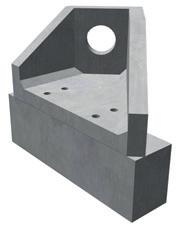










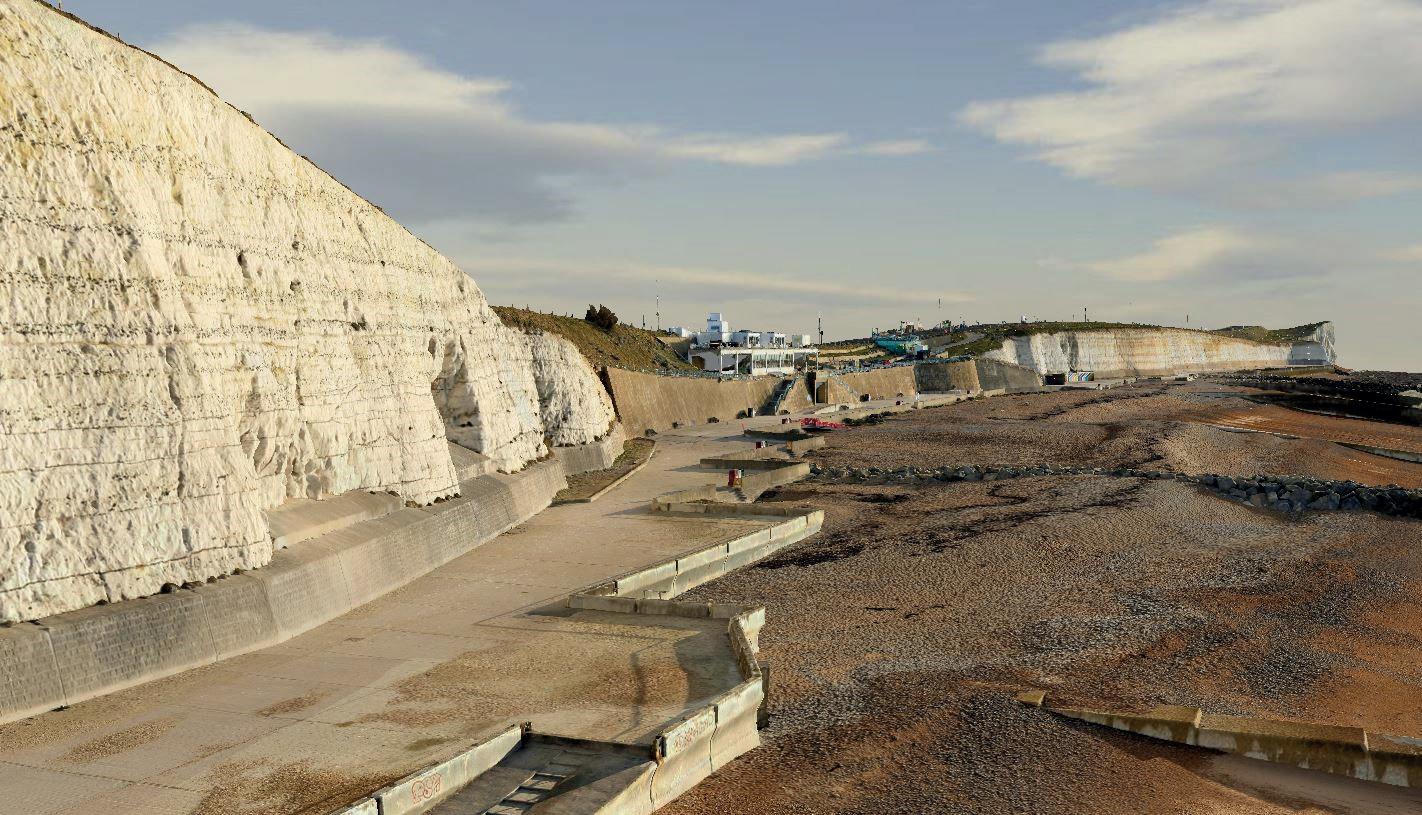

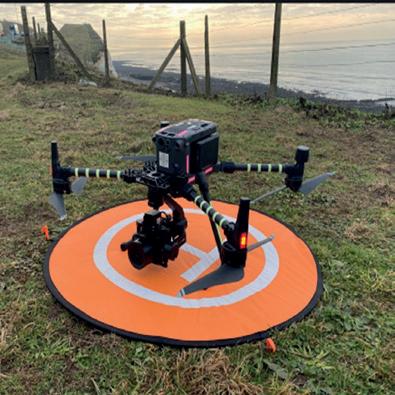






Surveying Excellence in THE WATER ENVIRONMENT www.maltbysurveys.com 01444 416246 contact@maltbysurveys.com Channel Section Surveys Topographic Surveys Bathymetric Surveys Flood Defence Surveys GNSS including Network Design Post Flood Surveys Property Threshold Surveys Monitoring Surveys Flood Plain / Beach Profiling Volume Calculations for Dredging 3D Modelling - Utilising Drone, Echo Sounding and Laser Scanning All surveys to the current RICS & Environment Agency Specification All staff RYA Powerboat & DEFRA Flood & Swiftwater Rescue trained USING LATEST DRONE TECHNOLOGY Headwalls Alton Precast Outfall Structures Alton fitted headwall accessories include: Flap Valves Handrails Steps & Ladders Penstocks Gratings Dissipation Blocks www.althon.co.uk E: sales@althon.co.uk | T: 01603 488700 Looking to make a splash in your next role? Weetwood, a leading, independent flood risk and drainage consultancy firm, has opportunities for passionate and motivated flood risk consultants with a range of experience. We undertake flood risk and consequences assessments, prepare drainage schemes, undertake sequential and justification assessments, prepare flood warning and evacuation plans, undertake Environmental Impact Assessments, and much more We operate across the UK for a wide range of exciting development projects and for some great clients Our team includes flood risk consultants, drainage engineers, hydrologists and hydraulic modellers If you fancy a new challenge and would like to know more about the work that we do, please get in touch with Kevin Tilford (kevin tilford@weetwood net) or take a look at our website www.weetwood.net We look forward to hearing from you! MEASURE – UNDERSTAND – INNOVATE Our large team of Defra II water safety qualified geospatial river surveyors have upskilled to carry out River Condition Assessments (RCA). We get in the water and capture meticulous riverbed and bank details to improve the integrity of your RCA score. www.storm-geomatics.com Tel: 01608 664910 | Email: mike.hopkins@storm-geomatics.com
CIWEM News
WHAT STOPS WOMEN MENTORING?
WOMEN CAN BENEFIT from mentoring and from being mentors. So why aren’t more women engaging in mentoring relationships? Chloe Goode asked mentors from CIWEM and Women in FCERM about their own barriers and thoughts about what stops women mentoring others

ENVIRONMENT AGENCY PROGRAMME SPECIALIST AND CIWEM MENTOR
CLARE RODGERS
FCIWEM C.WEM
CENV CSCI
I knew that my availability might be a barrier. I have two young children and work part time. I found the CIWEM mentoring platform flexible enough that I could manage the number of mentees I had, to get the balance right.
The best challenge has been when discussions have broadened from questions about CIWEM applications to wider topics: work-life balance, career breaks and job applications. It really pushed me out of my comfort zone and developed my active listening skills.
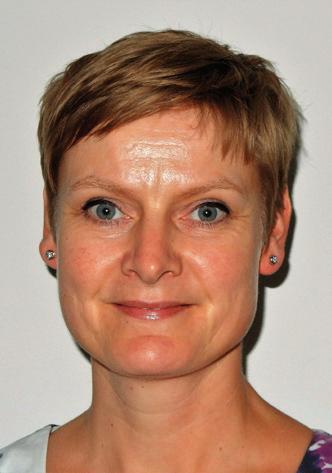
ENVIRONMENT AGENCY COMMUNITYRESILIENCE ADVISOR AND CIWEM MENTOR
EMMA THOMSON
MCIWEM C.WEM
C.ENV
What on earth can anyone learn from me? That was my initial reaction; it did hold me back in earlier days.
My first experience mentoring was when a colleague asked me to mentor them. I was surprised but realised I’m not the best judge of how useful I can be. Whatever our situation, it’s likely we’ve done, succeeded or got wrong something others can learn from.
Mentoring well is a commitment, so
time is a challenge, but the rewards make it worthwhile. I’ve learned to recognise I’m not the perfect mentor for everyone. Experience has taught me that some mentees need help or experience I can’t provide.

ENVIRONMENT AGENCY PSO TEAM LEADER AND CIWEM MENTOR NICOLA HYSLOP FCIWEM C.WEM CENV CSCI
The initial barriers were external pressures, time commitment and whether I would be a suitable mentor. I talked to colleagues who were mentors and my own mentor and undertook CIWEM mentor training. The barriers I had perceived soon diminished.
Every mentee has different expectations and the first challenge, as a mentor, is to find the right approach for mentees, so discussions can be effective. Each relationship has a time commitment, so I limit the number of people I mentor at any one time.

ARCADIS SENIOR LEADER AND WOMEN IN FCERM MENTOR DEBORAH NUTT
The self-doubt – I’m not good enough, why would anyone want to listen to me – can often be a barrier. This selfdoubt exists in us all, regardless of level in an organisation. Overcoming that personal barrier is harder for some than others.
Once we realise that we all have something valuable to give, to support others’ career journeys, we can start to have the confidence to mentor. The more you do it and see the impact, the easier it gets.
Mentoring can be something we put at the bottom of to-do lists, behind family and work commitments, or overlook unintentionally. Finding the time to stop and breathe gives us a chance to realise that mentoring can make such a big difference.

ENVIRONMENT AGENCY FLOOD HYDROLOGY
SENIOR TEAM LEADER AND WOMEN IN FCERM MENTOR TREVOR BOND
Something I’ve heard a lot is that “nobody would be interested in my story”. Some women think they don’t have anything to offer as mentors or that their experience isn’t worthy enough. We need to celebrate women’s achievements and empower them to recognise their value as role models and leaders.

JBA CONSULTING FLOOD RISK
ANALYST AND WOMEN IN FCERM MENTOR MEGAN FOTHERGILL
I feared that I wasn’t qualified enough to mentor; that what I had to contribute wasn’t valuable. I’ve learned from mentoring that it seems to be a very common feeling among women in the workplace.
CIWEM’s mentor platform helps you to find the mentor relationship you need. o
Become a mentee or mentor: www. ciwem.org/membership/mentoring. Women in FCERM connects, supports and empowers women across the flood and coastal risk management sector: www.womeninfcerm.org.
Join Women in FCERM’s Embracing Equity networking event at this year’s Flood & Coast conference
53
FLOOD & COAST 2023 –COLLABORATING WITH CONVICTION

The impacts of climate change on water, human life and nature are becoming ever more apparent around the world. This reinforces CIWEM’s long-held belief that we must consider our relationship with water in all its guises, writes
Terry Fuller
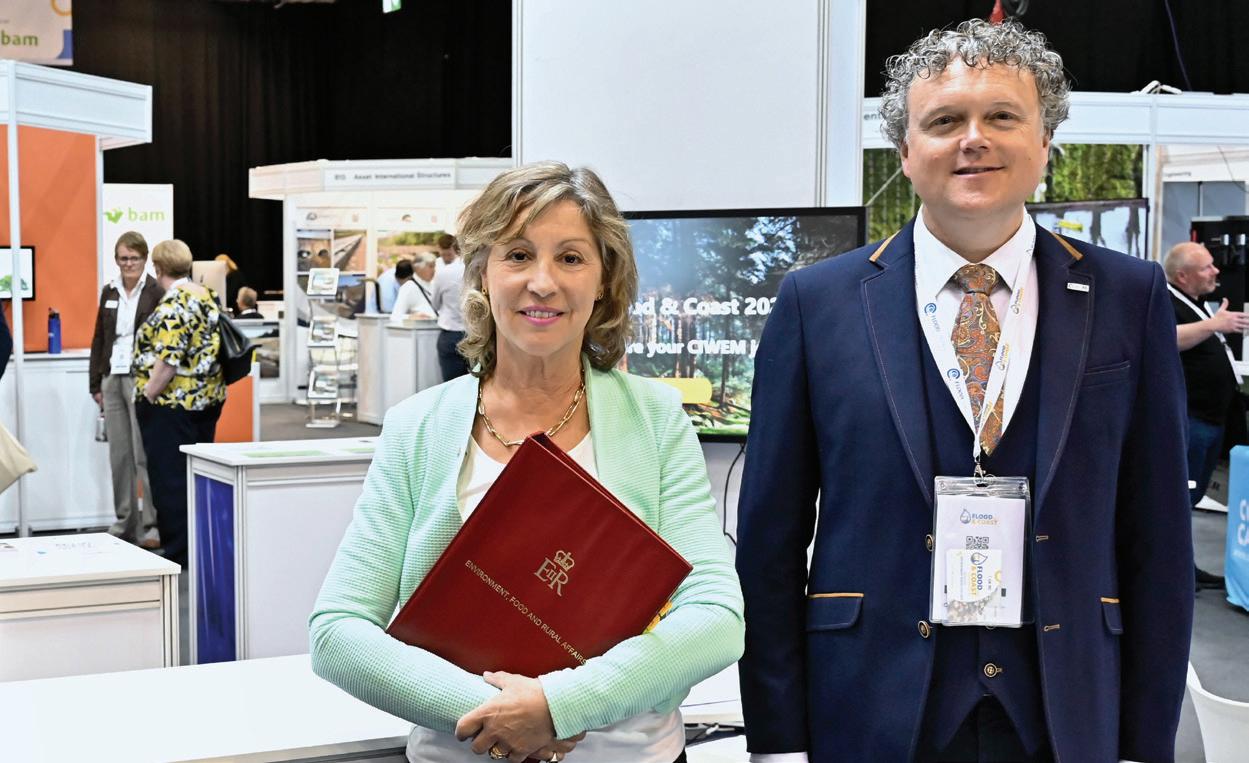
THIS SPRING, CALIFORNIA moved from severe drought to 12 climatic extremes of rainfall, snowfall and melt, causing widespread devastation. In New Zealand, where CIWEM has an expanding branch, severe weather has caused flooding, landslip and damage to critical infrastructure.
At the same time, in the UK, more insidious impacts have started to attract publicity. In March, coastal erosion in East Anglia led to abandonment of homes and prompted fresh discussion about the future viability of coastal communities.
More than ever, the flood family needs to come together to find and share solutions to help the people and communities being affected today, while bringing widespread benefits for the future of our planet.
Funding supports that progress. We must resolve how to support the places most in need. Yes, we need more funding, but what concerns CIWEM is how challenging risk-management authorities can find it to apply for that support; it demands navigating complex mechanisms and that don’t readily fit their circumstances.
We need innovative ways to finance flood and erosion risk management. Can those who benefit from nature-based solutions beyond flood risk help to foot the bill? How might the majority of the UK population who don’t live or work on the coast support those who do, to preserve an environment that so many of us benefit from?
Flood & Coast is one part of CIWEM’s overall programme to address flood and coastal risk, albeit a very significant part. Under the leadership of our policy team, FCERM specialist panel and the Rivers and Coastal and Urban Drainage groups, we have identified areas of high priority.
Away from the big capital schemes, priorities to address include how to maintain existing flood and erosion risk-management assets. Lack of resources, skills and revenue funding increases risk.
Natural flood management will feature highly across the Flood & Coast programme yet again. CIWEM’s FCERM panel has highlighted concerns over access to funding. It is pressing for more co-ordinated approaches that could allow a pooling of schemes’ funding. Many of
the people who can make that happen will be in the room in Telford.
Our specialists have highlighted a shift in thinking, from risk reduction to resilience, and identified the enablers –the funding mechanisms, appraisal methods and outcome measures – that will need to change.
But taking a fresh approach also means we must reach wider audiences, which is why CIWEM has worked to broaden attendance at this year’s Flood & Coast. CIWEM has worked for the first time with three strategic partners – the Environment Agency, the Rivers Trust and the Association of SuDS Authorities – to shape the conference programme.
That programme focuses on wicked problems and solutions – CIWEM’s president’s theme this year. It brings in new voices and fresh perspectives, from engineers and consultants through to local authorities and community groups.
As a flood family, we have the tools we need to make real change – but we must also welcome in new members. So many people have not been in the room, or have been under-represented, in the past – especially local authorities and at-risk communities.
Our strategic partners are helping us to address this, alongside targeted communications by the CIWEM team.
If you’ve attended Flood & Coast before, we hope you feel a difference this year. Please support us by seeking out newcomers and extending a warm welcome to everyone in our flood family.
One of CIWEM’s principles is to collaborate with conviction. Three days together in Telford will help us on that journey. I look forward to being there with you. o
Terry Fuller is chief executive of CIWEM
54
LAST WORD
Terry Fuller will again welcome minister Rebecca Pow to this year’s Flood & Coast

You’ve got to hand it to Wavin AquaCell NG
Fast, safe and sustainable attenuation tank installation
Innovation comes to attenuation, helping contractors, civil engineers and installers to meet the challenges of surface water management.
• Modular configuration meets the needs of all application areas
• Integrated connectors easily join units together to create a stable tank, without the need for clips, pegs or tools
• Space saving, nested design frees up ground on site, reduces deliveries and reduces the carbon footprint of those deliveries
• Inspectable, cleanable and adoptable
• BBA approved
AquaCell NG
Next Generation attenuation

100% recycled plastic
3x faster to install than previous generation wavin.co.uk/nextgen
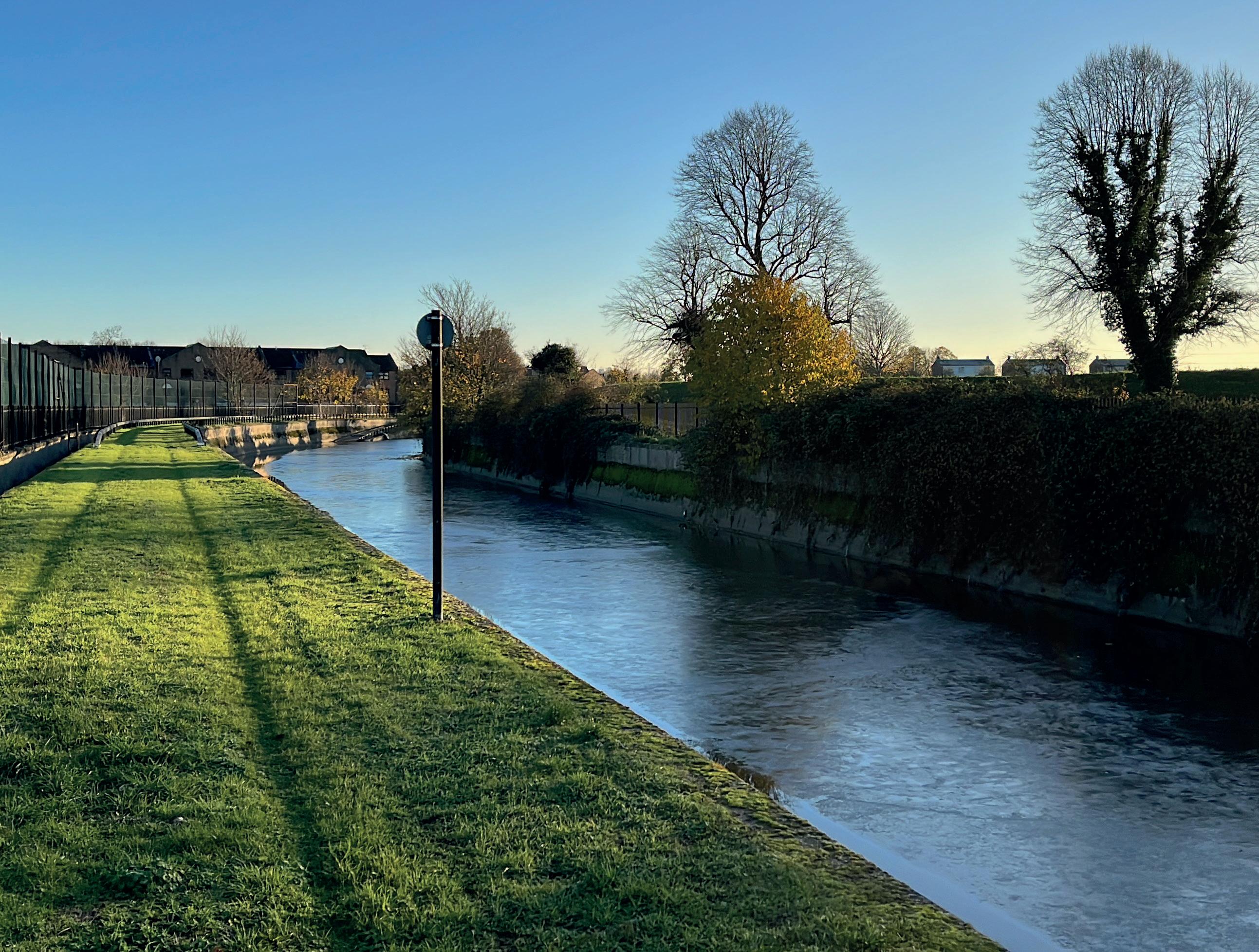
watermanaspen.co.uk Engineering specialist secondments Right people, right place, right time From major strategic projects to smaller scale local schemes requiring specialist support. Visit us on stand C18 at Flood & Coast.
















 Karen Thomas Editor, The Environment @KT_environment
Karen Thomas Editor, The Environment @KT_environment










































































































































